- Skip to primary navigation
- Skip to main content
- Skip to primary sidebar
- Skip to footer
Yacht Cruising Lifestyle
Everything fun you can do from your yacht

Boat Restoration Tips, Tricks, and Costs
August 29, 2021 by Martin Parker 6 Comments
Are you considering boat restoration as a cheap way to get on the water? While restoring a tired boat can save you money if you do most of the work yourself, there is a lot to consider and plan for if the costs are not to get out of hand.
Restoring a boat is a labor of love and something you are not likely to take on unless the boat concerned has some special meaning for you or you’re trying to save money. It is vital to understand that boats do not generally appreciate value unless they have some historical significance. Unlike car restoration, where collectors will pay big money for classic cars, the same is not true in the yachting world.
Don’t let that put you off, though. Bringing a boat back to pristine condition is hugely satisfying and something to be proud of.
Step-By-Step Process of Boat Restoration
Do You Need a Survey Before Commiting to Boat Restoration?
If you’ve recently purchased a boat, then you should have had a survey carried out already. If this is a boat you’ve owned for a while and intend to restore it, then a survey could be a good idea before you start. There are different types of surveys available, but the most common is the condition and value survey. The surveyor assesses the boat’s overall condition, reports any problems, and gives a market valuation.
You may need specialized surveys for the engine and other systems, and you can find accredited surveyors on the NAMSGLobal website or the Society of Accredited Marine Surveyors .
Clean the Boat Thoroughly
While it may seem an odd suggestion, thoroughly cleaning the boat has a practical purpose. While cleaning your boat, you can spot any problems you may have missed previously. Cleaning also gives you a base standard to start from and will save you time in the long run. Unblock all the drainage holes, thoroughly clean the bilge, and lift any hull access points to clean and inspect.
List Broken Items
Making a list of parts that need replacing or repairing is vital. Some areas of the boat will only be accessible during the restoration. Suddenly remembering a component that you needed to replace when the restoration is complete is not great! Completing this step enables you to plan the boat restoration in a logical order.
Check Any Through-Hull Fittings
Any fitting that penetrates the hull can potentially flood the boat, so these must be checked and repaired. All through-hull fittings use specialized sealants where they mate with the hull. Don’t skimp in this area, as you will regret it when the first leak appears.
Check the Seacocks Are Working
Seacocks have two purposes. Some are there to let water in, for engine cooling, for example, while others let water out, such as cockpit drains. In either case, it’s vital to ensure they are working correctly. The seacocks for cockpit drains and sinks etc., are usually closed at sea as the rolling movement of the boat can let water enter the hull. A seacock seized open has caused many boats to flood and sink.
Check the Condition of the Hull
What you are looking for will depend on the materials used to make the hull. A thorough inspection inside and out is required.
Fiberglass Hulls have a gel coat to protect the surface, but water may have penetrated the core if cracked and damaged. You can repair small areas of damage yourself, but extensive damage will need a professional eye. Pay particular attention to any fittings, such as cleats, stanchions, and chainplates, as cracking often occurs here. On older boats, the gel coat may have faded and stained. As long as the surface is good, you can restore it using a jetwash and readily available materials.
Wooden Hulls can suffer from rotten or dried-out wood if the protective coating is damaged. Repairing wooden hulls is a specialist skill that you shouldn’t attempt unless you are very confident. If the woodwork is sound, then resealing is a simple but time-consuming task.
The surveyor’s report should have highlighted all the damaged areas that he can see, but it depends on the type of survey you commissioned.
Check Load-Bearing Fixtures
Load-bearing fixtures such as cleats and chainplates put immense stress on the deck. Behind every load-bearing fixture, there should be a backing plate to spread the load and prevent damage. Make sure the backing plates are in place and in good condition.
Inspect Every Halyard, Sheet, or Control Line
The materials used in making halyards and sheets are very resistant to the damage caused by saltwater and the sun. But over time, they do weaken. Inspect all the lines carefully for any wear or fraying, and replace where necessary. Any lines in good condition can be washed in a very light non-bio detergent but ensure you rinse with plenty of fresh water.
Inspect Your Sails
Your sails work in a hostile environment, constantly exposed to UV light, saltwater, and extreme tension in heavy winds. Checking your sails during a restoration is a vital step to getting back on the water.
Check the following areas particularly:
Stitching: The sails stitching is the most common area affected by ultraviolet light from the sun. If you find anything, you should send the sail to a professional for repair.
Cringles: A cringle is stitched in to feed a sheet or line through at each attachment point. Check for damage to the metal or fraying of the stitching. Anything you spot here will most likely need professional attention from a sailmaker.
Sail Surface: Look out for fraying stitching, tears, and holes. Small holes can be repaired using repair tape or by sewing.
Sail Edges: Again, look out for fraying or loose stitching, but also signs of stretching.
Mold: Although mold won’t damage a sail, it looks unsightly, but luckily it is relatively easy to remove. Any sails that pass inspection should be thoroughly washed, dried, folded, and stored in a cool, dry location. Do not be tempted to put your sails away wet, as this encourages mold.
Engine: You can commission a separate survey for the engine, but if you have just lifted the boat out of the water to restore it, then a good service is probably the only thing required. For any boat that has been unused for a long time, it may be more economical to lift the engine out for a complete overhaul. Each situation will be different, and getting several quotes is a good idea.
If you decide to leave the engine in place, then at the very least do the following:
– Drain fuel tank
– Change engine oil
– Change gearbox oil
– Replace oil and air filters
Estimate the Cost of Boat Restoration
You’ve completed a complete survey of your boat, and it’s time to start the task of estimating the cost of the repairs. This is a critical stage and not one to rush. Finding the cost of replacement parts is relatively easy, so long as they are available. Older boats will be out of production, and the boatyard that built it may no longer be in business. A degree of improvisation and adapting similar parts may be required, which takes longer and costs more.
Many jobs may be labor-intensive, such as stripping back the Gelcoat or sanding down wooden decks. If you can do these jobs yourself, you’ll save a lot of dollars, but don’t exclude the cost of your time in the restoration cost. If you need to use skilled trades, then ask for quotes.
Once you’ve built a complete estimate of the cost of restoration, only you can decide if it’s feasible or not. If you hope to profit by selling the restored boat, this is a simple financial decision. A boat with some historical or sentimental value can make a choice more difficult.
Planning For Boat Restoration
Now you have a good idea of the costs involved, and you’ve decided to go ahead and embark on your boat restoration project. Congratulations! It’s probably going to be a long but worthwhile road ahead.
Take some time now to plan out the restoration in stages. You should complete some jobs before others, such as replacing damaged structural parts before relaying the deck. It’s also worth setting yourself some realistic deadlines to complete the stages. Not only is it something to aim for, but there is a sense of satisfaction as you complete stages. It sounds obvious, but it is easy to miss or forget something along the way if it’s not written down.
Boat Restoration Costs
Some people will say pick a number out of the air and then double it, and you’ll still be well under the final cost! There are so many factors to consider. If you are restoring a small boat, say 25 feet LOA, a conservative estimate might be $15,000 to $20,000. But as you discover more problems along the way, the final bill could be much higher. As the size of the boat increases, the cost increases exponentially.
The final cost will depend on how much needs doing and the quality of the work. We cannot emphasize enough the importance of a good inspection, cost estimate, and a well-thought-out plan.
As an example, you may buy a tired-looking 30-foot boat for $30,000. Add on around $25,000 for the restoration work carried out by skilled trades, plus $15,000 for your own time—a total cost of approximately $70,000. Compared to the price of a new 30-foot yacht of around $120,000, that’s quite a saving. On the flip side, the resale value of the restored boat may only be around $45,000. Having spent so much time, money, and effort on the restoration, you’re unlikely to sell any time soon.
Boat Restoration Tools
Apart from some specialist tools for specific jobs, you will need a good set of basic hand and power tools. When you are buying tools, it is better to buy quality rather than quantity. The cheap grocery store tool kit with 100 items for 20 bucks will not stand the test of time.
The best advice I ever got was to buy the quality tool you need when you need it, rather than trying to build a complete tool kit from the beginning with cheap items.
Boat Restoration Materials
The list below gives you an idea of the materials you may need to buy based on a 30-foot yacht. There will be more. Make sure you add these items to your estimate of costs.
Rigging: An older boat that needs restoring will most likely need some of the rigging replaced. If you don’t like heights, this is a job for professionals. Expect a cost of around $1000 to $1500.
Metalwork: Replacing broken cleats, chainplates, etc. Replacing the chainplates could cost a few hundred dollars if you do the work yourself or several thousand if you employ skilled trades.
Sails: Replacing any damaged sails and repairing where possible. For a new jib and mainsail, expect somewhere between $2,500 and $4,000
Halyards, Sheets, and Control Lines: Replace any that are past their useable life. Prices for rope can range between $2 to $10 per meter, depending on thickness and quality.
Engine: Replacing oils, fuel, and filters and renewing coolant hoses, fuel lines, and pump belts.
Batteries: Any yacht that has stood for a long time will probably need new batteries, but get them tested first.
Gelcoat Repair Kits and Polishing Tools, or Varnish for Wooden Hulls: Gelcoat can be bought in bulk if needed. Around $30 for a 1kg tin.
Winches and Blocks: After cleaning them with fresh water, check for smooth operation and service them. If you need to buy new winches, budget for at least $500 upwards for a self-tailing version.
Expert Help
Specialized expert help in the boating world is expensive. The more you can do yourself, the better, but include your labor cost in the final estimate. Qualified tradespeople may cost you more, but they will complete the job in a shorter time, getting you out of the yard and on to the water sooner. Experienced, skilled tradespeople can charge around $100 an hour for their services.
Boatyard Fees
Many people overlook the cost of storing your boat in the yard while the work is in progress. If you only work on your boat at weekends, it could be several years in the yard before you finish the restoration.
Continuing Costs
Owning a boat has continuing costs if you plan to maintain your restored yacht to the standard you’ve made it. We wrote an article covering the cost of boat ownership to help you know what to expect as a first-time boat owner.
Boat Restoration Tips and Tricks
When to Replace or Repair Yacht Components
A yacht operates in corrosive conditions of saltwater and sun, and particular items need regular checks and repairs. We’ve compiled a table below for the average lifespans of components, but many variables affect these estimates.
Component Expected Life Before Repair or Replacement
– Standing Rigging 10 years
– Sails 4,000 hours
– Halyards and Lines 5 to 10 years
– Engine (Diesel) 5,000 hours
– Mast Inspect and repair every five to six years depending on use
– Batteries 4 to 5 years
– Gelcoat 5 years
– Wooden deck stain Yearly
Do You Have the Skills for Boat Restoration?
Be very honest with yourself about your skills. Some jobs should be left to the professionals unless you are very confident. Electrics and the engine, for example, both require specialist skills.
Gelcoat Repairs
An older fiberglass boat will very likely have some Gelcoat damage, so how do you repair this? We have chosen three videos showing the standard method for gelcoat repairs.
The first Gelcoat repair video is from someone attempting it for the first time. Watching this video should help you to avoid some common mistakes. The repairer uses a patch paste kit that is available from most boatyards.
In this next video, we follow another Gelcoat repair, but this time mixing the Gelcoat by hand and repairing small cracks instead of a hole.
The last video on Gelcoat repairs focuses on spider cracks that are so common in fiberglass boats.
Buffing and Polishing the Hull of a Fiberglass Boat
You’ve repaired the Gelcoat and now need to bring back the lustrous shine that your boat had when it was new. Here are a couple of videos showing you how to buff and polish Gelcoat.
This method uses only polishing creams and buffing tools to restore the Gelcoat finish . An alternative approach is to start with 2000 grit sandpaper before using the buffing tools and rubbing compound to polish the Gelcoat .
Finally, this time-lapse video shows a complete boat restoration from start to finish , completed in an incredible six weeks.
Do you Need Certifications for Any of the Work?
There are no requirements to have your electrical or mechanical work certified for privately-owned pleasure boats that don’t take paying customers. However, your insurer may insist that a qualified person approves any work you have completed. We would suggest that it’s in your interest to have the work checked before you first launch your restored boat.
If you intend to use your boat commercially, then a whole set of regulations will apply.
Sell Your Boat or Restore It?
As we previously mentioned, restoring a boat is not going to make you a profit. But you’ll finish up with a boat that was cheaper than buying brand new. The decision between selling the boat and restoring it will depend on numerous factors.
– Does the boat have any sentimental value to you?
– Do you have the time and money to complete the restoration?
– Will you lose interest partway through the restoration? Be honest with yourself!
Only by answering those questions can you decide whether to sell or restore your boat.
Avoid Expensive Brand Name Products
Boatyards will happily sell you branded products, but it is possible to use cheaper alternatives in some cases.
– Regularly wash your boat with fresh water to reduce the need for chemical products
– Use household products instead of chemicals where possible
– Use chemicals sparingly
– Vinegar is good for removing stains on cloth materials
General Cleaner: Use one cup of white vinegar in a gallon of water to scrub decks and surfaces, then rinse with fresh water.
Stain Remover: Mix baking soda and water to form a paste. Use it to remove fiberglass stains, then rinse.
Mildew Remover: A 1:1 mix of lemon juice and salt will remove mildew stains on cloth and canvas.
Need more information on a specific boat restoration project or task? Reach out to the #BoatLife community with a question or comment on our community forum!
If you found this article helpful, please leave a comment below, share it on social media, and subscribe to our email list.
For direct questions and comments, shoot me an email at [email protected]
Sharing is caring!
Reader Interactions
September 24, 2021 at 9:11 pm
I found it helpful when you said that you would need to replace your boat’s chainplates for a few hundred dollars when restoring a boat. This is something that I will share with my father so he could be financially prepared in restoring his boat. He said yesterday morning that he is planning to shop for used boat parts that would meet his budget. Thanks for sharing this.
September 27, 2021 at 4:26 pm
Hi Shammy, thanks for reading!
We’re happy that this guide could be of some help to you and your father. Buying used parts is a great way to cut down on the financial burden of restoring a boat, and we’re huge fans of budget-minded boating over here at #Boatlife.
We wrote an article that would be of some big help when considering used boat parts. Here’s the link: https://www.hashtagboatlife.com/buy-boat-for-sale/
The article covers everything you need to know about buying used, what to look for in a boat and its parts, how to source things, and much more. Take a look and let us know if anything is missing or if you have any additional questions! We are always happy to help out where we can.
December 11, 2021 at 12:00 pm
I am a marine artisan and restore boats on a daily basis. I enjoyed this article, it provides a fair representation of the “hidden” or seldom thought of expenses. For example storage fee’s. Sometimes people have a niave, over simple impression of how much work and time is involved. The author did an excellent job touching on so many issues.
December 24, 2021 at 12:36 pm
Quality content is important to interest the viewers to visit the website, that’s what this site is providing.
August 8, 2022 at 8:56 pm
I appreciate all of the tips you provided for properly restoring a boat. I agree that it is smart to clean a boat thoroughly to help you spot problems you had not noticed before. It would also be smart to invest in quality marine paint so you can restore the appearance of your boat as well.
July 14, 2023 at 6:26 am
thank you so much for this cool post.
Leave a Reply Cancel reply
Your email address will not be published. Required fields are marked *
Save my name, email, and website in this browser for the next time I comment.
MB #20512 PO BOX 480 Sevenoaks Kent TN13 9JY
Tel: +44 56 0386 9163
Keep In Touch
Thank you for reading.
Join our online crew and find more about the #boatlife

12 Tips For Restoring an Old Boat: Costs, Time, And Expert Advice
Looking at restoring an old boat chris mccall shares his expert advice..

So, you’re thinking of buying an old boat and bringing her back to her former glory? Awesome! Get ready for hard work and frustration culminating in an ultra-rewarding experience.
Buying and refitting an old sailboat is totally worth it! You won’t build a ton of equity in the boat, but you will know every square inch of that vessel, and the skills you gain will be invaluable.
My wife and I just finished the three-year refit of our 1972 Nauticat 38, Drifter, and now live aboard in Portland Oregon. As soon as the weather cooperates, we plan to take him (Yep, Drifter’s a fella) south and begin cruising full-time.
Feel free to check out our progress along the way and the results of our labor; you can find us on YouTube at YouTube.com/SailingAdrift

As an Amazon Associate, we earn from qualifying purchases. We also earn from other affiliate programs. This means we may receive a small commission on products purchased through our links at no extra cost to you.
Here are my top tips to help with your refit. Most I followed; some I wish I would have.
During The Buying Process
Get one of the best knives for sailing
Before you buy your perfect renovation project boat, here are a few tips to follow so you don’t fall short at the first hurdle.
#1 Know what you’re getting into

Refitting a boat is not an easy undertaking, and the single biggest thing keeping you from success is your tenacity to see it through. There are so many boats for sale, half-finished, because the undertaking was a lot more than their owners predicted. So….
#2 Plan, Plan, Plan.
This post is a great place to start. Start taking notes and tour as many boats as you can to gather ideas.
Talk to people that know. Read books. Read articles. Watch YouTube refit videos. Join social media groups focusing on refits, interior design, electrical systems, electronics, and boat makes you’re interested in.
I know the excitement is high but take a beat and make sure you make a logic driven decision based on research. There will be time to fall in love later.
#3 Make a core list of what you want from restoring an old boat

List the makes, lengths, characteristics, and price range and stick to it.
Then make a list of “nice to haves” and look for boats that have as many as you can find. If you go in with a clear understanding of what you want, and the deal breakers associated, it’s much easier to make a smart decision.
#4 Let someone else take the depreciation if you can
If you’re going to be refitting, you’ll be taking on plenty of depreciation as soon as you start installing your new electronics, appliances, and equipment, so minimize it by finding a boat where the previous owner has installed as much of this stuff as possible.
New engine? Awesome! Just upgraded all the navigation equipment? Great. New refrigeration unit? That helps. Let the last guy take the hit for 50 cents on the dollar.
Wondering how much sailboats cost ? Get a rough idea here.
#5 Buy cheap and pay cash if you can

Boats are not like houses. There isn’t nearly as much competition for boats that need a fair bit of work, because you won’t build a bunch of equity refitting like you would flipping a home.
Don’t expect to save tons of money refitting the boat yourself. You may save yourself a little but the real value is in the knowledge of the vessel and the skills you’ll gain.
So be ready to offer significantly less than asking, and don’t be surprised if they take it.
#6 Include a survey contingency and evaluate your prospective project from top to bottom
Do you have to hire a surveyor? No. But if you don’t, get ready to learn all you can about the process, and go over every square inch.
Know someone super knowledgeable you can ask to help? DO IT! Do not be afraid to walk away. Getting attached leads to bad decisions.
Now That You’ve Got Your Boat Restoration Project

So you’ve found your dream boat (to be!) Here are the next steps in restoring an old boat.
#7 Create a conservative budget
Take your number and pad it by 30%. It is all too easy to let costs get out of hand. Do your homework. The more knowledge that goes into that budget, the less costs will surprise you. Front end work pays huge dividends.
#8 Come up with an educated guess at the timeline in total work hours
And then multiply it by 4 (If you know someone who does this work a lot, take their estimate and double it; they are faster than you)!
Then break it down into phases to make the overall project less daunting. Tracking your working time in hours keeps focus and doesn’t punish you for life getting in the way.
I made a game of it by tracking my active work-on-the-boat time in hours with an app called Toggl. If you’re at all competitive, this really pushes you to keep getting out there to beat your weekly and monthly bests. Celebrate the small victories; don’t punish the shortcomings.
#9 Build in expandability, especially in your electoral system (think battery space)

Make sure you have spare breakers on your panel and room in your conduits. Always install pull strings. No one in the 70s could have imagined the electrical needs of the modern boat, so don’t make the same mistake.
Future you will thank you.
If you’re reinstalling batteries then check out the best lithium marine batteries . Aim for a slightly bigger bank than you think you’ll need! ⚡ We highly recommend BattleBorn LiFePO4 batteries ⚡
#10 Experiment with clever ideas for maximizing your space
Keep what works. Tweak what needs adjusting. And scrap the flops. This is your opportunity to get creative. Test your original ideas.
Copy what others have done on their boats and modify what you find when researching tiny living and RV sources. Sometimes building a custom solution is the right way to go, but they often don’t work as expected.
If a production solution is available, it may cost slightly more but will save you more in time and headache.
As an example, we built our own propane alarm and on/off solenoid because the commercially available one seemed so expensive (and I thought it was ugly).
Finding all the components took hours and hours, and when I had collected them all, I’d only saved about 25%. Installing everything, and getting the sniffer, switches, and solenoid to all work together, was a huge headache. If I could do it all again, I’d just buy that ugly thing.
#11 Stick with it

The paradox of a major boat refit is that with little exception, every job sucks. Some suck a lot. You’ll have your head below your ass, sanding for hours, crammed in a tiny locker, but the satisfaction you’ll feel at the end of the day makes it all worthwhile.
Over the weeks and months of our old sailboat restoration, I experienced periods of high motivation where working on the boat was the only thing I wanted to do.
Things like eating, sleeping, and my day job just got in the way.
Other times, making myself get out there was like getting a 6-year-old to eat peas: damn near impossible. Motivational ebb and flow is a natural part of any long undertaking, but you have to push through it and keep going.
Don’t be another person selling a partially refitted boat. STICK WITH IT!
#12 Use perfection as the unachievable goal that it is

Instead, focus on safety and functionality. The goal is to get out there and enjoy your hard work, not worry away over every imperfection. You’re the only one that will notice anyway.
You’re never going to actually finish the boat refit; there will always be items on the to-do list. Once she’s fully functional and safe, go enjoy her. You can work on the never-ending list as you go.
Refitting Drifter was one of the single most rewarding undertakings I’ve ever done.
We live aboard, so every day I’m surrounded by the fruits of our labor. While there are flaws, the good far exceeds the bad. I know every system, and every nook and cranny. Get out there and find your opportunity. In the end, you’ll be so glad that you did!
Conclusion: Tips For Restoring an Old Boat
If you’re lucky enough to find an old boat that’s still in good shape, then you’re well on your way to having a great time out on the water. With just a little bit of elbow grease and know-how, you can have your boat sailing like new again.
Thanks for reading and we hope these tips helped!
Wondering what it’s like to live on a boat on land in a boatyard? Give this article a read to prepare you!

Chris and his wife Kelly bought their 1972 Nauticat 38 in April of 2017, and in May of 2019 went full steam ahead with an extensive refit in the driveway of their home in Portland OR.
They splashed and christened Drifter in the summer of 2022 and moved aboard full-time that September.
They are awaiting a weather window to tackle the wild west coast of the United States and begin cruising full-time starting with Mexico and Central America with the intent of continuing west.
Find their whole refit adventure documented along the way at YouTube.com/SailingAdrift. Feel free to contact them directly with any thoughts and questions through their website: www.SailingAdrift.com or by emailing [email protected]
Similar Posts

How To Learn To Sail For Free

Can You Sleep While Sailing?

Gill OS2 Jacket Review: Tried And Tested Offshore Gear 2024

22 Sailing Movies You Must Watch In 2024

Storm Sails: The Ultimate Guide

Sailboat Provisioning: How To Provision For A Sailing Trip
One comment.
Should be able to pay moorage before launching and make the rest of us look like vagrants with 3 kids
Comments are closed.
- Boat Maintenance
- The Ultimate Guide To Yacht Restoration
The Ultimate Guide to Yacht Restoration

Are you restoring an old yacht? Now, that's a wild ride! It mixes the fun of finding something new with the joy of creating by hand. One forgotten ship gets to wake up and become a marine masterpiece. This guide breaks down how this journey can go, helping experienced seafarers and aspiring boaters.
Discovering Your Project Yacht
Finding the right project yacht is step number one in the thrilling journey of boat restoration. It's all about combining excitement with a sharp eye and patience! Sometimes, luck comes into play, too.
Start at marinas or shipyards, and even check out stuff online. Keep an eye peeled for overlooked boats that have rebirth potential. Assess each find carefully. Focus on structure strength, not just surface flaws. Look at engine health and onboard systems status, and figure out how much refurbishment it'll need.
Matching skill levels to budget constraints while keeping dreams alive takes finesse! It's about finding a balance between the challenges it presents and the potential it holds to become a seafaring testament to your dedication and craftsmanship.
This starting point then shapes what lies ahead on this bumpy yet rewarding course, filled with learning, challenges, and the joy of bringing a piece of maritime heritage back to life.
Planning Your Restoration
Do you have a yacht to restore? Well, planning is key. It's about being detailed and strategic while keeping things real. Start with outlining the dream for the boat; imagine how it should look and function.
Then, set some goals based on that vision – make sure they're achievable, though! Don't forget about budgeting, too. Account for everything, from materials cost, labour charges, and surprise repairs to emergency cash cushions, just in case.
Creating a timeline is equally important. Carve out workable timelines but do factor in delays (custom works can be tricky). Tool selection and material choices matter big time, too. Do-it-yourself versus professional help adds another layer of fun decisions, impacting project results and wallet weightage.
Effective planning requires a combination of meticulous research, practical experience, and adaptability, laying a solid groundwork for the restoration journey ahead. Remember, this preparatory stage is about making informed decisions that align with your goals, budget, and timeline, ensuring a smooth and rewarding restoration process.
Stripping and Assessment
In the world of yacht restoration, there's a crucial step called stripping and assessment. This is when you take everything off the boat to see what really needs work. It means taking out all furniture, equipment – you name it.
This helps get a good look at how solid or damaged things are after years of use (or not being used). You need to check everything from hull to deck for any signs of damage or wear and tear. Even systems like electrical wiring, plumbing lines, and engines undergo evaluation, too.
The goal here is to figure out what can be fixed up again and what needs total replacement. All this takes some sharp eyesight and knowing about yachts in depth – making sure no detail gets missed!
After assessing every bit thoroughly, restorers come up with an action plan that covers repairs and upgrades needed, setting sail for successful restoration.
Structural Repairs
The structural repair stage is key to yacht restoration. It needs a sharp eye, know-how, and some grit! The aim here isn't just to make the boat look good but also to ensure it's safe for sea travel.
You should start with mending any cracks or damage on the hull that could mess up its strength or buoyancy. Next comes working on deck issues – things like rotting woodwork, which are fixed carefully by pros.
Sometimes, you have to pull out damaged parts, make new ones, and fit them seamlessly into what's already there.
But it doesn't stop at looks – even stability matters! You should check over the condition of the keel, too (that's the bottom part), fixing anything needed so the boat performs smoothly later.
Each repair done should match the original specs of the yacht, if not better. This ensures your yacht stays robust against rough seas, providing a smooth sailing experience many years down the line.
Engine and Systems Overhaul
Fixing up the engine and other systems is a big deal when restoring yachts. It's like taking care of the boat's heart and blood vessels! This step means checking out everything mechanical or electrical on board to make sure it all works right.
The engine needs careful work – cleaning, inspecting parts, and fixing what's broken. But we're not stopping there! Updating electronic components and bringing navigation gear into modern-day standards are also included in this phase, along with plumbing and HVAC system checks.
We aim for more than just getting an old yacht back to life here – it should be better! We want new tech mixed in, too, but without losing that classic vibe. So yes, your restored beauty will have one foot in its past heritage while being ready to sail smoothly into future waters.
Interior Renovations
When you redo a yacht's interior, it's like giving the boat a fresh breath of life. It becomes more than just an awesome sea ride - think of a cozy and stylish floating home! This part isn't about making small changes; we're talking about full-on makeovers for comfort, usefulness, and style.
So, where do we start? Look at how space can be best used to suit everyone on board. Custom furniture plays its role here, too, made especially for good storage options without cramping your living area.
Next up is choosing fabrics that are tough but comfortable so they last longer while keeping things cushy. And let's not forget about lighting! Getting this right means having a perfect ambiance, along with practical light when needed.
New tech onboard helps keep everything handy without messing with the old-school charm of your vessel. The goal is to create an interior that is not only beautiful but also a reflection of the owner's tastes and the yacht's unique identity.
Exterior Restoration
Exterior restoration is a critical aspect of yacht restoration. It's all about showing off its personality and quality for everyone to see! This part needs careful focus on things like the hull, deck, and superstructure. They should look good but also be strong.
Fix any damage to fiberglass or wood first, then get sanding and prepping for coats of paint or varnish. The right finish matters here because you want something that looks great but can handle tough sea conditions, too.
Teak decks may be repaired or replaced, preserving the classic beauty and non-slip properties they are known for. Rigging bits and other hardware will have their own check-up with upgrades where needed so your boat sails safer and better.
In short, exterior restorations are an art-meets-science deal. Using knowledge about marine stuff mixed with technical skills makes sure the yacht not only stays elegant but also stands out, whether in any marina or at sea.
Navigational and Safety Equipment
Updating the safety and navigation gear is a must-do task when restoring yachts. It's all about making sure everything on board works right while keeping everyone safe.
What does this involve? You need to take a close look at what's already there, figuring out which bits need to be brought up-to-date with today's sea rules. Newer GPS systems or radar get added in for top-notch direction-finding, no matter where you are or how bad the weather gets. And don't forget Autopilot! It can cut down on the hard work during those long sails.
Safety equipment like life rafts, fire extinguishers, and EPIRBs (those emergency beacon things) also have their own checks, so they're ready whenever needed.
The bottom line is that this step makes your yacht safer and easier to use. Also, it provides peace of mind, knowing that the vessel is equipped to handle the challenges of the open sea with confidence.
The Finishing Touches
The finishing touches of a yacht restoration really let the boat's character and attention to detail shine through. This stage is all about taking the yacht from great to wow, adding personality and style with some careful choices.
Think of top-notch varnishes that make woodwork glow or marine paint for protection and that polished vibe! Custom details like one-of-a-kind hardware, unique lighting fixtures, and even personalised decor need to reflect who owns the yacht while respecting where it came from.
Adding modern touches such as high-tech entertainment systems or comfortable furniture also takes things up another notch on the luxury scale. Remember, we don't rush these last steps; it's our way of celebrating every part involved in bringing an old sea beauty back to life.
The finishing touches are what set the yacht apart, making it not just a restored vessel, but a masterpiece of the sea, ready to make waves and turn heads in any harbour.
Launching and Sea Trials
When you restore a yacht, the big finish is launching it and testing it out at sea. It's really exciting when that boat hits the water for the first time after all those months or years of hard work!
Before launch day, tons of checks are done to make sure everything on board is safe and ready to go, from systems inside the hull down to engine function.
Afterward comes what they call 'sea trials.' This means taking your newly minted vessel out in different conditions. These tests help find any tweaks needed before she can sail properly again.
During these trips, skippers keep an eye on things like how well navigation equipment works and if overall seaworthiness holds up. If all goes smoothly, then congratulations! This proves not only that restoration was top-notch but also shows readiness for new adventures ahead.
This isn't just about a technical evaluation, though. Seeing a restored yacht ready once more feels like celebrating its rebirth, too.
Cost Analysis and Budgeting
Restoring a yacht isn't just about sandpaper and paint. You've got to keep an eye on the money side of things, too! It's important that your project doesn't end up costing more than you can handle.
So, first things first – take stock of what needs doing. That could be anything from big structural repairs to those final finishing touches in the interior design.
Next, work out how much all this is going to cost you – things like materials or labour charges, for example. Get several quotes so that you don't overpay but still get quality results!
Don't forget to set some cash aside (about 10% – 20% should do) as 'rainy day' funds for any unexpected hiccups along the way without throwing off your whole plan completely.
Finally, go back and revisit the budget often enough based on actual spending. It keeps everything right on track!
Remember, though, while keeping a tight hold on finances is excellent, being able to adapt when new challenges come knocking helps ensure restoration gets done within planned costs successfully.
Case Studies: Successful Restorations
Yacht restoration is a world full of amazing transformation stories. Each job shows the hard work and talent involved. Take, for instance, Marala's makeover by Pendennis .
They brought this classic motor yacht back to life with great attention to detail from its 1930s era while adding modern touches as well. It was all about mixing old charm with new comforts – truly blending tradition and innovation!
Another inspiring case is the comeback of a sunken yacht that required not just structural fixes but also wiping away signs it had been underwater before shining again on sea waves.
Both projects show how diverse restoring yachts can be, inspiring others who might want to try their hand at similar things in the future.
Final Thoughts
Restoring a yacht isn't just some project; it's about bringing back to life old sea traditions and making dreams come true. It doesn't matter if you're an experienced sailor or new on the boat scene; fixing up a yacht provides unbeatable joy and makes you feel one with the ocean.
With this guide in hand, get ready! You'll be turning that overlooked ship into your own beautifully designed work of art. Browse our boats for sale today to find your project yacht and set sail on a restoration voyage that promises to be as rewarding as the open sea itself.
Share this article
You might like.

Sign up to our newsletter
By submitting this form, you agree to our Privacy & Cookie Policy
Change units of measure
This feature requires cookies to be enabled on your browser.
Show price in:
Show lengths, beam and draft in:
Show displacement or weight in:
Show capacity or volume in:
Show speed in:
Show distance in:

Sign-Up for News & Stories
Stephens Waring Yacht Design
Spirit of Tradition Yachts Designed In Maine
Home » News » SWD News & Stories » Boat Renovations and Restorations 101
Boat Renovations and Restorations 101
Posted on March 8, 2022 and filed under SWD News & Stories
There’s an intangible, but visceral feeling we get when we hear the rumble of the engine and smell the exhaust of a Porsche 911 2.7 Carrera RS or view the way the bow of 1962 Riva Aquarama cuts through the water. It’s almost hard to put into words other than to say it’s magical. And despite the best efforts of the modern design world, there’s just something about the classics that can’t be replicated or replaced. Some things simply can’t be improved upon.
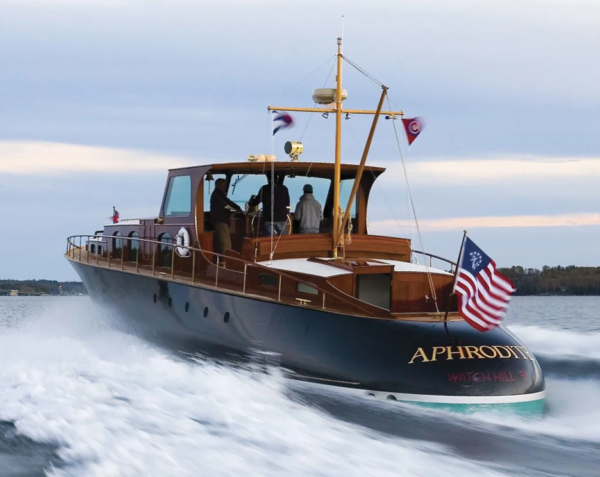
This mighty 1937 Purdy commuter yacht, Aphrodite , was completely restored at Brooklin Boat Yard with design support from Stephens Waring. Her rehabilitation shows how traditional design and technological innovation each have their place on the water. With redesigned propulsion and steering systems, new tanks and plumbing systems, and completely revamped interior, she offers a thrilling glimpse at what yachting was like in the 1930s—with all the comforts of today. Photo credit: Benjamin Mendlowitz
And in the fast-fashion world we live in, where it seems like half of what we buy has been replaced with a newer version before we leave the store, it gives us a good feeling to keep something old going, or better yet, to bring something from the past back to life.
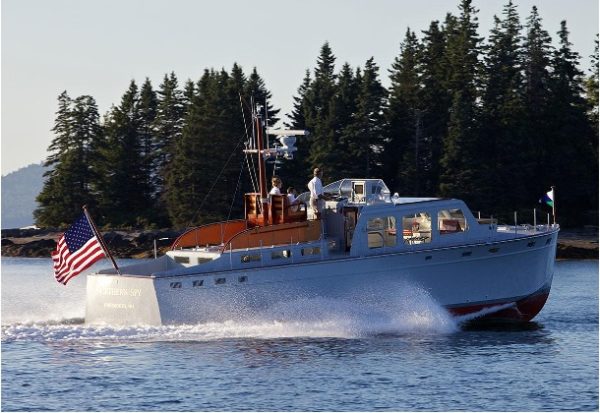
Stephens Waring worked with the owner of this classic 45’ Huckins, called Northern Spy , to rebuild the hull structure to accept the most modern of power plants: twin Volvo IPS drives. In the classic Huckins QuadroConic hull form, the IPS performs marvelously, boosting speed, cutting fuel consumption, and increasing maneuverability. Photo credit: Alison Langley
But for every unicorn rebuild project, there are plenty of renovation and restoration disasters along the way. Conversely, there is a mountain of smaller, less illustrious restorations and renovations, implemented successfully, which didn’t require the net worth of a Saudi Sheik to accomplish, but still extended the life and enjoyment of an old and beloved boat.
Big or small, iconic or sentimental, the key to any successful restoration project is figuring out how to identify the right fixer-upper and arming oneself with the knowledge to enter into a rebuild project with a clear understanding of the challenges, costs, and risks along the way.
Renovations vs. Restorations
The terms renovation and restoration are often used interchangeably. And while they may be close cousins, the goal and outcomes of a renovation or restoration project can be quite different in terms of objective, scope, and cost.
What is Restoration?

The bridge of Aphrodite was restored to match the original materials and controls of the vessel. Materials including varnished mahogany were carefully matched and rebuilt based on the original design specifications. Right image photo credit: Benjamin Mendlowitz
The primary objective of a restoration project is to bring a boat back to its original design and construction as closely as possible. Good restoration experts put significant time into researching the origins and background of the original build including understanding the history of the designer, construction techniques of the time, design philosophy, parts suppliers, and material sources.
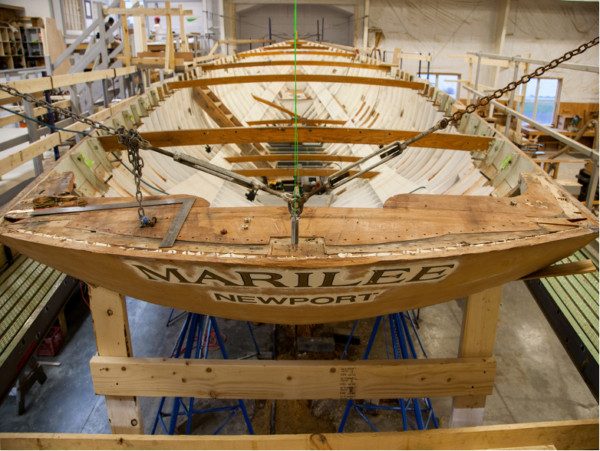
In 2014, French & Webb and Kurt Hasselbalch, curator of the MIT (Massachusetts Institute of Technology) Hart Nautical Collections, began restoration of Marilee originally built in 1926. In early winter 2014 they began with a 3D scan of the existing hull. This, combined with a CAD drawing created from the original Herreshoff plans, enabled the team to accurately examine Marilee’s current shape and compare it with the design from 1926. Photo credit: Alison Langley
Restoration experts often embark on a difficult treasure hunt as they scour the world for rare and comparable historical parts. This process can almost be as time consuming as the construction work itself.
During the restoration process, original materials are matched, and methods of construction are reused. Modifications from the original design are generally limited to changes necessary to bring a project up to modern codes and standards including electrical and life-safety. Stepping aboard a fully restored vessel should be like taking a step back in time.
What is Renovation?
Renovation is a much broader term. Generally speaking, it’s the process of renewing a boat or structure by fixing what’s present and adding something new or modern. This includes the integration of new materials, technologies, and even major structural design changes. We often think of a renovation as being built on the “spirit” of the original design while leaving the door open to new opportunities for creativity and innovation.
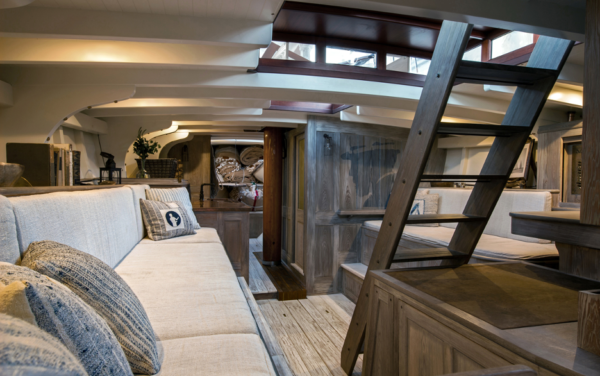
The owner of Marilee (built in 1926) had the bold vision to create an interior that reflected the yacht’s century-long provenance while creating an open space below. However, he wanted to get away from the dark “cigar room” interiors typical of so many classic yachts. The team worked with Paul Waring of Stephens Waring Yacht Design, to create a traditional and properly constructed interior with an updated layout for relaxed, modern day use. Photo credit: Alison Langley
Renovation can include adding new engines, propeller systems, updated electronics, efficient keels and hulls, and electrical systems. It can also include a refresh of the interior design elements and decor.
In some cases, renovation can be cheaper than restoration, especially for very old or historic boats where access to original parts and materials are rare or don’t exist at all.
Often renovations are completed in conjunction with restoration. In architecture we often see this with an old home or building where great lengths are taken to restore the exterior facade back to the original design, while inside, cutting-edge kitchens and bathrooms are installed. The effect is a blend of classic elegance with creature comfort and modern living.
What to Know Before Embarking on a Restoration or Renovation Project
There are no two ways about it, a major restoration or renovation can be costly and time consuming. They can also be extremely rewarding. The most successful projects are born from a sentimental and emotional objective rather than a purely economic consideration (although there are times when the economics pan out as well). Key to success is starting a restoration or renovation project with the right foundation. This may includes several of the following principles:
Starting with the Right Boat
Not all boats make good restoration projects. In fact, most don’t. The ones that do have that special something that may be referred to as being a “classic”. A good restoration candidate should have a historical or emotional value, or simply, a unique “wow” factor that makes it worthy of a second life.
Building on Good Bones

Zingara was originally designed by Bill Peterson, conceived to participate in the 1990 BOC-British Oxygen Company Challenge, a solo event ‘round-the-world yacht race. By the time we met her, the yacht was a long way from finished. Our renovation made the best use of her potential as a solid sailing yacht: the thoughtful design of the sailing platform, deck arrangement, and cockpit were to be functional in blue water; and down below her interior was to be spacious and comfortable, safe and relatively simple.
When possible, find a boat in which the problems are more cosmetic in nature than major costly systems repairs or replacements. At some point deterioration of major structures such as stringers and bulkheads may make restoration impractical. You should consider consulting with a professional designer like Stephens Waring to get an accurate assessment of major structural components and systems to fully understand the scope and resources necessary for a restoration or renovation.
Set a Realistic Budget and Timeline to Complete the Job
It is said that God created the world in seven days. That’s probably because he didn’t have to clean up anyone’s mess first. Realize that restoration and renovations are often as time and resource consuming as the original build itself. It takes time to undo the bad and rebuild with the good. Sweat equity can only carry your project so far and there are many hard costs and professional skillsets you’ll need to complete a big job. Working with a professional can help to set a realistic budget and define clear expectations and goals.
Size Does Matter
It’s easy to want to bite off more than you can chew. However, as a boat gets bigger the complexities of the systems become exponentially larger. The difference between a 30’ and 40’ boat can be immense. Experts generally recommend that no one attempt to restore a boat bigger than 35’ without professional support.
Where to Make Your Money Go the Distance
When done correctly, there are a number of benefits to upgrading and renovating rather than buying new. The key is to identify where to get the most bang for the buck. Finding a project where cosmetic repairs are the main problem is the best place to get a strong ROI. Renovations such as replacing upholstery, fixtures, refinishing surfaces, and painting can do wonders to make an old vessel feel new and increase the economic value.
Where to Start
Whether looking to renovate a boat you currently own or looking to purchase a used fixer-upper, we strongly suggest starting with a professional evaluation. Engaging an expert to inspect the hard to reach structures and systems can save a lot of money in the long run. A renovation expert like Stephens Waring can also help determine a solid triage strategy for what to discard, repair, and replace. For bigger projects, having a design expert create a detailed design and engineering plan, complete with 3D renderings, can provide a way for owners to better conceptualize the scope, cost, and outcome of the renovation and finished product.
Further Reading:
The Renovation of Marilee
The Renovation of Zingara
site by: slickfish studios
How to Restore a Boat (And What to Consider)
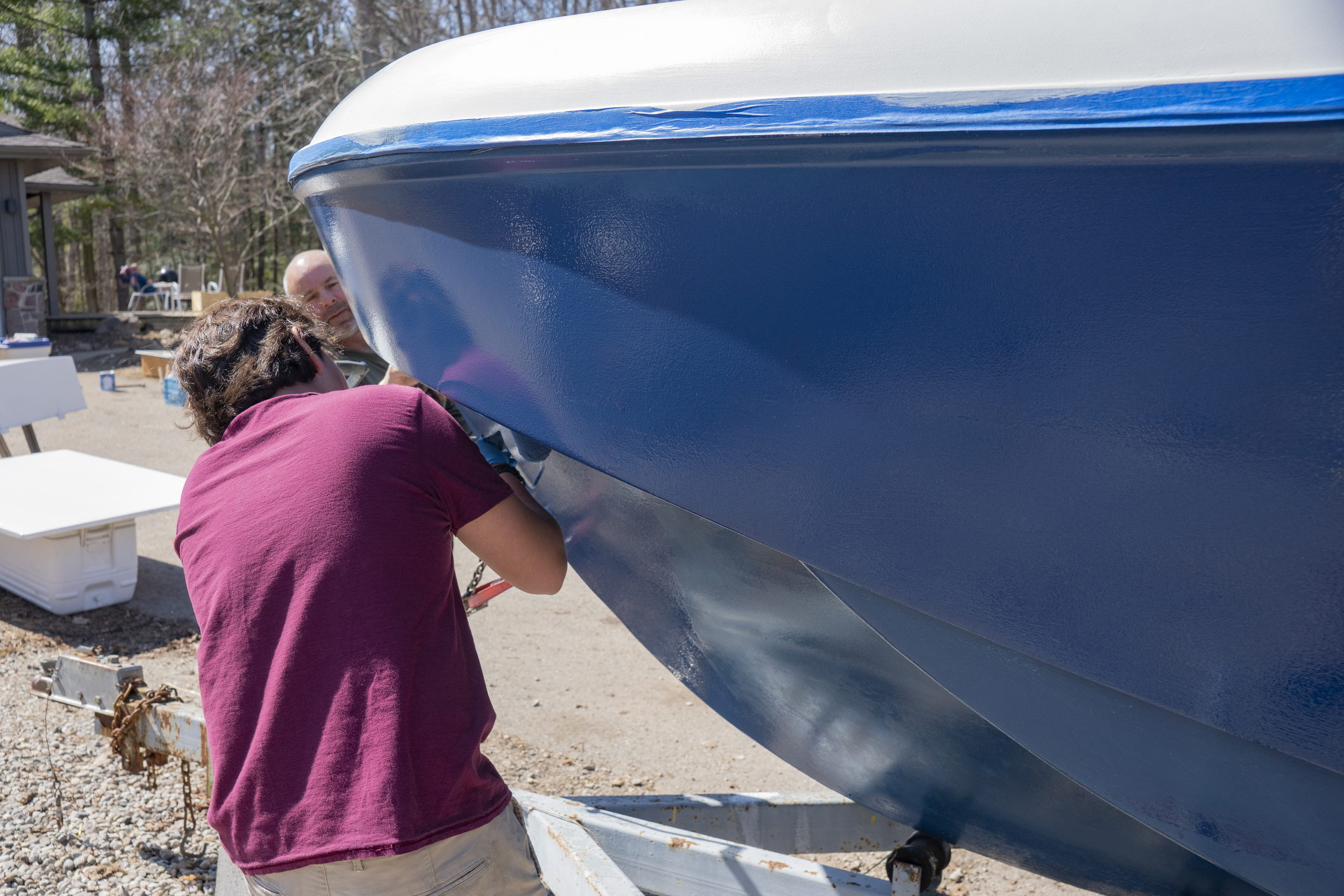
Boat owners often form deep bonds with their vessels, motivating them to restore rather than replace them. This commitment to preservation allows us to appreciate the enduring beauty of classic and antique boats. Plus, it's a budget-friendly option compared to purchasing new.
But before diving into boat refurbishing, it's essential to understand that restoring a boat requires considerable time, effort, and resources. This blog post will explain how to restore a boat, the pros and cons, and restoration alternatives.
The Pros of Restoring Your Boat
Let's discuss why people choose to restore their boats:
1. Cost Compared to Buying New
Aside from sentimental value, many people opt for restoration because it's cost-effective compared to purchasing a new boat . While material expenses can accumulate, they don't compare to the hefty price tags of brand-new boats. Restoration expenses primarily involve the cost of supplies and occasional assistance from a laborer for more challenging tasks.
2. Sense of Accomplishment and Pride
Building and restoring your boat creates a unique masterpiece tailored to your style and preferences. Your one-of-a-kind creation will be a testament to your dedication and craftsmanship – a vessel built with your own two hands.
3. Develop New Skills or Improve Old Ones
Every restoration project is an opportunity to learn valuable boat skills! Throughout your journey, you'll gain practical knowledge about mechanics, parts, and additional information needed to complete your project.
The Cons of Boat Restoration
Restoration projects can be demanding, and many sailors are hesitant to commit. Several factors influence people's decision not to undertake these types of projects:
1. Time and Effort
Restoring a boat can be seriously labor-intensive! Restorations require a significant time commitment, as you must allocate several hours. Many people find long-term restorations peaceful and satisfying. However, others find the pressure to complete it before the season begins overwhelming.
2. Unknown Challenges
You'll inevitably encounter unforeseen challenges. For instance, depending on your boat's make, model, and year, the manufacturer might not even sell that part anymore – meaning you'll have to get creative. If you expect the unexpected, you'll overcome any challenges!
3. Liability Concerns
In the unfortunate event of an injury, you'll likely bear responsibility for any resulting damages. Additionally, note that the quality of your craft can impact your boat's warranty and cause potential insurance complications. For this reason, it's best to hire a professional if you're unsure how to restore boat parts.
How to Restore Boat Accessories and Parts
Before you begin restoring, it's essential to have your vessel surveyed by a professional. This helps uncover hidden problems lurking beneath the surface (pun intended). In addition, doing so saves you time, money, and headaches.
Next, make sure to clean every nook and cranny. This step might seem counterintuitive but will benefit you in the long run. Cleaning removes obstructions and makes inspection easier. You should also remove any unnecessary hardware and finishes.
Now it's time to carefully plan your restoration, making a list of materials you need and the order in which you'll tackle tasks. Once you're ready to begin, start with essential structural repairs like fixing holes, leaks, or rot. This includes inspecting, repairing, or replacing weakened parts.
The next step is to repair all lines and sails . Then, decide whether engine repairs or replacements are the way to go. Once you restore the major components, it's time to sand, seal, add finishes, and replace hardware. Then, you can address interior elements like floors and seats.
Finally, test everything on both land and water to ensure it functions as it should. We also recommend creating a maintenance plan to ensure your hard work stays at its best.
Additional Tips for Boat Restoration
If you're up for a rewarding restoration project, consider checking out repossessed boats available for purchase online or at boat lots. These are significantly more affordable than their new or used counterparts. Additional alternatives to boat restoration include buying a used vessel or hiring a crew to restore a boat.
Here's another money-saving tip: Consider purchasing upcycled or repurposed parts instead of brand-new ones. Not only will you save money, but you'll be breathing new life into old pieces.
Lastly, you'll want to document your progress with photos and notes and test everything you do. This helps you keep track of your work and ensures you have proper insurance company documentation.
Wrapping Up Boat Restoration Advice
Refurbishing a boat can be a rewarding and uniquely challenging experience. And trust us when we say there's no greater satisfaction than seeing your vision come to life. If you are considering boat restoration, we hope this article points you in the right direction! Good luck, captain.
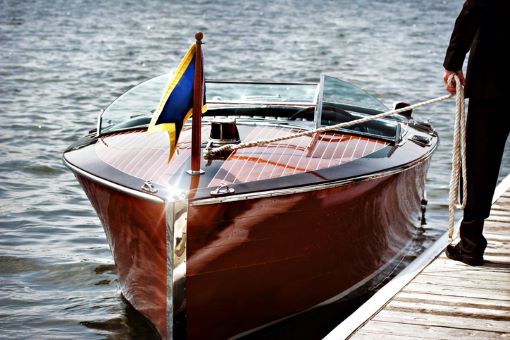
Join Our Newsletter!
Get community news, buying bargains, and how-to guides at your fingertips.
- Paddle Board

How to Restore a Boat: Complete Guide for Beginners
Boating offers you a fun way to spend time out on the water with family and friends. There are dozens of boat brands and designs with purposeful builds to suit any boating activity. From fishing in the flats in the estuary to taking on the waves in the open ocean, there’s a boat designed to do anything on the water.
While boating is fun, it’s an expensive hobby. Buying a new boat is as serious as purchasing a new car, and you need to carefully consider the right model and brand to match your motoring style. It’s the same thing with boats; you need a model that offers you the best performance for what you want to do out on the water.
Unfortunately, some decent boats can cost you north of $35,000 for an entry-level model. At the minimum, you’re looking at spending $15,000 to $20,000 on a new boat. So, it makes more sense to buy a used model, right? Going with a pre-owned boat can save you thousands on the costs of your vessel.
Just like cars, you get used boats in a variety of conditions, from those that need huge amounts of repairs to those that only need a few touch-ups. However, chances are you’re going to need some level of refurbishment to your boat, regardless of the age,
Refurbishing a used boat can save you thousands on the price tag, especially if you have the handy skills to do it yourself. This guide gives you everything you need to know about how to restore a boat.
Plan and Set Up Your Workspace
If you’re purchasing a boat, make sure you have a dedicated space on your property for the restoration. Storing the vessel in a shipyard at the marina means you’ll have to waste time traveling between the shipyard and your home when restoring the boat.
That’s time you could be putting into the work, and having your workshop close to where you live saves you hours of time, getting the project finished in the fastest time possible. When you have a workspace at your home, you have access to outlets and better security for the boat and your tooling.
Workspace Requirement
If you don’t have the space to store the boat at your home, look for suitable premises you can rent close to where you live. We recommend finding a place with an overhead cover allowing you to work in all weather conditions, and don’t forget the need for power outlets for your tools. You’ll also need access to water on the property and security for the boat.
Basic Restoration Tools
You’ll need to make sure you have the following restoration items and tools before starting your project.
Try and get two if there are two of you working on the project. The boat’s sides are steep when mounted on the trailer or at the yard. The ladder helps you climb in and out of the vessel and reach the high spots on the sides from the ground.
Flexible Hoses
These hoses are easy to coil up and move around the boat.
Personal Protection Equipment (PPE)
You’ll need respirators, surgical gloves, and safety goggles for your protective gear. The respirator is critical when sanding away paint and fiberglass, keeping the particles out of your lungs.
Entertainment
Get yourself a Bluetooth speaker to play your favorite songs when working on your boat – it helps to pass the time on long restoration jobs!

Boat Inspection
When purchasing your boat, make sure you give it a complete inspection before making your final offer. It’s a good idea to have a professional inspect the boat for you and point out any problems before you make your purchase. The last thing you need is to discover damage or engine/electronics problems after paying the owner.
Talk to the Seller
Before calling the pros, ask the seller if they have anything they want to disclose with their boat before handing it over to you. If you’re purchasing from a used dealer, ask the following questions to your agent before closing the deal.
- How did the previous owner treat the vessel?
- How did the previous owner store the boat?
- Is there any existing damage or repairs required?
- What are the service history and previous repairs done on the boat?
- How often did the previous owner use the boat?
- What maintenance did the previous owner do on the boat?
Restoring a boat is a big undertaking, especially if it’s in poor condition. Make sure you understand the task you’re taking on before you decide to buy the boat and make a huge mistake.
If you give up on the project halfway through it, you’re not going to make any money on the work you did to the boat. You might sit with it for a while before you find a buyer willing to commit to the restoration project, leaving you out of pocket.
Some repair jobs with boats just aren’t worth the hassle. The bigger the restoration project, the more money and time it takes to finish the restoration. Some of the major restoration problems to avoid include the following.
Wood looks fantastic on boats, providing a classic look and a wonderful aesthetic to the vessel’s finish. However, the issue with wood is that it rots. If the previous owners didn’t maintain the wood, you could be in for a serious, costly replacement when refurbishing the boat.
Wood finishes are more popular on older boats, so the chances are that you’re going to need to remove and replace all the rotted wood, and that can get expensive. However, if you find a boat with mildly deteriorating wood finishes, it may be possible to salvage it with the right tools, materials, and care.
If the boat is 25-years old or older, then the chances are that damage to wooden components on the vessel will have some rot in them. Almost every wooden boat would experience wood rot at some stage, especially if the owner didn’t take the necessary care of the vessel.
Some of the older boats may have a “cored” hull. Purchasing a boat with this design is a mistake. Eventually, you’re going to have to remove and refurbish the core, and that’s going to be a huge hassle in your project, taking up hours of your time. The coring in these older models typically features balsa or thin plywood.
If you’re dealing with someone on a prospective older model, it’s a good idea to do some research online into that specific model. If it has coring, then rather walk away and look for something else.
Some of the boats don’t have a cored construction, and that has that one advantage when it comes to the complexity of the restoration, and the time it will take. Other components on the boat that are at risk of developing rot include the transom, seats, floors, and stringers.
While wood offers an impressive finish, most modern boats replaced this material with fiberglass or aluminum over the last two or three decades. The paint on the boat comes from the factory looking fantastic. However, a few years in the sun at the marina will take the luster out of the paint job.
Most old boats come with a gel coat direct from the factory, adding extra protection to the paint. Some of the earlier models may also feature a metal flake, which has an impressive look. If you’re completing a restoration, the paint will probably be the most expensive part of the process.
So, we don’t recommend painting the boat after you finish the restoration if you want to save money on the job. It’s a better idea to try and restore the factory finish as best as possible.
If the old gelcoat needs some attention, you can buff it out and make the boat look 10% to 20% better with this simple task, saving you the paint costs. If the gel coat is repairable, don’t waste your time and money on repainting the boat.
The motor is another considerable point of failure when purchasing a boat. First, make sure that the engine is still in production. If you’re buying a boat from a manufacturer that went under, then the chances are those spares are not available anymore. As a result, you’ll have to spend hours digging through wrecks at the local salvage yard to find what you need for the job.
If you have the chance, purchase a boat from a person that works on the engine themselves. These people will take the best care of the motor. If that’s not an option, look for boats with the most extensive service history possible.
Ask the owner to start the motor, and ensure that it runs correctly. If you have no experience with boat engines, find a mechanic that can give the motor a once-over inspection and tell you about the problems you need to fix.

Get a Second Look
Buying boats and motors aren’t a good idea if you don’t have any experience with boats and don’t know what you’re looking at during the inspection. On the surface, the boat might look fine, but there might be a slew of problems with the vessel under the surface.
The last thing you need is to buy a lemon and never finish the restoration. So, it pays to have a professional assessor look over the boat before you close the deal. The professional will run over the electrical and mechanical components of the boat, the wiring, and the engine to point out any problems with the vessel.
While it’s easy to see the exterior damage and damage to the boat’s body, the stuff out of sight is a real concern, and the professional assessor will remove this risk from the deal.
Create a Master Restoration List and Prioritize Tasks
After you finalize your purchase and have the boat assessed by a professional, it’s time to plan the restoration. Planning doesn’t take much time, and it will end up saving you plenty of time and money in the restoration process.
You’ll need to create a master priority list for the restoration tasks involved with the project. When creating your priority schedule, ask yourself the following questions.
- What work do I need to do to make the boat run safely?
- What work do I need to do to get the boat to float?
- What damage is cosmetic, and what damage is structural?
- What are the vital tasks to complete, and what would be nice to have?
- Do I need specific workshop conditions for this restoration?
These questions help you form the framework around the restoration project. Organize your list, starting with the most labor-intensive tasks at the top of the list. Make sure you focus on safety and never work on the boat without wearing the correct safety gear.
Create a Restoration Calendar
After you finish prioritizing the tasks involved with your project, it’s time to map out your schedule on your calendar. A goal is only a dream until you put a timeline to it, and this phase of your planning is as critical as the prioritization phase.
Set realistic goals for completing each of the tasks, and stretch yourself to make the project challenging. If you don’t hit your timelines, that’s fine; just make sure you’re focusing on the quality of your work at all times.
If you make your purchase in October, you could set a date for having your boat in the water by the following July. That sounds like a great way to start the summer, right? With this goal in mind, you’ll need to complete the preliminary work involved with the project by June and leave the aesthetic repairs for the fall after the summer ends.
Taking the time to plan out your project relieves the stress and uncertainty involved with the restoration. With the right milestones in place for your project, you’ll find you feel more confident, with the momentum of your achievements pulling you through the project’s timeline to a successful restoration.
Some boat owners find that the length of the project becomes a chore to manage, and they lose interest over time. When you plan the project carefully, you’re consistently moving through it, and you know what to expect. Sure, there might be setbacks, but you’ll eventually achieve your goal with the restoration with the right planning.

How to Restore a Boat – Checklist
By now, you should understand the basics of what you need for a boat restoration project. It’s no simple task, and you can expect to spend anywhere from a year to two years or more on the restoration, depending on the condition of your boat.
However, with the right planning and execution, the time will fly by, and before you know it, you’ll be out on the water. We decided to give you this checklist to help you navigate your way through your boat restoration project.
- Make sure you have an adequate workspace for the project.
- Take an inventory of your materials and tooling.
- Clean the boat properly and remove all dirt before you start the project.
- Remove all organic material and water from the boat to prevent mold and pest infestations.
- Inspect the boat and identify any problems with the exterior.
- Contact a boat inspection service and have them go over the boat to confirm the final issues involved with your restoration project.
- Drain the fuel tank and remove the engine from the boat.
- Drain the gear case of the old oil.
- Remove old hoses and belts on the motor and replace damaged parts,
- Check through-hull fittings and ensure they have tight seals. Replace any perished seals.
- Check the seacocks to ensure they are in working order. Replace any damaged parts.
- Inspect the hull of the boat for signs of any cracks.
- Check for cracks in the fiberglass around fittings and fixtures.
- Ensure that any load-bearing fixtures have the proper backing plate for support.
- Check the boat from top to bottom for any evidence or signs of wood rot.
- Check the deck flooring, bases of seats, and the ransom. Look for any signs of decay or deterioration.
- Strip the old and rotted wood from the boat. Replace it with marine-grade cored composites or plywood.
- If you’re having issues with a specific part of the restoration project, research it on YouTube.
- Look on forums if you have trouble working out any problems – the people there have loads of experience, and they are great resources for knowledge.
Wrapping Up
After you have all your planning ready and the boat set up in the workshop, it’s time to roll those sleeves up and get to work!
The biggest issue with any restoration is the time involved with the project. During the planning phase, map out the time you have to work on your project each week and outline the required finish date for your restoration.
Stay committed to your project, and don’t give up!

John is an experienced journalist and veteran boater. He heads up the content team at BoatingBeast and aims to share his many years experience of the marine world with our readers.
What to Do If Your Boat Engine Won’t Start? Common Problems & How to Fix Them
How to launch a boat by yourself: complete beginner’s guide, how to surf: complete beginner’s guide to get you started.
Comments are closed.
Type above and press Enter to search. Press Esc to cancel.
- Practical Boat Owner
- Digital edition

How to buy an old boat as a project – DIY yacht restoration advice
- October 31, 2019
Yacht broker and part-time boat restorer Will Higgs shares his passion for buying old boats and making them as good as new

Firebird is a Mirage 28 restored then sold on
Growing up sailing on the East Coast it’s fair to say that I caught the bug pretty early on. Family sailing on my father’s yachts and starting in dinghies from the age of five, it was clear from the outset that boats were going to play a central role in my life in one form or another.

My first project boat was a dinghy which my dad brought home when I was around four years old. She was 7ft 6in length overall and far too wide to sail well, but she had a gunter rig, foils that needed varnishing, rubbing strakes to replace and a hull that needed painting. Her name was Jake and she was going to be my boat. I was hooked.
Through my teens the boats grew until at 18 I purchased my first yacht – a Hurley 20. I couldn’t have been prouder, she needed new windows and a complete repaint right through but she was mine and I poured every spare minute and penny I had into her for six months before she was ready for sea.
As time has gone on, the boats have got bigger, but the principle remains the same: buy a green one and polish the love into it. A Hunter 701, a Seamaster 23, a Mirage 28 and now a 32ft Barbary Ketch – all made possible by adding a little more value to each boat as I went along.
Now my family and I can cruise the West Country in relative comfort and have clocked up some respectable sea miles, not to mention a few stamps in the passport. But it all started from bailing out the cabin of that first Hurley and wondering where to start.

My first project boat: “She was 7ft 6in length overall and far too wide to sail well, but she had a gunter rig, foils that needed varnishing, rubbing strakes to replace and a hull that needed painting.”

Why refit a boat?
For some, the pleasure of bringing an old boat back to life is the driving force; for others it’s a means of getting afloat on a tight budget. Whatever the motivation, all boat restorers share a love of the sturdily built and seaworthy lines of craft designed, in many cases, over half a century ago.
Indeed it is the robust construction of these old hulls that has led to the wide availability of potential projects which can be found in the damp, dark corners of almost every boatyard in the country and I dare say the world over.
These are boats that were designed in the days when a family of four would have bravely put to sea in a 20-footer for their summer holiday and that are still robust enough to earn their keep not only as a vintage item to be varnished and polished, but also as originally intended – fully functional cruising yachts.
So what are the benefits? It’s clearly a major undertaking, a modest refit project could easily see you through six months’ worth of evenings and weekends – not to mention the expense. Why do so many start and fail to finish?
Firstly, a refit is an excellent way to get to know a boat. For the DIY boat owner it makes perfect sense to go through her with a fine-tooth comb and address any issues along the way. It’s an excellent way of stretching the budget: real value can be added to a project boat, so whether the plan is to keep it long term or trade up, the minimum result to aim for should be a newly refurbished boat for a similar cost to a tired one on the open market.
Those who undertake boat projects for the simple pleasure of returning something sore and neglected to its former glory can be seen standing back at the end of each day of work with the sun setting behind them and a satisfied smile on their face. The sweat and occasionally blood poured into their pride and joy barely registers against the surging pride at every inch closer the boat gets to touching down in the water.

Before and after images: This Dufour 2800 required a £3,500 restoration budget and 50 hours’ skilled labour
How much will a yacht restoration cost? Even if you can commit £1,500 and 1-2 days per week for three months, you should still only be considering project boats under 26ft long. · The skill level, budget and timescale requirements increase exponentially with the size of the boat so careful planning and a couple of attempts with smaller craft first would be well advised. · As a case in point this Dufour 2800 (above) required a budget of close to £3,500 as well as 50 hours’ skilled labour. Keep control of the costs on a project – it really is possible to keep spending if you are not careful.
Key considerations when choosing a boat for a restoration project
Selecting the right project boat carries many of the same criteria as any yacht purchase might, with a few specific additions. Scope of use and budget are fairly standard considerations as is the availability of a suitable mooring. However, it is easy to forget about these important points when looking at a boat that may be months or even years away from her launch date.
How will the boat be used?
Picking a boat that’ll meet your requirements when she’s ready for sea is critical to a successful refit. There will be times when walking away will seem like the easiest option. On the days when the paint won’t wash off, the splinters won’t come out and the head is sore from banging it repeatedly against the bank balance, even the most ardent enthusiasts need a vision of the finished article to remind themselves why they started down this road. There are plenty of tough moments restoring old boats, but for me, thinking about launch day sees me through every challenge.
What is my budget? What is my skill level? How much time can I commit?
It may sound obvious but blowing the entire budget on buying a boat that will require significant additional repairs is a recipe for failure. At best it will result in extensive and unnecessary storage fees that will further eat into the budget and add to the overall costs. There’s a certain principle of frugality at the heart of restoring boats and perhaps hand in hand with budget comes time. For these reasons it’s important to consider how big the boat really needs to be. A large project will incur far higher overheads and take much longer to complete. It is also more likely to require a higher level of expertise to tackle the more complex systems and structural issues.
Will it fit on my mooring?
It is advisable to have somewhere lined up to keep the boat before choosing one: the size and type of mooring available can play a part in the selection.
Pitfalls to avoid
The following hints and tips apply to beginner/intermediate standard DIYers on the majority of yachts. Ignore for boats with a high end value, or if you consider yourself to have a high skill level:
· Boats that are just a shell with no salvageable equipment. The cost of replacing gear can snowball very quickly so it’s important to factor this in before getting started
· Boats with faulty keelbolts can be expensive to put right and tackling it properly on a DIY basis is not for the faint-hearted.
· Avoid boats that are going to cost far more than their end value to put right. There’s nothing more soul destroying; check the market first!
· Boats that have major structural defects. There are plenty of boats out there that only need TLC.
· Boats that are too big for your budget and timescale will sap resources and demoralise. There are occasions where a refit could be programmed over months or even years, but as far as shoestring projects go, every week in the yard is added cost to be avoided.
Restoring a Leisure 20 for a client
A few months ago I decided that I wanted to take my lifelong passion to the next level, so I set up a brokerage through Imperial Yachtbrokers ( www.imperial-yachtbrokers.com ) and started refurbishing yachts in a local yard where I have some history of carrying out boat projects for myself.
So far we have refitted a Sadler 29 , a Dufour 28, and are in progress with a Westerly Centaur and a Westerly Griffin.
I was also approached by a lady at a local yacht club who wanted a daysailer/weekender to keep on a swinging mooring. We chatted about her requirements and settled on a Leisure 20 for its sailing characteristics and ease of handling while still providing overnight accommodation and somewhere to make a cup of tea!
She struggled to find a good example, so I had a look around and located one in a nearby yard that was in a sorry state but could be bought for £300 on condition we move it straight away. We sourced an engine, had her dropped in and motored her around to our base at the Lynher Boatyard in Torpoint to do the work, starting with emptying her of gear and cleaning her from end to end.

Leisure 20 as found in need of TLC – but was only £300 to buy

Hull was grubby but basically sound

Deck’s non-slip paint was looking worse for wear

Interior needed a good clean and a retrim to modernise
The brief with this boat was to keep her simple, set up for day sailing and with a minimum of potential failure points. One of our first jobs was to remove and glass in all of the through hull fittings as these would not be required.
We spent some time carrying out the usual sanding of woodwork and polishing of the hull. New vinyl decals were added to draw the eye and the deck paint was re-applied in a more modern looking light grey.
We also repaired the redundant screw holes in the mouldings and retrimmed the interior to make it functional and attractive.
Externally, we cleaned and applied silicone grease to all the fittings’ moving parts and replaced any fittings and lines that were broken or worn out. We then raised the mast, dressed it with sails and relaunched the boat ready for a shakedown en route to her new mooring.
There are few more satisfying moments than raising the sails for the first time on a resurrected boat.

Cleaned, polished and varnished – what a difference!

Launch day! There are few prouder moments…

Restored. Afloat. A Leisure 20 ready for new sailing adventures

Key figures
Initial purchase: £300 Yard costs: £330 Engine: £275 Misc parts: £400 Total : £1,305 Time commitment: 50 hours’ labour over four weeks
We had to allow for around 50 hours of labour as well as the costs of various parts and yard storage costs, but what is very clear from the figures is that refurbishing a modest yacht is an affordable undertaking.
DIY boating on a budget
With determination and a basic skill level, anyone can get on the water without going bankrupt. It’s simply a case of being sensible: pay attention to boat selection, programming and budgeting the project then stay focussed and work hard.
- AB Inflatables
- Hunt Yachts
- New Inventory
- Pre-owned Inventory
- Propulsion Partners
- Outboard Service & Repower
- Boat Storage
- Request a Quote
- Financing Application
- Boat Shows & Events
- Meet the Team
- Yachting Insider
- RestoMod/Tuning
- Types of Yachts
- Outboard Service and Repower Center
- Volvo Penta
- Finance Application
- About Us / History
- Resto-mod Gallery
YACHT RESTORATION PROJECTS
If you've ever dreamed of updating or restoring an older boat like a car enthusiast revives a classic '71 Thunderbird, the Yachting Solutions team will follow your lead and bring that vision into reality. Using our resto-mod process, we refurbish the classic lines of vintage vessels while incorporating modern performance features, all to deliver a customized watercraft that speaks to your soul.
A hybrid of restoration and modification, Yachting Solution's resto-mod process preserves your boat's timeless look with modern upgrades to meet today's performance needs. From small lake boats to large motor yachts, we're passionate about the art of boat restoration. We'll work closely with you to create a personalized resto-mod concept and deliver a fully realized remodel you can take pride in.
Whether you want to restore a 60s Boston Whaler, refresh your boat's exterior paint, refurbish your yacht's interior, or get a quick installation of the latest boat mods, give Yachting Solutions a call. Our expert shipwrights, painters, varnishers, and technicians are here to help return your watercraft to its former glory and provide cutting-edge upgrades to enhance all your boating adventures.
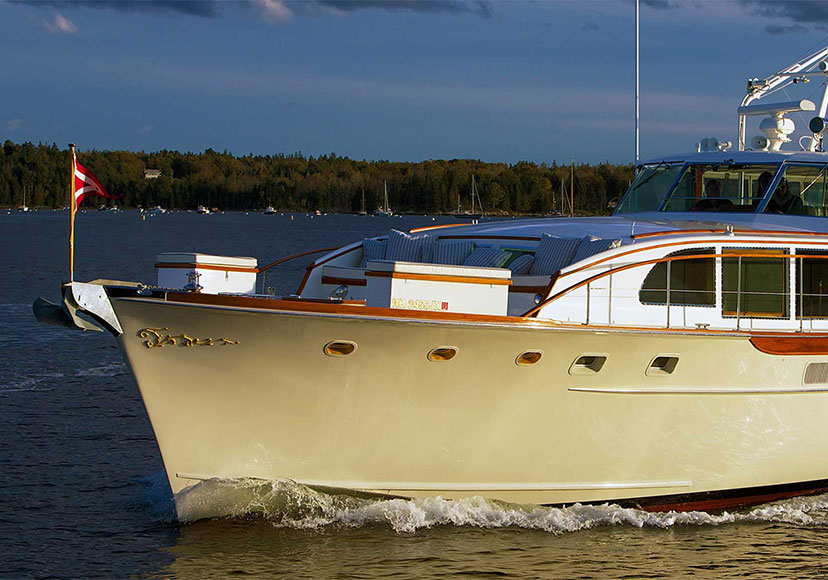
1971 TRUMPY
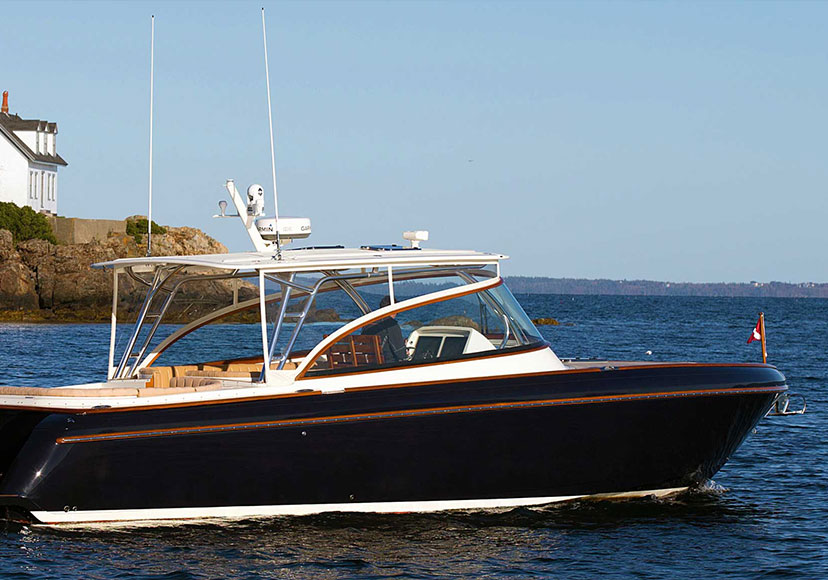
2013 INTREPID
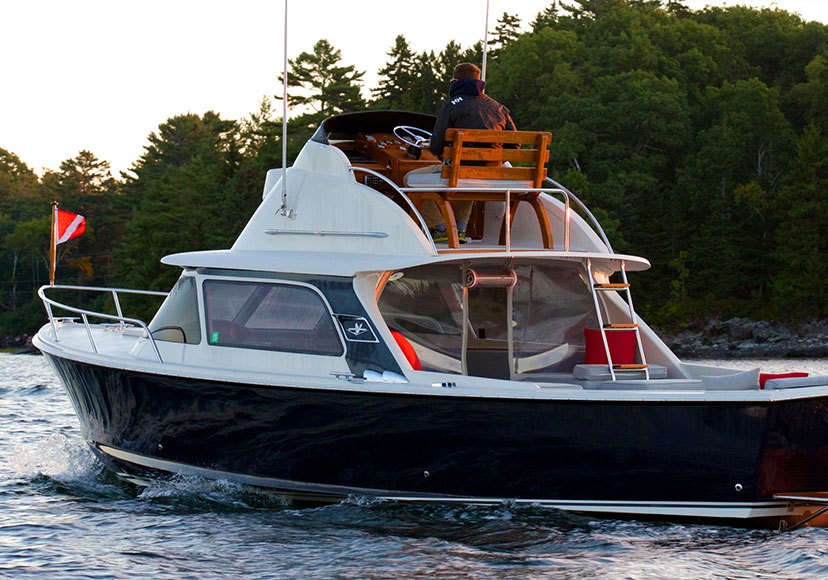
1963 BERTRAM
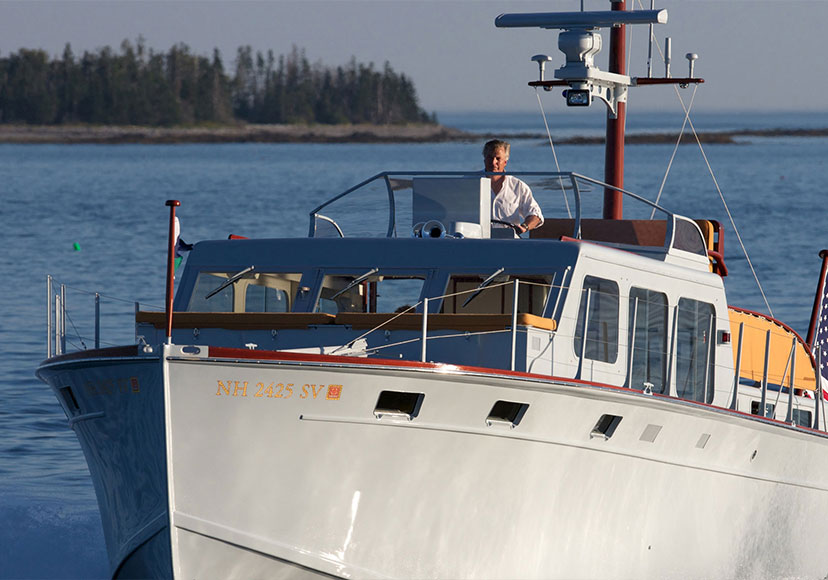
1954 HUCKINS
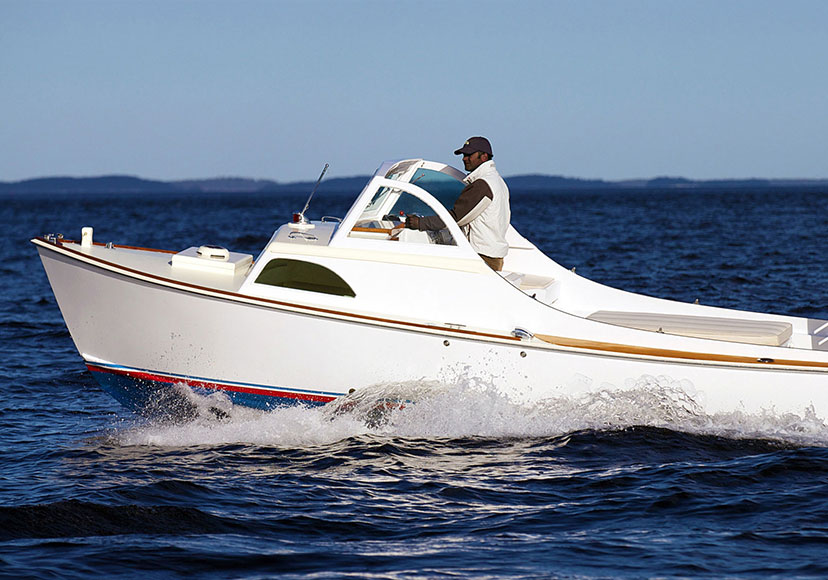
1964 WHITICAR
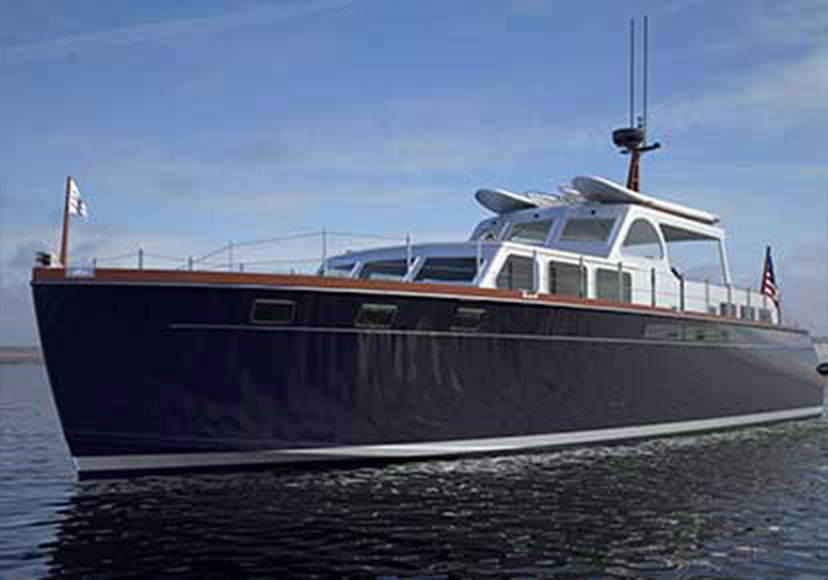
1956 HUCKINS
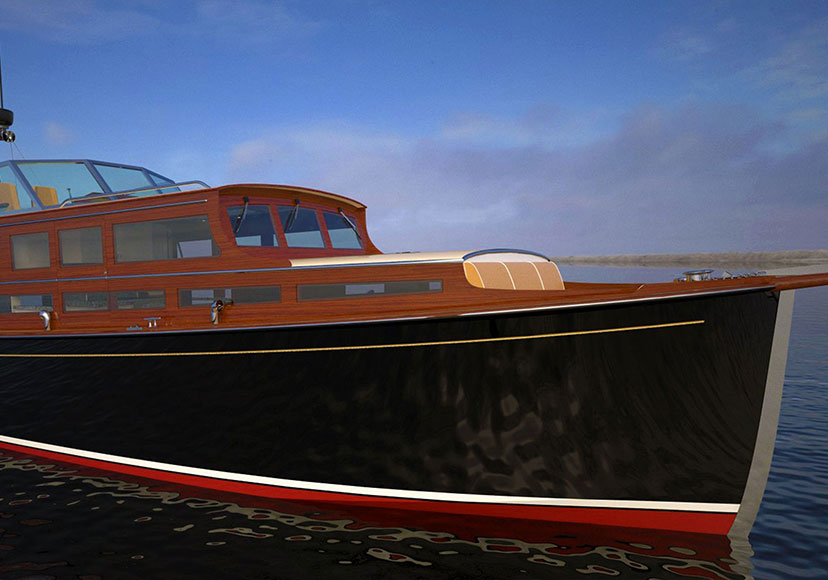
1930 HUCKINS
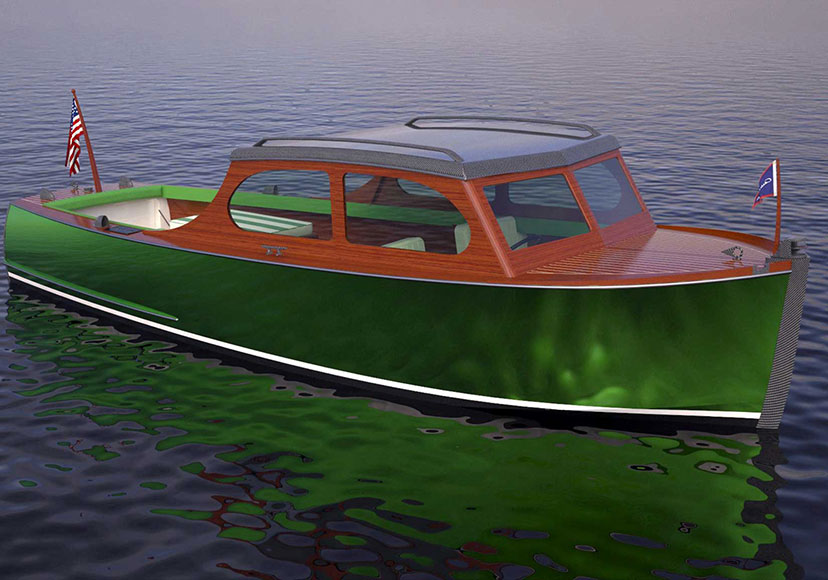
1940 CHRIS-CRAFT
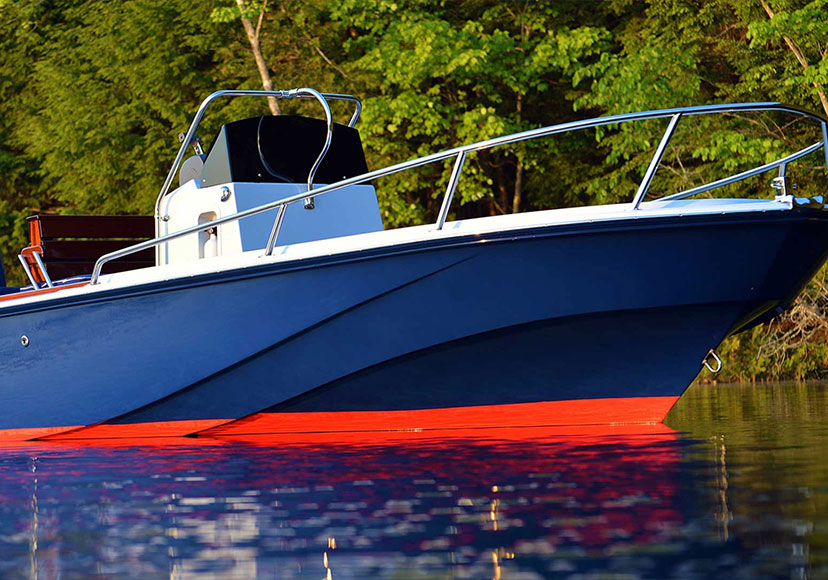
1989 BOSTON WHALER
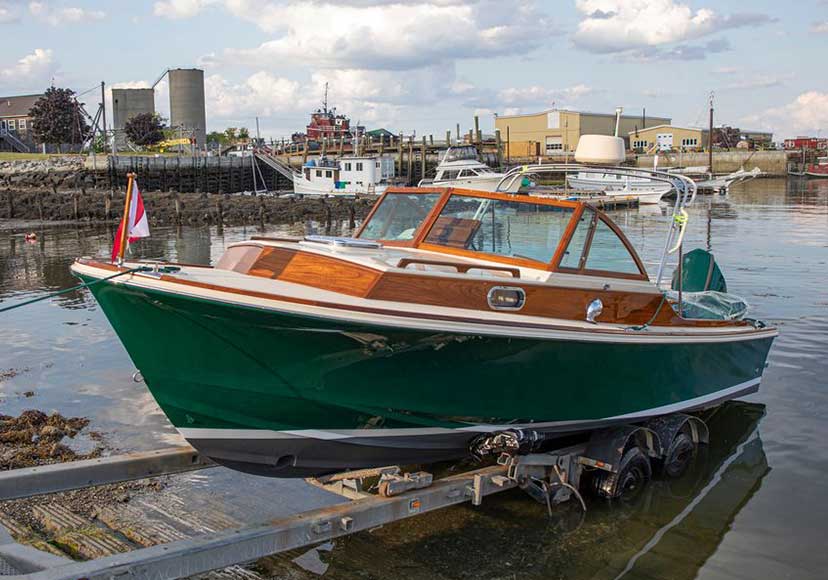
1972 AURELIA CLASSIC
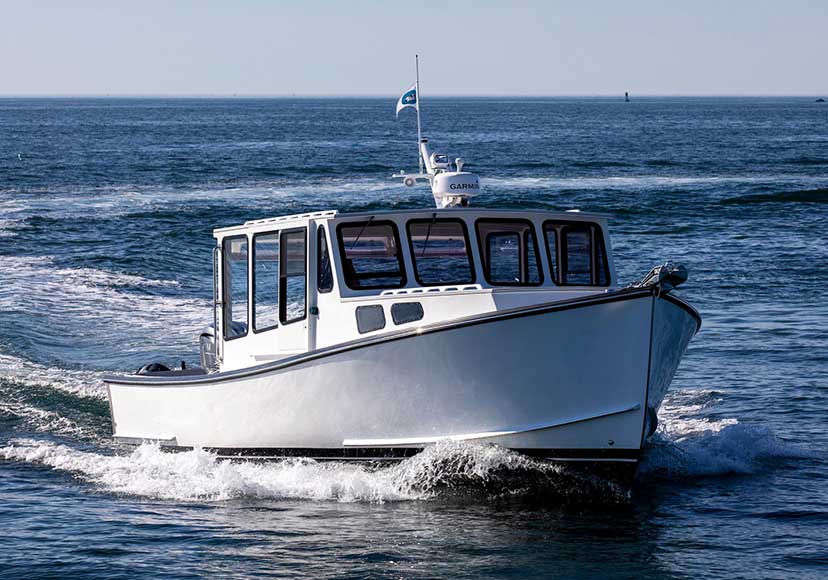
COW TOW LOBSTER
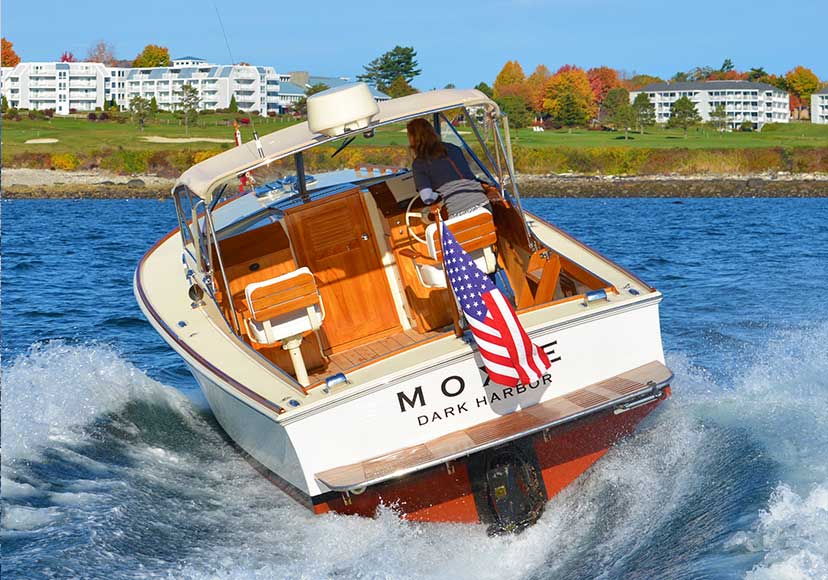

Service Locator
- Angler Endorsement
- Boat Towing Coverage
- Mechanical Breakdown
- Insurance Requirements in Mexico
- Agreed Hull Value
- Actual Cash Value
- Liability Only
- Insurance Payment Options
- Claims Information
- Towing Service Agreement
- Membership Plans
- Boat Show Tickets
- BoatUS Boats For Sale
- Membership Payment Options
- Consumer Affairs
- Boat Documentation Requirements
- Installation Instructions
- Shipping & Handling Information
- Contact Boat Lettering
- End User Agreement
- Frequently Asked Questions
- Vessel Documentation
- BoatUS Foundation
- Government Affairs
- Powercruisers
- Buying & Selling Advice
- Maintenance
- Tow Vehicles
- Make & Create
- Makeovers & Refitting
- Accessories
- Electronics
- Skills, Tips, Tools
- Spring Preparation
- Winterization
- Boaters’ Rights
- Environment & Clean Water
- Boat Safety
- Navigational Hazards
- Personal Safety
- Batteries & Onboard Power
- Motors, Engines, Propulsion
- Best Day on the Water
- Books & Movies
- Communication & Etiquette
- Contests & Sweepstakes
- Colleges & Tech Schools
- Food, Drink, Entertainment
- New To Boating
- Travel & Destinations
- Watersports
- Anchors & Anchoring
- Boat Handling
Boat Restorations: A Return To Glory
Advertisement
These two BoatUS Members know their way around a DIY project, and know what it takes for a full boat restoration. Here's the results of their of makeovers.
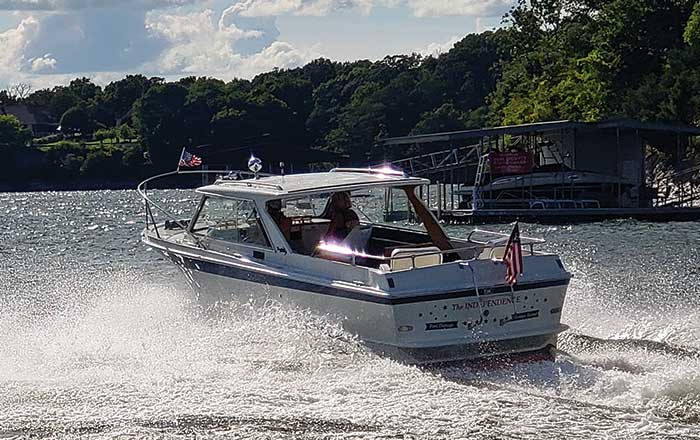
The Independence : Uniflite 23 Sport Fisherman Hardtop
I had a friend who inherited his father's 1968 Uniflite 23 Sport Fisherman Hardtop. Then it sat outside his house for 20-some years. He intended to keep it up and use it, but life got in the way and it sat uncovered for too many of those years.
I bought the boat and trailer for $1,000. A few years of work and about $40,000 later, other boaters frequently holler, "I LOVE your boat!" at me in anchorages. I'm not sure why, except that it's a rare bird on Grand Lake, Oklahoma.
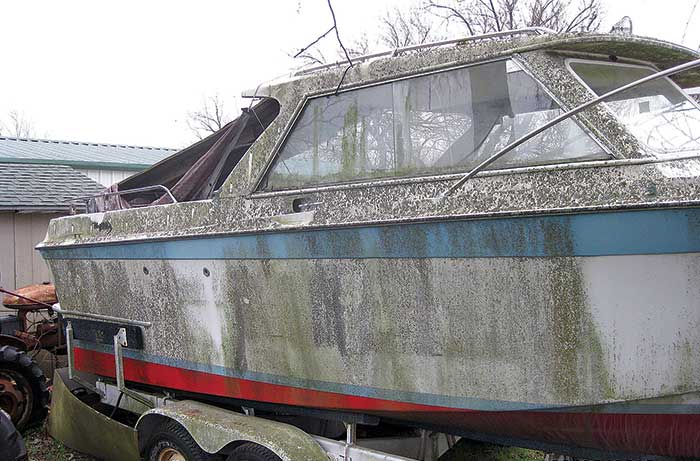
Nothing about the job was real hard, but I'm 74 and have been doing similar work on boats or houses for years. My only surprise was that so little of the original boat was still usable. So I became a reliable online customer of West Marine and Marine Parts Source.
All but about 30 square feet of flooring (in the cabin area) was rotted, so I removed the original dinette and captain's seats, table, toilet, and icebox, then cut out and removed the plywood bulkhead between the engine and the cabin area, and removed the original Chrysler 318 engine with the Paragon transmission and V‐drive. Digging deeper, I determined the metal fuel tanks were beyond their useful life and removed them (two 27-gallon tanks), plus the old fuel fills and filler hoses. The steering cable was no longer usable, so I removed the cable along with the wheel and gear box. I really wanted to save the old "Popeye" steering wheel with the spokes sticking out but couldn't make it work with the new steering gear and cable. I made a new bulkhead from 3/4-inch marine-grade plywood and replaced missing floorboards in the cabin. I removed the helm console that enclosed all instruments and helm wiring.
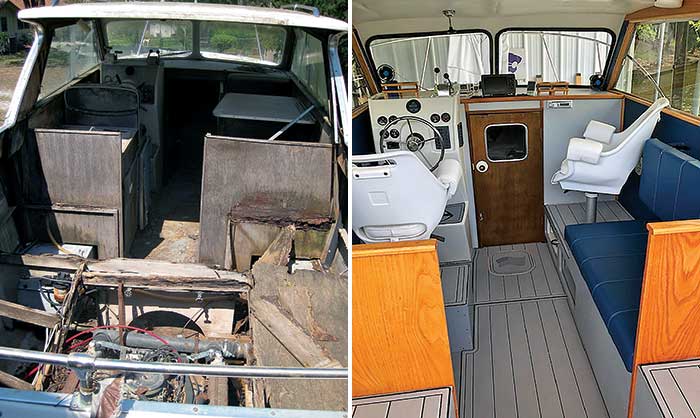
Before renovation (left) nearly all of the flooring needed to be replaced (right).
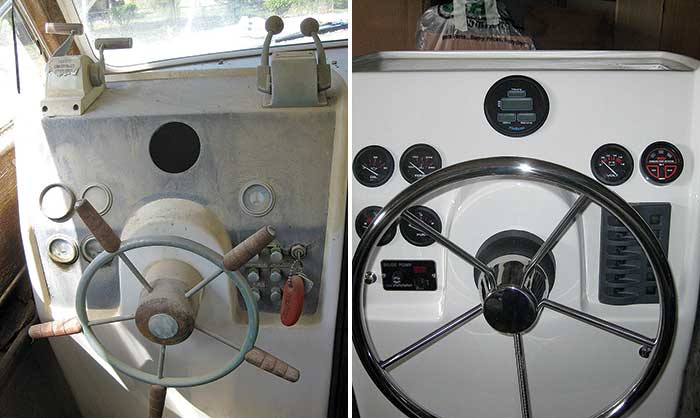
The new steering wheel (right) is a better fit for the helm then the old one (left).
I painted the bilge, then painted the marine plywood floorboards with one coat of epoxy, replaced and glassed in 2-by-12s that were used to secure the boat roof to the hull sides, removed all hardware, trim, rails (except handrails on the roof) from the boat for paint prep.
The original Chrysler Marine 318 inboard engine was beyond overhaul condition, but there are still a lot from the 1960s through the '80s, so I had no problem finding a remanufactured 318. I loaded my pickup truck with the rebuilt engine, the original Paragon transmission, and V-drive and took it all to a mechanic friend in Kansas City, who put new seals in the transmission and V-drive.
Despite my assumption, my boat was apparently never a dual exhaust boat. It came to me with brass or bronze elbows that had been mangled through the years and weren't reusable. The combined exhaust went through a muffler on the starboard side then out the only thru-hull on the stern. I bought fiberglass exhaust elbows from Marine Parts Source, which came to me with single clamps, and didn't dawn on me that I needed to double clamp it. I've since corrected that.
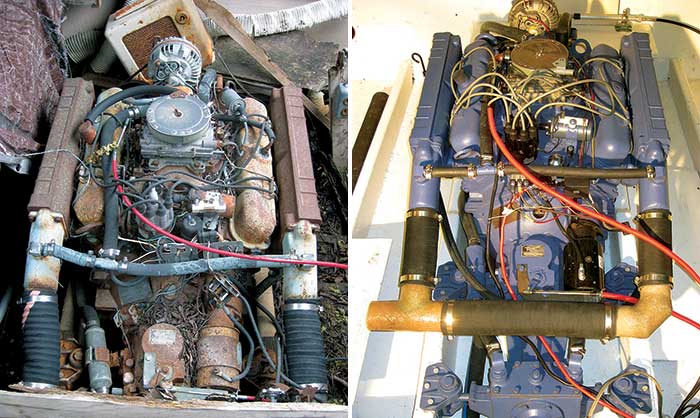
The original Chrysler Marine 318 inboard engine (left) was beyond repair, but remanufactured models can be found (right).
Then came the reassembly. I installed twin Moeller 25-gallon fuel tanks, muffler, exhaust plumbing, new steering gear and cable, new fuel fills and hoses, Fireboy Fume Detector by Xintex battery, and new cables, windshield panes, side windows and track for sliders, new prop shaft and reconditioned prop, new helm instrumentation, wiring, and gear/throttle control.
I had been keeping track of time spent on the project and was up to 452 hours when I quit taking notes. By then, I was down to remounting all the trim, cleats, rails, the fiberglass skirt around the cockpit, upholstered items, interior lights, underwater lights, new trim tabs, decals, custom built Uniflite logos, and SeaDek flooring.
We have a 37-foot cruiser but use the little Uniflite more often because it's so much easier for my wife and me to handle without help. Generally, that amounts to rafting up with friends and relatives somewhere on Grand Lake in Oklahoma to spend a productive afternoon NOT solving any of the world's problems. Very little of the original boat hardware was still usable, so I spent somewhere in the area of $40,000 on the project. And I've yet to need my annual membership to TowBoatUS.
— Darrell Gentry, Oklahoma
Lady Di , Speedliner Outboard Runabout
My wife, Diane, and I have always loved wooden boats. Our home on Legend Lake, Wisconsin, is decorated with wood boat pictures and models, so much so that visitors ask if we ever thought of buying and refurbishing a wood boat. I always said I didn't have the time or expertise. And that's true. I've made some furniture, but don't have the mechanical skills to rebuild an engine.
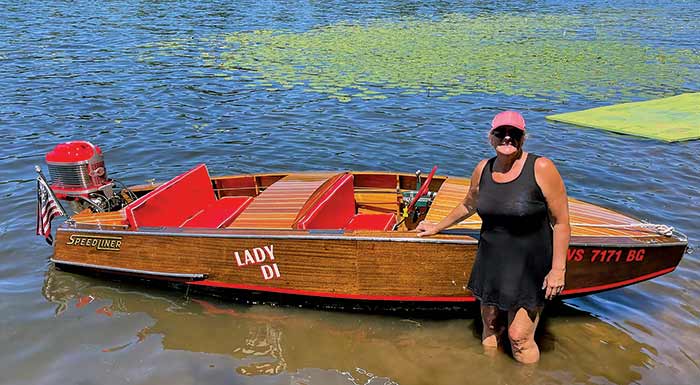
Then soon after I retired in 2018, our daughter spotted this 14-foot Speedliner, circa 1958, with a well-cared-for classic Mercury 40-hp outboard. I thought this could be a great project to take on because it required little or no mechanical work. The boat was in rough shape, with a large hole in the bottom, and the finish was completely distressed. The first summer I set my goal to strip all the hardware and flip the hull to repair the hole and complete the epoxy finish on the bottom before winter. The next summer was committed to stripping all the old finish, bleaching and sanding the complete exterior, and staining the entire boat. The following winter was all about varnish, then sand, varnish, then sand — 13 times!
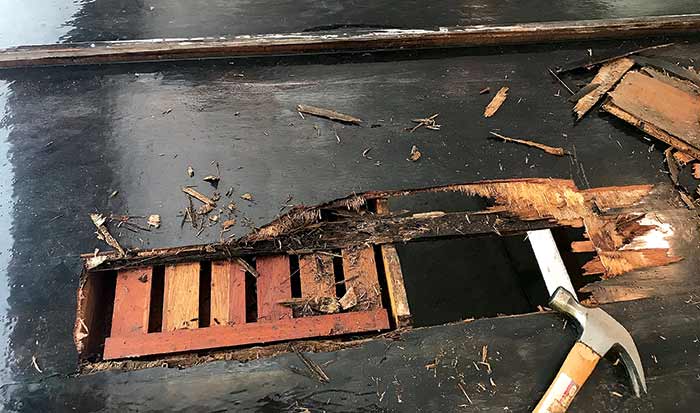
Over the course of two winters and a summer, Resch stripped all of the old finish (left), sanded and bleached the wood, stained, then varnished the entire boat (right). He used a high-quality brush instead of spraying.
As for the 1958 Mercury 45-hp, it couldn't have worked out better. We took it to a local antique engine expert to check it over. He just gave it a tune up, and it was ready to go. We've since repainted the Art Deco-styled Merc a cherry red. We continue to do little things to make it better, and we're still hunting for a period-correct windshield.
Believe it or not, we found the more than 200 hours of work to be totally satisfying. We enjoyed the process and, especially, seeing the results. It's been an amazing project to take on with my wife. Working on it together has given us a wonderful sense of accomplishment. The hardest part was researching the products and processes we should use to do the job right.
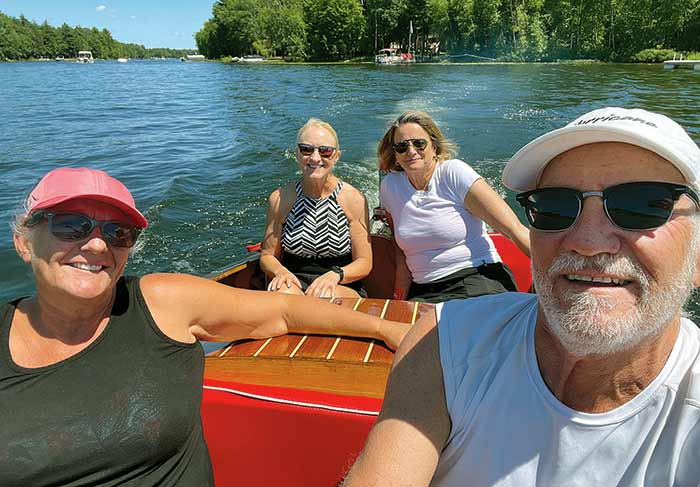
The maiden ride was Labor Day weekend 2020. We love to take rides around our chain of lakes to show if off, and we are now planning to start taking it to some wood boat shows.
— Jeff Resch, Wisconsin
Related Articles
The truth about ceramic coatings for boats.
Our editor investigates the marketing claims of consumer-grade ceramic coatings.
Fine-Tune Your Side Scan Fishfinder
Take your side-scanning fishfinder off auto mode, and you’ll be spotting your prey from afar in no time
DIY Boat Foam Decking
Closed-cell foam flooring helps make boating more comfortable. Here’s how to install it on your vessel
Click to explore related articles
Rich Armstrong
Senior Editor, BoatUS Magazine
A journalist by training, BoatUS Magazine Senior Editor Rich Armstrong has worked in TV news, and at several newspapers, then spent 18 years as a top editor at other boating publications. He’s built a stellar reputation in the marine industry as one of the most thorough reporters in our business. At BoatUS Magazine, Rich handles everything from boat and product innovation and late-breaking news, to compelling feature stories, boat reviews, and features on people and places. The New Jersey shore and lakes of lower New York defined Rich's childhood. But when he bought a 21-foot Four Winns deck boat and introduced his young family to the Connecticut River, his love for the world of boats flourished from there.
BoatUS Magazine Is A Benefit Of BoatUS Membership
Membership Benefits Include:
Subscription to the print version of BoatUS Magazine
4% back on purchases from West Marine stores or online at WestMarine.com
Discounts on fuel, transient slips, repairs and more at over 1,200 businesses
Deals on cruises, charters, car rentals, hotel stays and more…
All for only $25/year!
We use cookies to enhance your visit to our website and to improve your experience. By continuing to use our website, you’re agreeing to our cookie policy.

DIY Boat Restoration: Tips and Tricks for a Budget-Friendly Makeover
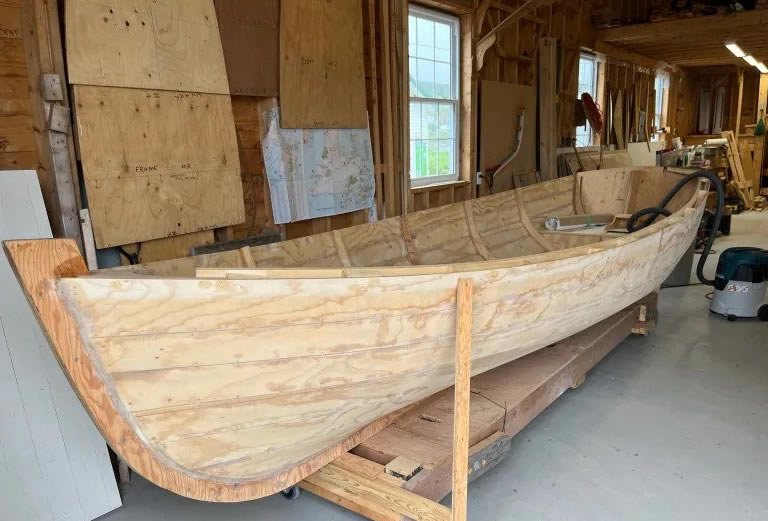
Restoring an old boat can be a rewarding and cost-effective way to breathe new life into a beloved vessel.
While it may seem like a daunting task, with the right tips and tricks, you can embark on a DIY boat restoration project that’s easier on your wallet and more satisfying than you might expect.
Helpful Boat Restoration Guides
1. set clear goals, 2. create a detailed plan, 3. prioritize safety, 4. do your own research, 5. salvage and recycle, 6. budget-friendly materials, 7. diy fiberglass repairs, 8. refinishing and painting, 9. upholstery on a budget, 10. routine maintenance.
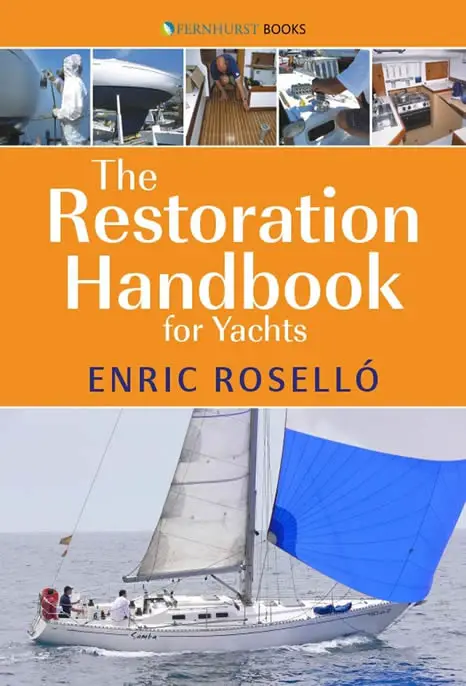
Boat Restoration Guide
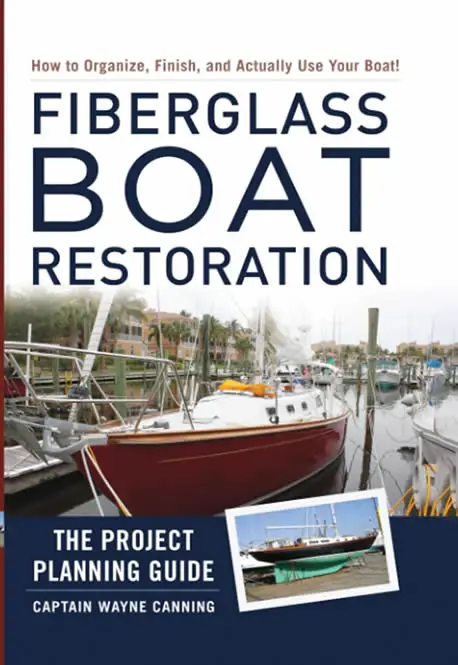
Fiberglass Boat Restoration Guide
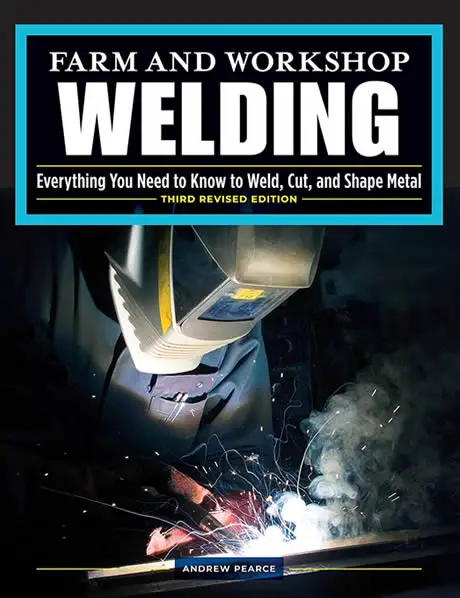
Metal Shape Welding Instructions For Boat Building
10 Tips To Make Boat Restoration Simple
In this guide, we’ll share valuable insights and cost-saving strategies to help you navigate your boat restoration journey with confidence.
Before you dive into your boat restoration, determine the scope of your project.
Are you looking for a complete overhaul or just some minor repairs and cosmetic touch-ups?
Setting clear goals will help you avoid overspending and stay focused on your budget.
A well-thought-out plan is essential. Take the time to assess the boat’s condition and identify areas that require attention.
Create a checklist of tasks, including materials and tools needed.
A comprehensive plan will prevent impulse purchases and keep you on track.
Safety should always be a top priority.
Inspect the boat for structural issues, such as rot or damage, and address them first.
This ensures that your boat is safe for use, and you won’t compromise your safety while on the water.
Become a savvy researcher. Look for DIY boat restoration resources, such as books, online forums, and video tutorials.
Learning from others’ experiences can save you from common pitfalls and provide valuable insights.
When possible, salvage and recycle materials from your boat. Old hardware, wood, and even upholstery can often be refurbished or repurposed.
This not only saves money but also adds character to your project.
Shopping for materials doesn’t have to break the bank.
Consider marine-grade plywood alternatives, explore second-hand stores for décor, and compare prices from different suppliers to find the best deals.
Don’t forget to inquire about discounts or bulk rates.
Many small fiberglass repairs can be done at home.
Learning basic fiberglass repair techniques will save you money on hiring professionals.
Invest in a fiberglass repair kit and follow instructional videos to tackle small cracks or holes.
For cosmetic improvements, you can save money by refinishing and painting your boat yourself.
Proper sanding, priming, and using quality marine paint can make your boat look as good as new. Don’t forget to choose colors that won’t fade quickly under the sun.
Reupholstering your boat’s seats and cushions can be expensive. Consider buying discounted marine-grade vinyl and learning basic sewing skills to make your own seat covers.
Alternatively, look for deals on pre-made seat covers.
After your boat is restored, keep it in top condition by following a regular maintenance schedule.
Routine care will extend the life of your boat and prevent costly repairs in the future.
Embarking on a DIY boat restoration project can be both a labor of love and an excellent way to save money.
By setting clear goals, creating a detailed plan, and implementing these tips and tricks, you can transform your old boat into a source of pride without breaking the bank.
Remember that patience and perseverance are key to a successful boat restoration, and the satisfaction of sailing in a vessel you’ve restored with your own hands is truly priceless.
You may also be interested in reading our guide that shows you how to build a flat bottom boat and also our boat building plans .
Mick McGrath
Recent Content
518 Illustrated Boat Plans
518 boat plans for less than the price of your lunch! MyBoatPlans Reviews MyBoatPlans is a comprehensive collection of 518 boat plans, 40 videos and about 500 pages of boat building guides. I've...
Set Sail with Confidence: Essential Boat Safety Tips for All Ages and Furry Friends
Picture yourself gliding over crystal-clear waters, the wind in your hair, and the sun kissing your skin. The open sea offers endless possibilities for adventure, but before you hoist the sails, it's...
How to restore a classic sailboat
Restoring a classic sailboat can be a fulfilling and rewarding process, allowing you to create a personalized vessel for exploring the open sea with your family.
How to Restore a Classic Sailboat
Restoring a classic sailboat is a labor of love that can bring immense satisfaction and pride to those who embark on this journey. It’s a chance to breathe new life into a vessel that has seen better days, and to create a unique and personalized space for you and your family to enjoy the open sea. In this article, we’ll guide you through the process of restoring a classic sailboat, from finding the right boat to the final touches that make it truly your own.
Table of Contents
Finding the right sailboat, assessing the condition, creating a restoration plan, hull and deck repairs, interior restoration, rigging and sails, electrical and plumbing systems, engine and propulsion, final touches.
The first step in restoring a classic sailboat is finding the right boat. This can be a challenging process, as there are many factors to consider, such as the size, age, and condition of the boat, as well as your budget and personal preferences.
When searching for a sailboat, consider the following:
- Size : Think about how much space you and your family will need, both for living and storage. A larger boat may offer more comfort and amenities, but it will also require more work and expense to restore and maintain.
- Age : Older boats may have more character and history, but they may also require more extensive restoration work. Be prepared to invest more time and money into an older boat.
- Condition : Assess the overall condition of the boat, including the hull, deck, rigging, sails, and interior. A boat in poor condition may be a good candidate for restoration, but it will also require more work and expense.
- Budget : Determine your budget for both the purchase of the boat and the restoration process. Keep in mind that restoration costs can quickly add up, so it’s important to have a realistic understanding of what you can afford.
Once you’ve found a sailboat that meets your criteria, it’s time to assess its condition in more detail. This will help you determine the extent of the restoration work required and whether the project is feasible for your budget and skill level.
Consider hiring a marine surveyor to conduct a thorough inspection of the boat. They can provide valuable insights into the condition of the hull, deck, rigging, sails, and other components, as well as identify any potential safety issues or structural problems.
Take note of any areas that require immediate attention, such as leaks, cracks, or signs of rot. These issues should be addressed before any cosmetic work is done, as they can compromise the integrity of the boat and lead to more serious problems down the line.
With a clear understanding of the boat’s condition, you can now create a restoration plan. This should outline the work that needs to be done, the order in which it should be completed, and an estimated timeline and budget for the project.
Start by prioritizing the most critical repairs, such as fixing leaks or addressing structural issues. Then, move on to less urgent tasks, such as cosmetic improvements and upgrades.
Be realistic about your abilities and the amount of time you can dedicate to the project. Restoring a sailboat can be a time-consuming and labor-intensive process, so it’s important to have a clear understanding of what you’re getting into before you begin.
The hull and deck are the foundation of your sailboat, and any issues with these components should be addressed as soon as possible. Common problems include cracks, blisters, and signs of rot or corrosion.
To repair cracks or holes in the hull or deck, you’ll need to clean the area thoroughly, remove any damaged material, and fill the void with an appropriate filler or epoxy. Once the repair has cured, sand the area smooth and apply a protective coating, such as paint or gelcoat.
For more extensive repairs, such as replacing large sections of the hull or deck, it may be necessary to consult with a professional boatyard or shipwright. They can provide guidance on the best materials and techniques for your specific boat and ensure that the repairs are done correctly.
Restoring the interior of your sailboat can be a rewarding process, as it allows you to create a comfortable and personalized space for you and your family. Start by assessing the condition of the interior, including the cabinetry, upholstery, and flooring.
If the cabinetry is in good condition, you may be able to simply refinish or paint the surfaces to give them a fresh look. If the cabinets are damaged or outdated, consider replacing them with new, custom-built units that meet your needs and preferences.
Upholstery can be cleaned or replaced, depending on its condition and your personal taste. New cushions, curtains, and other soft furnishings can make a big difference in the overall appearance and comfort of the interior.
Flooring options for sailboats include marine-grade carpet, vinyl, or teak. Choose a material that is durable, easy to clean, and complements the overall aesthetic of the boat.
The rigging and sails are essential components of your sailboat, and their condition will have a significant impact on the boat’s performance and safety. Inspect the rigging for signs of wear or damage, such as frayed lines, corroded fittings, or bent or cracked hardware. Replace any components that are in poor condition or no longer meet safety standards.
Sails should be inspected for tears, fraying, or signs of UV damage. Small repairs can often be made with sail tape or by sewing, but larger issues may require professional repair or replacement. Consider upgrading to modern sail materials and designs for improved performance and durability.
The electrical and plumbing systems on a classic sailboat may require updating or replacement to meet modern standards and ensure safety and reliability. Inspect the wiring, switches, and electrical components for signs of wear or damage, and replace any outdated or faulty parts.
Plumbing systems should be checked for leaks, corrosion, or other issues. Replace any damaged hoses, fittings, or fixtures, and consider upgrading to modern materials and designs for improved performance and ease of maintenance.
The engine and propulsion system are critical to the performance and safety of your sailboat. Inspect the engine for signs of wear or damage, and perform any necessary maintenance or repairs. This may include changing the oil and filters, replacing belts or hoses, or overhauling the entire engine.
The propeller and shaft should also be inspected for signs of wear or damage, and any issues should be addressed promptly. Consider upgrading to a modern, efficient propulsion system for improved performance and fuel efficiency.
With the major restoration work complete, it’s time to add the final touches that make your sailboat truly your own. This may include installing new electronics and navigation equipment, adding custom artwork or graphics, or outfitting the boat with personalized accessories and gear.
Take the time to celebrate your hard work and enjoy the fruits of your labor. Your restored classic sailboat is now ready for new adventures and memories with your family.
Restoring a classic sailboat is a challenging but rewarding endeavor that can provide you and your family with a unique and personalized vessel for exploring the open sea. By carefully assessing the condition of the boat, creating a detailed restoration plan, and tackling the project one step at a time, you can breathe new life into a once-neglected boat and create a lasting legacy for future generations.

Boat Refitting (Restorations)
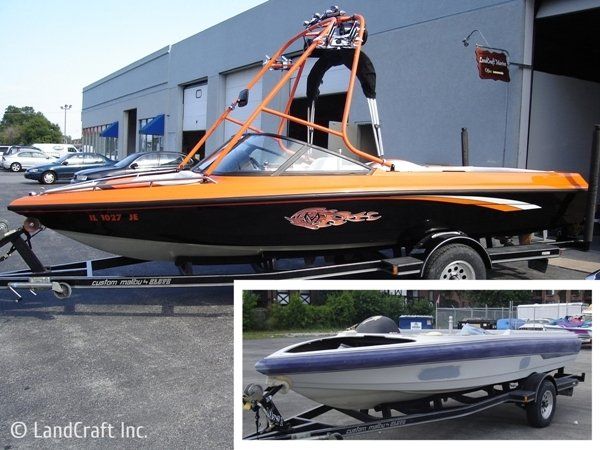
Slide title
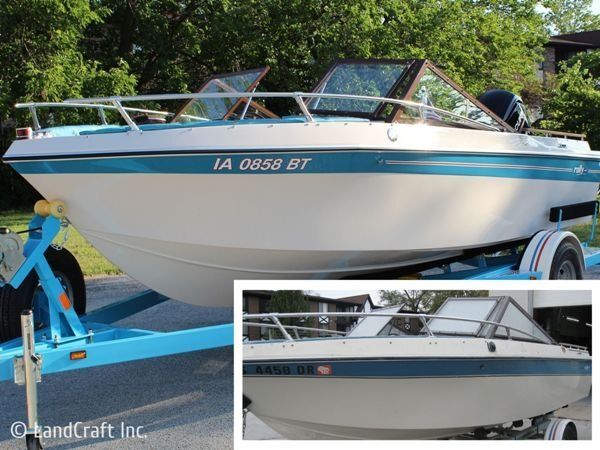
Check out pictures of our work!
Tell us about your repair needs.

Copyright © 1978-2024 LandCraft, Inc.
All Rights Reserved. Unauthorized Use of Pictures and Content is Prohibited.
Boat & Jet Ski Repair
Boat Restorations
Fabrications
RV Fiberglass Repair
Industrial Fiberglass
Fiberglass Vehicle Services
Other Fiberglass Services
Insurance Claim Handling
PHOTO PORTFOLIOS
Boat Repair Pictures
Boat Restoration Pictures
Fabrication Pictures
RV Repair Pictures
Industrial Repair Pictures
Other Fiberglass Pictures
LandCraft Shop Tour
Row4Kids Event Pictures
USEFUL LINKS
Career Opportunities
News & Press
Boater Resources
COMPANY INFORMATION
LandCraft Inc., Established 1978
1604 Caton Farm Rd.
Lockport IL 60441
(708) 385-0717
Privacy l Terms l Accessibility

"LandCraft" is a trademark of LandCraft Inc registered in the U.S. Patent and Trademark Office and may be registered in certain jurisdictions.
Web design by SmallBee.com
- 2024 BOAT BUYERS GUIDE
- Email Newsletters
- Boat of the Year
- 2024 Freshwater Boat and Gear Buyers Guide
- 2024 Boat Buyers Guide
- 2024 Water Sports Boat Buyers Guide
- 2024 Pontoon Boat Buyers Guide
- Cruising Boats
- Pontoon Boats
- Fishing Boats
- Personal Watercraft
- Water Sports
- Boat Walkthroughs
- What To Look For
- Watersports Favorites Spring 2022
- Boating Lab
- Boating Safety

Guide to Boat Upholstery Renovation
- By Jim Hendricks
- December 17, 2021
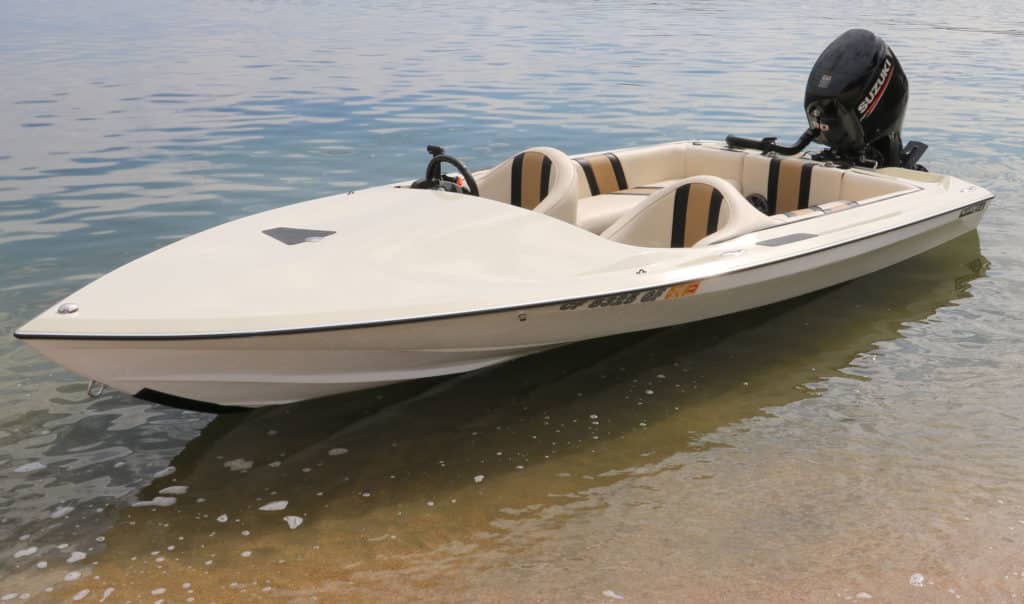
Re-upholstering a boat exceeds the skill level of most DIY boaters. For this kind of project, most of us need the help of a qualified marine upholstery shop. This is especially true for a project that encompasses the total replacement of the upholstery, a task that includes the engineering and fabrication of the upholstery framework, as well as design and crafting of the fabric coverings.
Such was the case as we entered the final phase of a complete restoration of a 1977 outboard-powered 17-foot Witchcraft runabout, a project that started with gutting the interior, including the original, but now rotted, seating, side and transom panels, and other upholstery parts. For guidance on how to proceed with replacing the upholstery, we turned to Sunbrella Horizon, which offers a broad line marine vinyl upholstery fabrics. Bill McDaniel, marine market manager for Sunbrella Horizon, offered these tips.
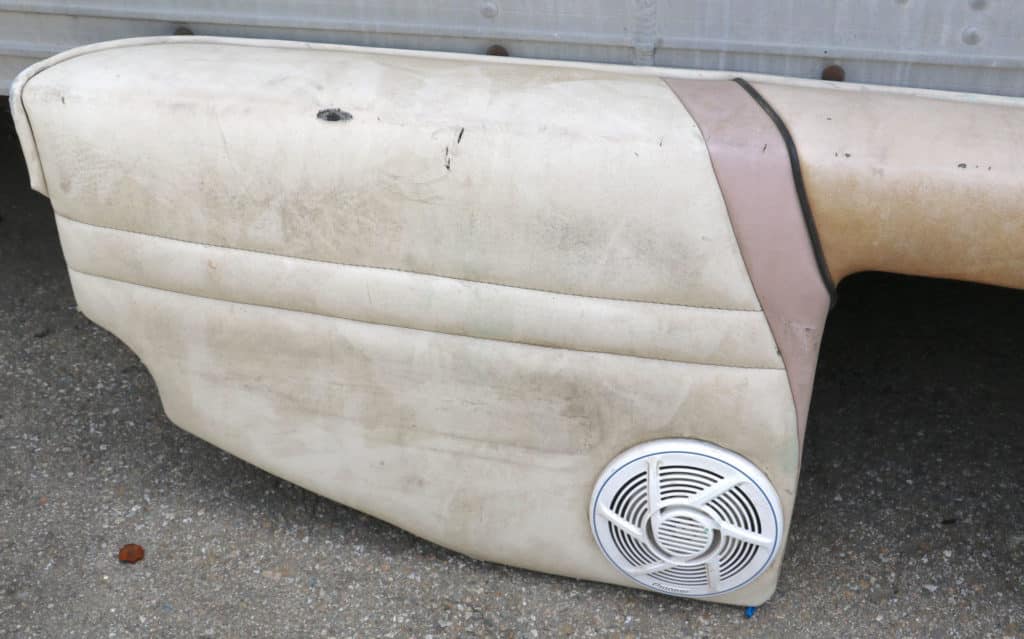
Quality Shop
As mention before, you’ll need assistance from a marine upholstery shop. But how do you find one? “A good place to start in identifying a marine upholstery fabricator is to ask local boating organizations or your marina to provide recommended partners,” McDaniel says. “Another option is to check in with the boat manufacturer or dealer.” While these sources may not always be able to do the work themselves, they can likely point you in the direction of a trusted partner shop or local fabricator.
“Also, don’t forget online resources including social media and review websites such as Yelp where you can find testimonials and past experiences from other customers,” McDaniel adds. In our case, we chose SoCal Upholstery in Montclair, California. While the shop was about 40 miles away, it came highly recommended by a number of boat dealers, as well as local boat builders, for quality design and fabrication.
Key Questions
Before work starts on your boat upholstery project, it’s important to ask the right questions to be sure the fabricator understands your goals and you know exactly what you to expect, McDaniel points out. He suggests start with questions such as:
- Can you walk me through your fabrication process?
- Are you able to assist with design?
- How long do you estimate it will take to complete the work?
- Have you worked on this type of craft before?
- What type of information is most helpful for me to provide throughout the process?
- Do you provide any type of warranty on the work?
Following the discussion, request a written or documented estimate and ask questions about what is included in the quote and what factors could affect it before you sign off on the project, McDaniel says.
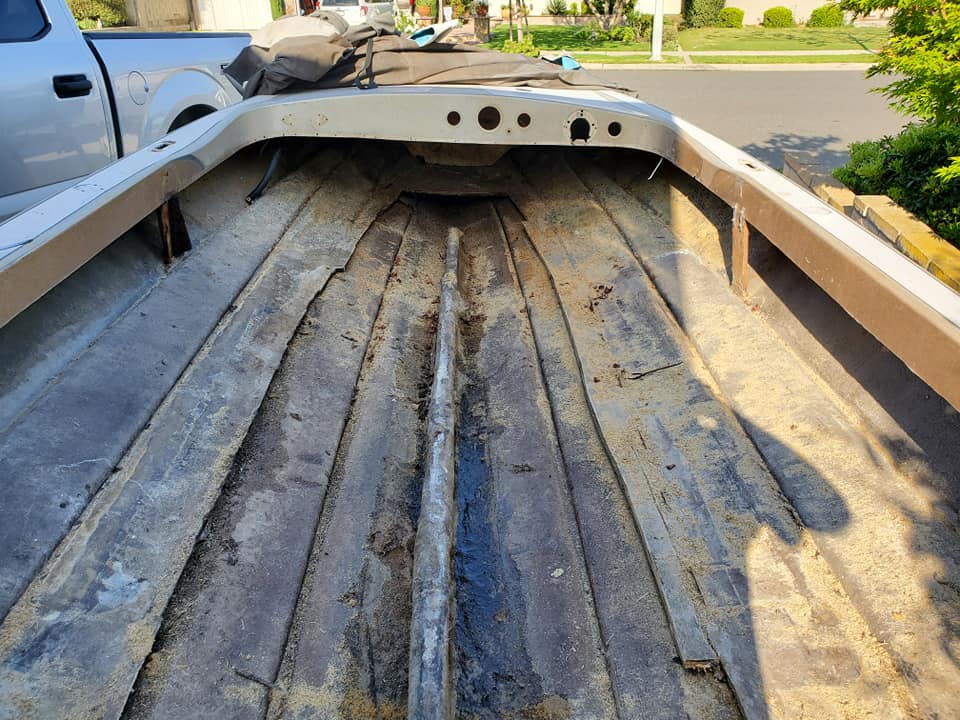
Framework: Re-use or Replace?
Whether or not the existing upholstery framework can be used will depend primarily on the reason for re-upholstery and the overall state of the boat. “It also may depend on which part of the boat you are updating,” McDaniel explains. “In many cases, it’s possible to apply new marine fabrics on an existing frame; however, you will want to be sure there is no damage or underlying issues.”
It’s important to have the framework inspected by an expert, so be sure to bring this up with your fabricator. Just like a home or building, having the right foundation is essential for long-term use and enjoyment. In our case, we decide that the old wood frame work was 45 years old and rotting, so we decided have the shop build all new frames.
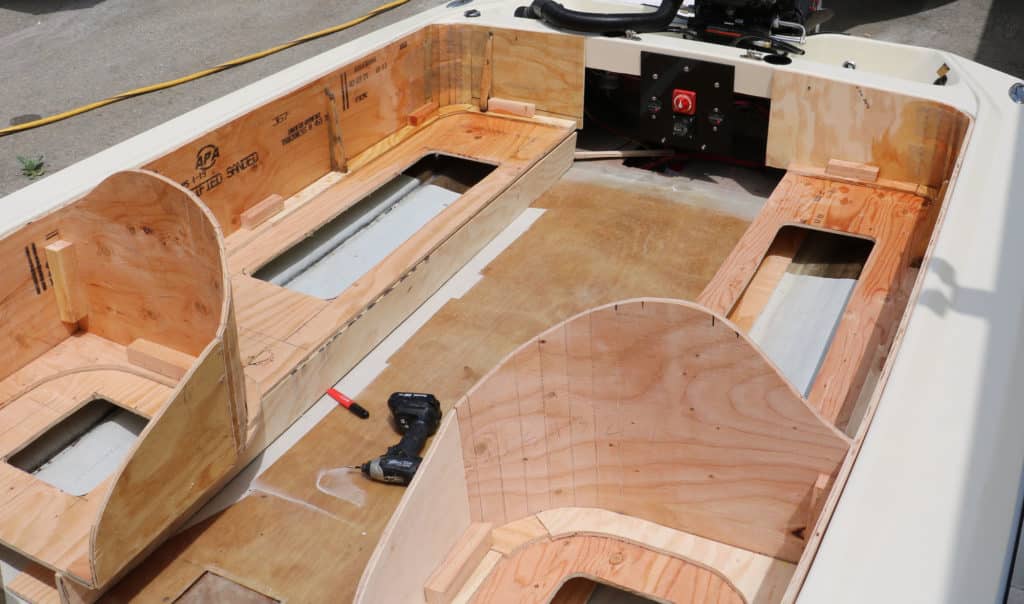
Frame Material
The material used for upholstery framework will depend on the type of boat, the craft’s age, the original materials, and your fabricator’s preferences. Framing the structure for a captain’s chair or helm chair is a different application than framing for main seating areas, such as the bow area. Typically, specialty woods like mahogany or teak are used for captain’s or helm chair structures. “Be sure to discuss your options with your fabricator partner before starting the project,” McDaniel advises. In our case, we chose plywood, which was coated with resin after construction to prevent water damage in the future.
Staple Supply
“Quality staples play an important part in marine upholstery work, alongside a strong framing material, quality fabric, the right foam cushioning and durable thread and adhesives,” McDaniel points out. In our case, we asked the fabricator to use stainless-steel staples to help prevent corrosion.
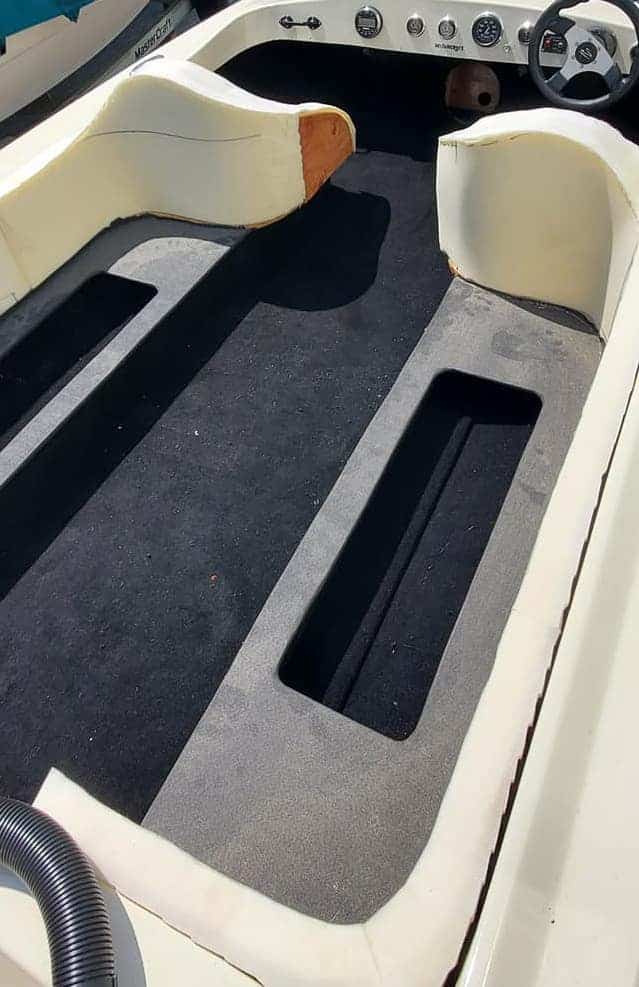
Colors and Design
Most fabricator include the design and color selection as part of their prices. “To make sure you’re happy with the outcome, it’s important to brief your shop about the goals of your project and the desired look for your boat,” McDaniel says. “Inspirational photos are especially helpful in providing a starting point.” Don’t forget to share the ideal look and feel for your boat seating along with examples of how you commonly use your boat, such as fishing or entertaining.
You will also want to discuss your goals for the entire look of the boat and where you want coordinating materials to be used, McDaniel adds. “For example, Sunbrella offers most marine fabric in matching colorways, meaning it’s easy to coordinate new upholstery fabric with existing fabric you plan to keep or other fabric on the boat, such as a Bimini top,” he points out. Using your input as well as the background on your boat and their expertise, your fabricator will be able to make smart fabric recommendations. From there you can work together to fine-tune the design before work begins, as we did with our restoration project.
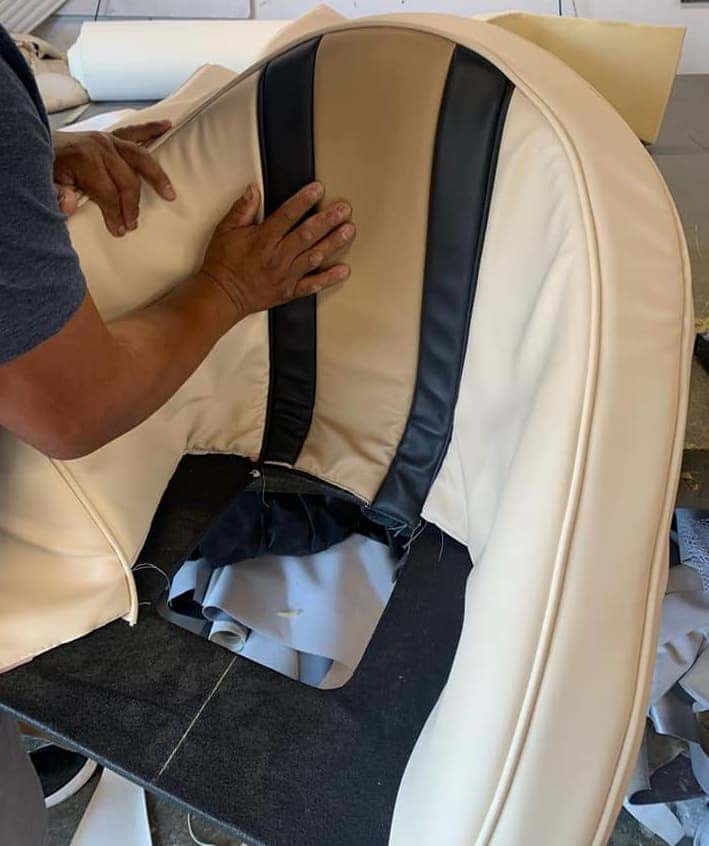
Fabric Brand
Should you specify the marine vinyl fabric brand or trust the fabricator to select it? “You and your fabricator should work together to select the right fabrics for your boat,” says McDaniel. “Like any good partnership, it’s a team effort. We always advise boaters to lean on their fabricators for recommendations but also ask questions and explore options before making a purchase decision.
“Fabricators take great pride in their work and the process should be fun,” he adds. “Treat them as a partner, get involved and you’ll get great counsel and see great results.”
Fabric Quality
When considering a marine upholstery vinyl fabric, boaters should think about quality, longevity, design and support, according to McDaniel. “Investing in a high-quality fabric will give you the peace of mind to enjoy your boat upholstery without worrying about harsh marine conditions or potential damages or spills,” he explains. The investment upfront means longer lasting boat seating, and limiting the need for costly replacements that might put your boat out of commission for long stretches of time.”
McDaniel also points out the need to care for and maintain any marine upholstery. “Make sure the fabric you select comes with support after purchase, including care and cleaning resources and comprehensive warranties,” he says. “Sunbrella fabrics are the most trusted and preferred choice and are backed by the most comprehensive warranties in the industry.
“For example, Sunbrella Horizon marine vinyl is backed by a five-year warranty that covers replacement fabric and labor costs, along with a three-year warranty against bacterial pink staining.”
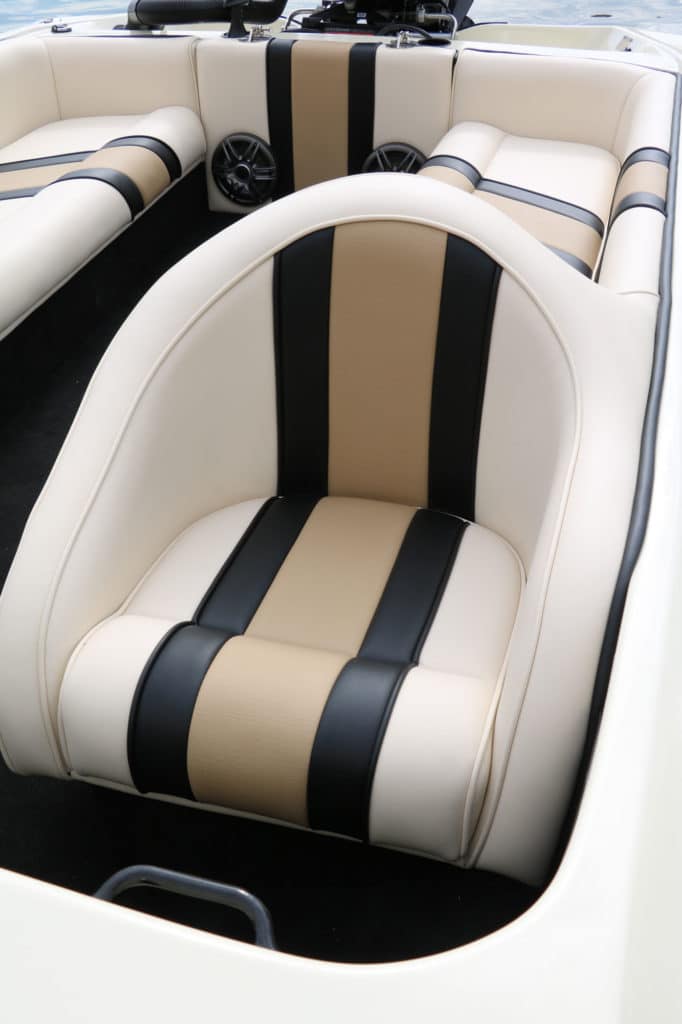
Marine Foam
When it comes to upholstery foam, good fabricators typically have a few types of foam on hand in a variety of densities to be sure they’re using the best material for the job, McDaniel says. These foams include polyurethane, Dryfast and closed cell foams. “Foam is an important element for seating, providing support and flexibility allowing for all-day comfort,” he explains. “Ask your fabricator about the foam type and density they recommend for your boat and why.”
Thread Choices
Polyester, nylon and monofilament threads each have unique benefits that could make them the right fit for your craft, and good fabricators know which to use, as well as where and when. “Like fabric, thread serves a functional and stylistic role,” McDaniel reveals. “Talk to your fabricator about contrasting thread colors, piping styles and patterns they can sew into your seating for an even more custom look.”
Ultimately, re-upholstery isn’t something you’ll likely do often, and the process does take time, McDaniel points out. “It’s important to start the conversation with your fabricator and plan for the upgrades and an ideal time for work to begin, as you’ll be without your boat,” he adds.
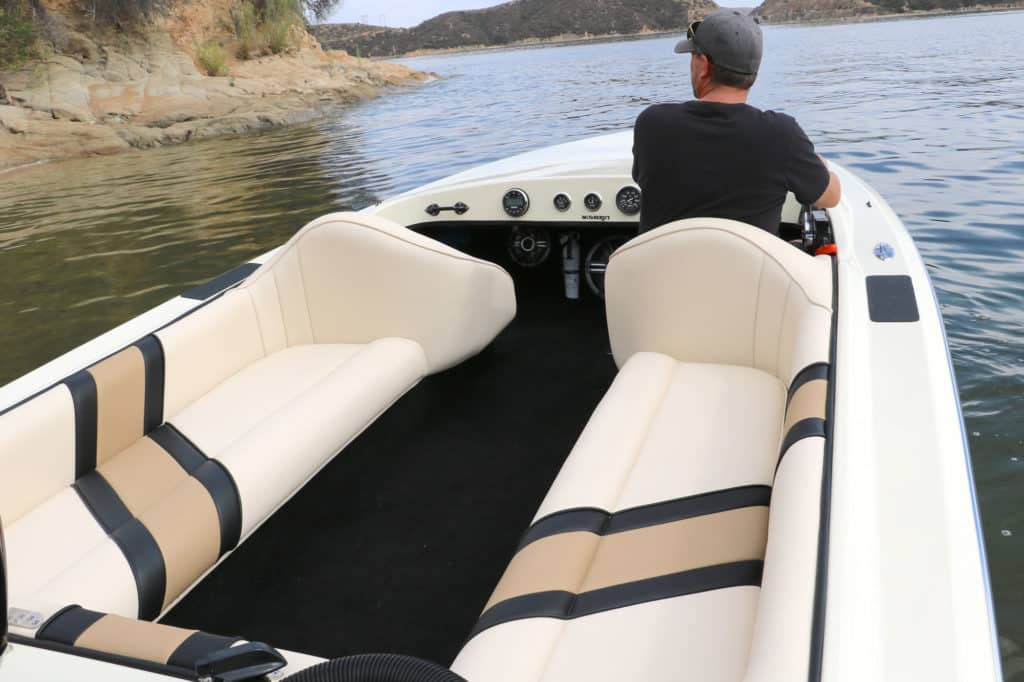
Right Attitude
“View the improvements on your boat as an investment rather than an expense, and select quality materials and crafts people to work on your boat,” McDaniel says. “This is an exciting upgrade for years of comfort and memories and taking good care of your boat now will ensure it takes good care of you and your passengers.”
- More: diy projects , How-To , Used Boats , vinyl
More How To

Boaters Expect More Hurricanes in 2024

U.S. Hurricane Names Selected for 2024

After a Devastating Loss, One Family’s Resilience Leads to a Lifesaving Rescue

How to Avoid Lightning Strikes While Boating
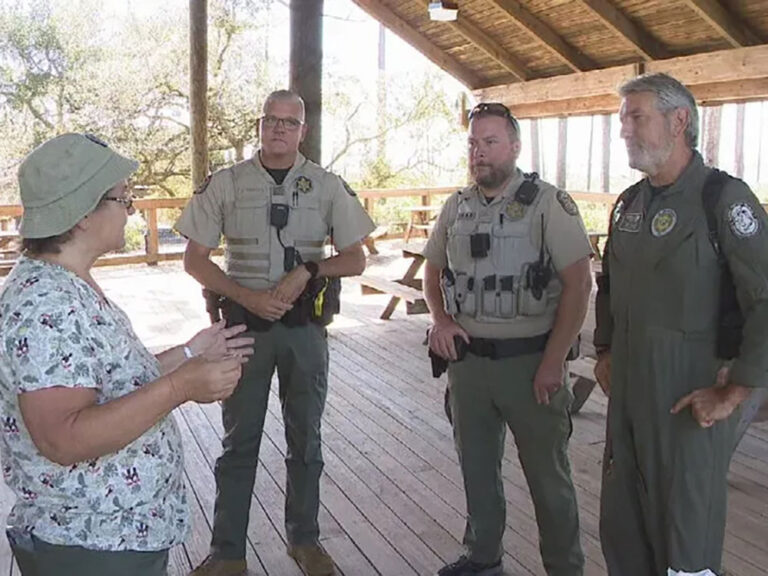
On Board With: Alexa Score
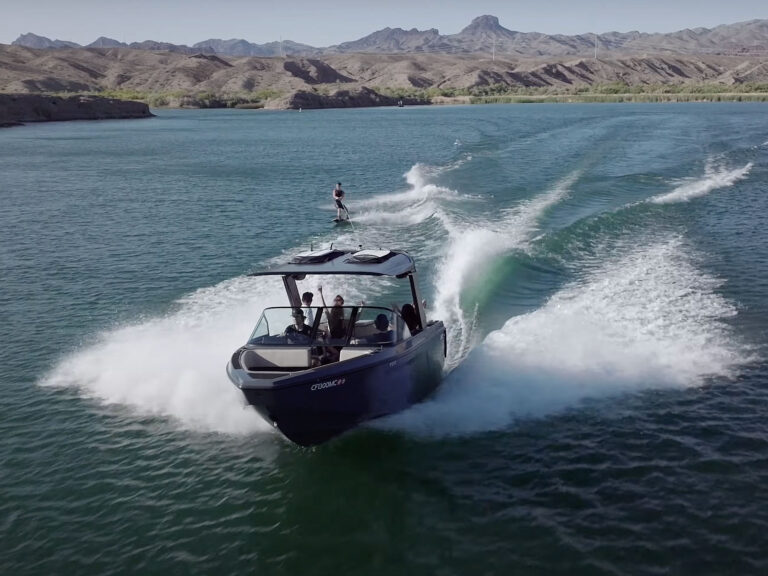
Arc Boats Optimizes Electric Power

- Digital Edition
- Customer Service
- Privacy Policy
- Cruising World
- Sailing World
- Salt Water Sportsman
- Sport Fishing
- Wakeboarding
Many products featured on this site were editorially chosen. Boating may receive financial compensation for products purchased through this site.
Copyright © 2024 Boating Firecrown . All rights reserved. Reproduction in whole or in part without permission is prohibited.
May / June Issue No. 298 Preview Now
Leo Goolden and the TALLY HO Restoration
By tom jackson.
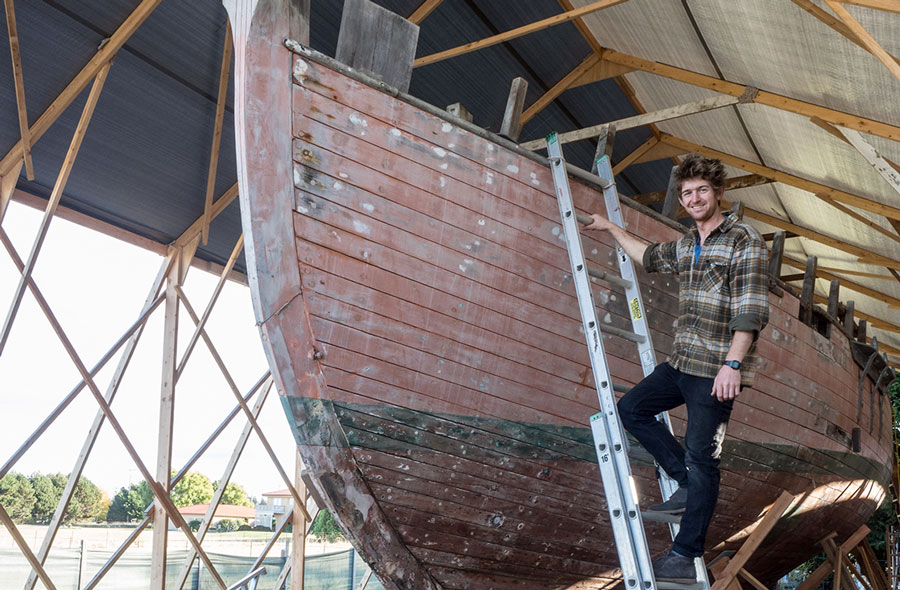
DIETER LOIBNER In Sequim, Washington, Leo Goolden is charging ahead with the restoration of TALLY HO, a 47′6″ Albert Strange yacht from 1910 that had been facing destruction in Brookings, Oregon. He works with friends and volunteers, and his videos have become an integral part of the process.
In November 2018, WoodenBoat Senior Editor Tom Jackson visited Leo Goolden at the workshop in Sequim, Washington, where he is reconstructing the 1910 Albert Strange yacht TALLY HO. Goolden, a native of England who learned boatbuilding in yards in Bristol and Cornwall, wrote in WB No. 267 about the daunting task of replacing the 48′ LOA yacht’s timber keel. In that same issue, Jackson also wrote about Goolden and three other boatbuilders in their 20s and early 30s who have taken on significant boatbuilding challenges. Here is Jackson’s interview with Goolden, edited for length and clarity:
First of all, how did you start in boats, when and where, and how did that come to you?
Leo: Well, it was kind of late, by some people’s standards. I didn’t really have any experience until I was about 20, although I’d always been very adventurous, I guess, and sort of liked the idea of the sea and being on it. I was traveling for a couple of years, between the ages of 18 and 20, and it was while I was on that trip that I was kind of trying to figure out just what I wanted to do with my life, or what I wanted to do when I got home. I put off a place at university to keep traveling, and I had sort of figured out that I didn’t want to do that. I didn’t sail on that trip. I took a few sort of ferry rides, and just kind of really enjoyed that way of traveling, actually, and I got really sick of buses and hitchhiking, and airplanes.
What countries were you in?
Leo: So, I traveled through Asia, India, Southeast Asia, Indonesia, and spent a bit of time in Australia and New Zealand as well. It was really probably the best thing I ever did, because it led me on to sort of follow my own path since then. I don’t even really know where it came from, but I had this idea about building wooden boats. I knew I wanted to do something with wood, or with my hands. I had a bit of carpentry experience just from growing up at home, and just hanging out with my dad. He does a lot of that. And I did a few things while I was traveling like basic construction jobs. I’ve always enjoyed making stuff. I figured I’d like to do something like that.
Where in England did you grow up?
Leo: In Somerset, in the southwest. It’s rural. Although I was born in Bristol, there isn’t much sailing there these days, except for dinghies on the docks, and it’s a hugely important historical maritime port. And so I grew up just outside Bristol, really. But the idea of traveling by boat, and being able to work and build them, and being able to maintain your own boat—and specifically a wooden boat—it just seemed such a romantic and beautiful way of life, and that was cool. And enjoyable.
So the boatbuilding idea came to you even before sailing?
Leo: Yeah. The two ideas came kind of intertwined. But they both came before I’d actually done any sailing. So I went home with that goal in mind. I went back and stayed with my dad for a bit, and I was looking into doing a course, maybe at IBTC [International Boatbuilding Training College, in Lowestoft], but at the time I couldn’t afford it. I didn’t have any money, having been traveling; I came back skint. I was looking into grants, and not sure what I’d do. Anyway, I ended up in Bristol just wandering around one day, and went to the Underfall docks, which at the time was the only boatyard in Bristol. It’s the historic part of the Bristol docks, and you can just walk through it, next to all the sheds. I just went in and started asking around, and one of the guys who works there, John Raymond Barker, he agreed to take me on as an unpaid laborer apprentice. I was staying at my dad’s, but just a few days later I moved up to Bristol.
You were 20 at this time?
Leo: Yeah. I lived under a flight of stairs in my friend’s basement in the nastiest part of Bristol for a few months. And then, after working for John for maybe three months, one of the guys who was working in the same shed invited me to go sailing with him on this three-masted cornish lugger called PEEL CASTLE. That was down in Spain. So I went and I spent two or three months with him. And that was actually my first sailing experience apart from dinghies off the dock in Bristol. And then, after that, I just started getting more and more experience with the other guys in the yard, because they all had their own wooden boats, or on the boats that John had previously built. Eventually, the boat I was building, we took that out for sea trials. She’s called EDITH GRAY. She’s a pilot cutter, but it is kind of John’s own take on the pilot cutter design. He redid the lines, which are more extreme than traditional pilot cutters. She had a very deep keel. She was very fast. She was good.
And after Spain? Back to Bristol for the boatyard again?
Leo: Back to Bristol. I couldn’t bear to move back into this terrible house with these student friends of mine, so for two days I was walking every inch of the docks, basically, and asking about all the boats that were abandoned or semi-abandoned, finding out who owned them, and asking if I could do some work on the boat in exchange for living on it. Eventually, I found a boat that belonged to an eccentric woman. She was elderly and had gone into care. I managed to get in touch with her brother, they were trying to sell the boat, so I moved on. It was gross, it was terrible in there. But I got everything cleaned up and did a bit of work, and I ended up living there for a year before it sold. It was really good.
And that was rent free at that time—and you were still not getting paid at the yard?
Leo: No, but I was doing work in the evenings, and that sort of stuff. That’s kind of where I started, and then I started buying my own boats after a bit of time.
To work on them and sell them?
Leo: Well, I just wanted to get off on an adventure, really. I wanted to get sailing, having started to learn a bit more about it. So the first boat I bought was basically the cheapest, most practical thing I could find, which was a 19′ fiberglass centerboard sort of daysailer, really. She had a little cabin, with a V-berth. You could actually sleep four people in there. I did a bit of work on that—replaced the woodwork, basically, the hatches and stuff. And then I was kind of planning on sailing that down to France and then maybe doing the inland waterways. But even at that stage I really liked the idea of crossing the Atlantic. I was still working for John at that point, and he had crossed the Atlantic on the boat that he restored. He also owned a Folkboat. He was telling me all about it, and telling me that Folkboats had crossed the Atlantic, and they’re pretty small but very seaworthy, easy to sail, all this stuff. And then one came up for sale down in Cornwall. And so I went down to look at it. So I spent all the money—at this point I’d managed to save enough money to go off traveling, but I spent that on a Folkboat instead. The only real sailing that I did on the first boat, apart from around the docks and on the river, was down to Cornwall to pick up the Folkboat, LOREMA. But that was a pretty serious trip for a 19′ boat—around Land’s End.
So you were doing that in your spare time, still working for Barker?
Leo: When I went down to Cornwall to pick it up, I left Bristol for good really. So I left that job then, although I could never really consider it a job. I put all my belongings on that boat. The idea was just to swap boats over in Cornwall and just keep on sailing.
So the boat was ready for sea—it didn’t need any work?
Leo: Well, it was floating. You know, as so often happens, in my excitement about owning a wooden boat, I neglected to really get it surveyed properly. I did look at with a boatbuilder friend, but both of us missed quite a lot of stuff. I sailed it a few times in the area. Actually, I sailed to the Scillys and back. In all that time, I didn’t hit any heavy weather at all. Not even heavy weather, but anything over Force 3, really. And then the first time I sailed in slightly heavier winds, I think it was a 5, the mast snapped. So the topsides were basically all rotten because, as pretty common with Folkboats, the chainplates go through the deck, and they let fresh water in, and rot spreads. The beam shelves were pretty much gone. All the topside planks—it was worst at the top and gradually less and less rot down to the waterline.
The chainplate pulled out, that’s what caused the mast to fail?
Leo: Yeah. In fact, it’s pretty crazy, but the chainplates were only fastened through the planks. I have no idea if that’s common on Folkboats, I mean I assume not, because I’ve not really heard of that happening a lot. The other Folkboats I’ve seen have been through the frames, as you’d expect, but they’ve mostly been later Folkboats. I owned another Folkboat for a little bit, but it was an East German–built, strip-planked. The first one was ’47—quite early.
So that was your first experience with ‘destructive testing?’
Leo: Yeah, I guess so. In that instant of the mast snapping, I had all these plans of going south. And suddenly it’s like, oh, okay. It’s going to be very different for the next couple of years, or however long, to what I’d expected.
So you went back to Cornwall?
Leo: Well, I was in Cornwall at the time. I was near Falmouth, and I took the boat to Gweek, which is up the River Helford. I’d heard good things about the yard, and that was where Luke Powell was working, and Ashley Butler had just started working there or had just bought the yard, or was in that process. So that’s where I met Ash, and Luke, and various other people. I did a lot of repairs on the boat: replaced most of the topside planks, quite a few frames, about half the deck, the transom, the bottom part of the mast, hatches, one of the beam shelves. I lowered the bunks. I raised the cockpit to make it flush-deck. I kept the coaming around it. That turned out to be one of the best things I did, I think. I was pretty happy with that in the end.
Because of when you were at sea?
Leo: Yeah, I shipped a lot of waves, and Folkboats have very large cockpits, and I sure it would have affected the stability. It might have done some damage, and it might have turned out badly. And then, it’s just quite comfortable, I quite enjoyed sitting on the flush deck. the other thing was that I had so much space below deck. I used all the storage, I had tools, bicycles, all sorts of stuff in there, guitars.
Did you start getting pick-up work at the boatyard with Ashley Butler?
Leo: Yeah, that’s right. I started working for Ash. I’d work for him in the daytime, and then work on my boat in the evenings and weekends. It was great because he was very flexible, and very supportive, really, of what I was doing. He’d done similar things. So I used to ask him a lot of advice. In fact, I had Ashley there, I had Luke Powell there, and there were a couple of other pretty good boatbuilders in the yard. So if I had a problem, I’d go around and ask them all.
Did you get the same answer?
Leo: No, never! But I could pick and choose the one that made the most sense to me.
Was that a full-time job with Ashley, or on call?
Leo: It was more or less full time, in that he was keen for me to work as much as possible because he had some big projects and had a lot going on. But I just recorded my own hours. I just worked as much with him as I needed to and then spent as much time on my own boat as I could.
Were you able to live aboard?
Leo: In the beginning I was. And then when I had the planks and the deck off, I moved out and stayed in various places, someone else’s boat for a while, and again did a bit of cleanup on that as payment. Then I rented a little shack up the road for a little while. When I launched the boat, I moved back on. I guess that was a little under a year, about 10 months doing that. It was great, because I learned a lot from working with Ash and having the support of those boatbuilders. Ash would give me materials for a really good price, or offcuts for free if he could. I had decisions to make about whether to put an engine on. She had an outboard, or at least a bracket, when I got her. I had an outboard, and decided not to put that on. So she was engineless. I made a scull, and put my windvane on from a previous boat. Then I launched and sailed off. That was 2014.
So you were 23?
Leo: Yeah. That summer, I went up to Ireland, which was the maiden voyage of the boat as relaunched. I went to the Scillys first, then to Ireland. I have some family in Cork, so stayed there a bit, and just cruised around.
Did you find things to still work on?
Leo: It went pretty well, actually. There’s always things you’re tweaking and improving. I launched the boat and just wanted to get going. So none of the brightwork was done, and stuff like that. But she was sailing, and at least I knew she was strong—and I had the chainplates bolted through the frames.
So this was your first big adventure on your own boat.
Leo: Yeah. And that was amazing—first time sailing alone, really. I’d done a couple of really short bits, but really the first time properly going off on my own in the boat. The self-steering worked great. I had a couple of times of plenty of wind. My first night passage as well. And yeah, it was pretty good. I ended up back in Cornwall for a bit. I remember that first trip to Ireland, I remember that feeling—when you’re in a project, you’re kind of constantly stressed. Which isn’t necessarily a bad thing—it’s just that’s sort of what makes you keep going all the time. You never sit down with just the intention to just sit down and then “be.” But I remember on that trip, I went to the Scillys, which was a really hairy sail for me, because I was just getting to know the boat again, and there was heavy wind out of the east. I was on a run, and just figuring out how to reef and things like that.
Had you done enough with other people by then to be confident of your navigation ability and boathandling?
Leo: Yeah, I think so. I was still figuring out a little bit, and still making mistakes. But I knew enough to get by. I’d been doing quite a lot of deliveries as well. During the time in Cornwall, some of the people I met there were doing deliveries, so I went off with them. Later on, I did my yacht master [licensing classes] as well, while I was in Cornwall. It’s British, but it’s recognized worldwide, more or less. I think I did my first delivery skippering around that time. So yeah, I was fairly confident, I suppose. It’s a bit different on a boat without an engine, so I was still sort coming to grips with that. And then I remember the sail from the Scillys, after that fairly hairy sail, from there to Ireland, I remember for the first time having that feeling of, “I can actually relax.” The self-steering was doing its thing. The sails were set. You could just sit there and have a drink and enjoy it.
Then you start looking at the brightwork thinking you could probably finish that.
Leo: Exactly! But luckily you can’t do that while you’re sailing. Well, you could sand it I suppose.
How long was it after you got back to Cornwall before you started the transatlantic?
Leo: I went back for the winter. I did some more work. I was involved with the KELPIE rebuild, the schooner, and a couple of other things. [KELPIE OF FALMOUTH is a 1928 schooner, 65′ LOD.] Then I set off. I didn’t initially tell people I was going to try to cross the Atlantic, although I had the idea in the back of my head, I think. But I went to France first, in convoy with some friends, and did all the Brittany coast, Brest and Douarnenez, the festivals. Brittany is just amazing. The festivals are amazing. The whole coastline is just so beautiful, and such great sailing, and challenging, since there’s so much tide there.
Then, just sailing around?
Leo: I kept heading south, really, down inside of Biscay and across, because I had some friends there, and went around the areas in northwestern Spain and Portugal, just cruising, and trying to enjoy it, and meeting lots of people, getting to know the boat better, and certainly getting better at navigation—because my GPS broke right off of Cape Finisterre, actually. Just as I was leaving, I turned my GPS on—or I tried—it didn’t come on. At that point I nearly turned around to find one or fix it. And then I just thought, “I don’t know, I’ve got the charts, I’ve got the compass. Come on—are you a sailor?”
Did you use celestial navigation?
Leo: I did try and take some sights across Biscay, but I didn’t really quite nail it. I had the GPS then, so I kept checking it to check my calculations, and they were always wrong. So I never figured it out, you know? So from Finisterre south, it was all coastal navigation, and that was great. I really enjoyed getting more confident at that, and realizing you don’t always necessarily know exactly where you are, or have to know where you are, and that’s okay sometimes, as long as you know where you’re not—you’re not near this or that. And then the feeling of achievement you get. So that was great, and then I went down to meet my ex-girlfriend in Porto, in Portugal, and then we sailed down to the Rio Guadiana, which is on the south coast of Spain and Portugal—the river forms the border. It’s really one of those sort of places that a lot of people have gone and just stayed there, because it’s so nice. You go about 20 miles up the river, and there’s a tiny village on each side, Spanish and Portuguese, in different time zones, and no bridge. Old men and donkeys, and whitewashed buildings. It’s really beautiful. I had been there with Graham on PEER CASTLE. We did all the brightwork there over about a month, got the boat looking really nice. Then I did my first real celestial going from there down to Morocco. I got a better sextant from Nick Skeets, a really interesting character. He designed a boat called WYLO II, a steel, gaff-rigged cruising boat. There have been about 30 of them built now. They’re quite neat, classic in a steel sort of way. Some really clever design things. He’s this crazy, eccentric, old guy, been sailing around the world for just decades. Once he sailed to Antigua, stayed on the boat for two weeks, decided it was too noisy, and sailed back without ever going ashore. He’s one of those guys. Anyway, he traded me a plastic sextant he had, which was better than mine, really good. Cheap, but really reliable. I’d kind of been studying the theory a bit. We definitely talked about it. He gave me some pointers. So I used that to get down to Morocco. That was the first time I used that “in anger,” as it were. It went fairly well. I wasn’t quite sure of where I was in Morocco when I arrived. And it’s confusing, because it was night. We arrived in Morocco just as it was getting dark, and the place I thought we were, the navigational lights that were there didn’t match any of the charts. I’ve been made to realize that that’s just Morocco. Nothing really matches. There’s fishing boats everywhere, they’re not showing navigation lights either, but sometimes they have loads of lights on, sometimes they don’t have any. The wind was getting up, [Force] 7, increasing to 10 later, so we had to go in, tacking in between these breaking waves on each side, hoping for the best. We stayed in Morocco for a bit and then sailed to the Canaries. We spent Christmas in the Canaries—I still had my ex-girlfriend with me at that point. We cruised a little bit around there, and I sort of did my Atlantic prep there. By that time, I guess I had really decided I was going to cross the Atlantic. I guess it was when I left Spain for Morocco—that was the turning point. I could have turned back after Morocco. But by the time you get to the Canaries, the trades are all with you, and it’s almost harder to go back than it is to cross. So I’d made up my mind by then to do it. And my girlfriend decided not to do it. She ended up getting a ride on a catamaran in the Canaries and meeting me over there. We just decided that it would be best for both of us not to do it with me. I sort of wanted to do it alone in a way. And she definitely didn’t want to do it with me.
Did solo sailing on the Folkboat pose any problems for you?
Leo: Not really. You know, you just don’t get much sleep. Especially when you’re doing coastal sailing. By the time I’d got offshore and I was confident I wasn’t in any shipping lanes, I would more or less sleep as much as I wanted, and just take that risk—which is, I guess, something there are mixed opinions on. At least being on my own, it was only myself I was risking, and you can’t do much damage to other boats in a Folkboat. I ended up going to the Cape Verdes and spent a week or two there, making some improvements. The weather had been rough on the way down. It was my first experience of running long-term, for days. I set up chafe gear, and I was finding I was getting waves over the transom, so I made a hood to keep the main hatch from leaking, various things like that. And then, I left from there. The self-steering gear had been great all the way down to the the Cape Verdes. My whole cruising time ’til then I had hardly touched the tiller. I just didn’t need to. But just a day or two into the Atlantic crossing, I started seeing sargasso grass. The self-steering gear I built was all wood, with a sort of pendulum off center, and it just started picking up this grass. It added so much drag, it was bending everything and breaking things. For a while, I had a bent nail on a boathook and was bending over the back of the boat [to clear it]. Then the boat would jibe. I couldn’t really go back—I didn’t feel confident beating back into the trades. So I ended up doing a big of experimenting and just used a jibsheet on the tiller.
There must be a luxury of time—if you have a problem, to put your mind to it.
Leo: Yeah, because you can try things again and again in different ways. And there’s no lee shore for 1,500 miles. And the weather’s pretty predictable. I ended up just sort of sailing on a broad reach the whole way, jibing every couple of days. The jib would be blanketed by the main, and if the boat came in to the wind at all the jib would fill, and that would pull the tiller to windward and the boat would bear away. That worked great. Eventually I arrived in Martinique first, after 20 days. That was interesting. There’s quite an anticlimax in a way. I arrived in this anchorage in Martinique, and all I could see was 50 Beneteaus. You kind of want to tell everyone what you’ve just been through, but you don’t know how to say it, and you’re used to not talking to anyone as well. So you don’t really know what to do to socialize. I went to shore to find some email and tell my folks I was okay. The only place I found wifi was in a McDonalds. So there I was, just been at sea for 20 days, and then suddenly you’re in an air-conditioned McDonalds in Martinique. And it was pouring with rain as I arrived, one of those torrential Caribbean rains.
It sounds as though your choices are entirely with wooden boats, with the exception of the 19-footer. That’s the direction you definitely wanted to go?
Leo: Absolutely.
Leo: I guess I just find them far more aesthetically pleasing. In the beginning anyway. I’ve learned that they have all sorts of other practical advantages as well—and disadvantages. But certainly in the beginning I suppose it was just the romance, I suppose, of a material that’s so much more beautiful to work with and to look at. It just seems to kind of make sense to me, boats made of material that was grown organically in these naturally curvy shapes, and is naturally flexible, and naturally works well in saltwater. Just the fact that I am familiar with wood and enjoy working with it is a big part of it. I knew I would enjoy maintaining a boat that was made out of wood, as opposed to any other materials, probably. And I enjoy looking at it. For me, and probably for many of us, there’s a huge part of enjoying wooden boats is the aesthetics of them—they’re beautiful to look at, and if you put a lot of work into it, there is nothing more pleasurable than rowing away from your boat and looking at it on the anchor.
How has your understanding of wood changed in the years since you first got interested in it?
Leo: I’ve learned a lot, of course. I just had a very basic woodworking knowledge before, really. So yeah, I’ve learned a huge amount about the way different woods have different properties, and which of those we can use and which we can avoid. I guess my approach to woodwork has developed, but not necessarily dramatically changed. Most woodworkers and boatbuilders like using quality materials and doing nice work.
Did having good mentors help with that?
Leo: Absolutely, I feel very lucky to have been working under some really skilled boatbuilders and just good people. And I think one of the luckiest things, which was kind of unintentional, really, was that I was working for small operations at the time. I feel like that helped me develop a sort of sense of speed and working under pressure, perhaps. Because in small operations, when you’re working directly for the boss, there’s no hiding. You can’t go and look busy somewhere, because they know exactly what you’re doing, and if you’re not doing it fast enough, you’re going to know about it. Everything’s small, including the profit margin, so they can’t afford to have people standing around.
I imagine that becomes habitual in a way?
Leo: Yeah, I think so. It should do. Because you get used to getting things done, and if you’re not getting things done, it’s frustrating.
So did you then sell the Folkboat there?
Leo: I ended up cruising around the Caribbean first. I ended up in Antigua, where I sailed in the Classic Yacht Regatta. That was great—that was sort of the climax of the whole trip. We were in the small class, but we won a couple of races. Everyone was saying, ‘Who are these crazy people in their tiny Folkboat, coming into the berth every night?’ (My girlfriend was back by then.) After that, I was looking for something a bit different. I ended up working at Woodstock Boatbuilders for a little while in Antigua, with Andrew Robinson. That was kind of in the lead-up to the classics as well. But I kind of felt like I needed to work a bit, earn some more money. I ended up getting a job on a boat called SINCERITY, which is a 95’ Bermudan ketch, built by Baglietto in Italy in 1928.
As crew or boatwright?
Leo: As a skipper, actually. I got the job partly because I could do woodwork. That boat was kind of on a bit of a budget, I guess? And I guess that’s probably the reason I got that boat. I hadn’t have much experience in skippering anything over 35, 40’, so it was quite a jump for me. But I was really happy to have the opportunity and the challenge. I put a crew together and I took the boat form there to Nova Scotia, and then between Newfoundland and Labrador and up to Greenland.
That had to fit in with your adventure lust.
Leo: Yeah, it was amazing. I was kind of stressed, but I was certainly enjoying it as well. I was figuring out, really, how to run a boat of that size and a crew of that size. Then I took the boat to Italy, so another crossing. I learned a lot more about the dynamics of running a crew on that trip than on my previous one. We did a bit of cruising in the Med in that boat, and raced at Cannes and St. Tropez. I left that boat when they went for a refit in Italy.
Where was the Folkboat at that time?
Leo: In Antigua in a big shed. I wasn’t really ready to sell it. So then, I got offered a job as bosun on ADIX [a 212’ steel-hulled gaff schooner launched in 1984]. I thought I’d give it a go. We spent quite a while there, getting the boat ready, doing a few races, and cruising around the Caribbean. Back in Antigua, I decided to ship my Folkboat back to England. All the time she was in the shed, she was definitely suffering from the Caribbean heat. So I launched her and sailed around, and then put her on a ship back to England, then flew back when she arrived to sail from Southampton to Cornwall, where I put her back in Ashley Butler’s yard, then went back to ADIX. I kept ownership of the boat until I bought TALLY HO. I was only on ADIX for a year and a half or so. It was a great experience, it was amazing to run the deck and deck crew on a boat that size, and the power of that rig is incredible. It’s very different from everything I’ve done before, and the materials we were using, the budget we had was completely different.
Do you still work with ADIX from time to time?
Leo: Not any more. I did for a bit after I left to take on TALLY HO. I went back a couple of times. And we were kind of going to see how that goes, me just coming in for a couple of deliveries. That worked for a bit, but we decided it would be simpler to let that slide.
Was it Ashley Butler who told you about TALLY HO originally? How did that come up?
Leo: He probably knew I was looking for a project, or for something on the side with ADIX, or something completely different. We had a telephone conversation one day, and he mentioned that there were a couple of boats that looked like they might be worth restoring, one was TALLY HO, and the other was ROSALIND [now in restoration in Mystic, Connecticut].
What’s interesting to me is that you’re not alone. We’re hearing about a lot of people in their 20s doing this, and this seems to be a very good time to be buying wooden boats. If you’ve got skill and determination, it seems like you can pull this off. The same thing happened in the ’60s and ’70s. The market was poor, especially for wooden boats as this wash of ’glass boats came in. So for people who didn’t have a lot of money, it as easy to get into that market, and then they built skills.
Leo: That’s like all the people that taught me or have been my mentors. In that generation, they all built, begged, borrowed, or stole their boats—whatever. They were cool sailing on whatever they could find. Some of them were sailing beautiful old gaffers, or things they’d built, and apparently there were loads of them on the water. You’d be sailing around the Caribbean, and you’d bump into these other young guys on makeshift boats. Whereas now, it’s just a sea of white plastic and retirees. There’s nothing wrong with a lot of people sailing, but it’s like...where are all the young people, and the interesting boats?
They kind of go together, don’t they?
Leo: Well, not always. But at least one or the other would be nice. I always think that if you’re determined, and resourceful, you can make things happen without much money, and that’s why you have to do it young. Because you have to do it before you’ve got responsibility of family, or kids, or whatever. And it’s in those times you can live in a workshop. I’ve totally lucked out in this situation [in a large and well-appointed workshop in Sequim]. But I’ve been in plenty of situations where I’ve been living in shitholes. But you can when you’re young, because you don’t care. You’re doing something you love to do.
How does TALLY HO fit in with what you just said. You’re 29, you said. This is a big project. Is it bigger than you expected?
Leo: It’s only slightly bigger in the amount of work that needs to be done. I knew when I saw her that I’d be replacing almost everything. At the beginning, I did think I’d be able to save quite a bit of the centerline, and that’s proved to be not the case. So it has proved a little bit bigger in that sense. I mean it’s certainly bigger in terms of length of project, than I thought—but I mean that’s just standard practice. When I started, I was thinking I’d get it done in a year, or a year and a half or something. But that was probably the only way I could let myself take it on. I had to be optimistic, otherwise I would have realized I couldn’t afford it.
TALLY HO must have been a crossroads for you. You could have had a career as a professional sailor or you could be a boatbuilder—it’s almost one or the other at some point, isn’t it? Is that a decision you consciously made?
Leo: You’re totally right, it was a crossroads. It was a difficult decision. And I think for me, I don’t think it was a decision between being a sailor or a boatbuilder as a decision between following a career or following a sort of unknown path. It was a choice between a known quantity and a risk. The known quantity in that option was to continue to work on ADIX, in what, by my standards, was a very well-paid, secure job—and, you know, in many respects a pretty nice job, sailing around on a superyacht. We had it pretty good, really. But for me, I didn’t find it gave me the challenge or the adventure I craved. Even though we were sailing into some amazing places, it isn’t really that adventurous doing it on a big boat like that, with that sort of program. Maybe if I had been running the boat, or running a big boat, that would have been different, but it wasn’t quite giving me what I craved, and I didn’t necessarily see a future for me in that industry, long-term. And I never really did, although I was quite intrigued by it for a while. On those large boats, there’s some sailing and a lot of really great parts to it, but at the end of the day, you’re kind of almost in the service industry as well. That’s not something which really appeals to me. I don’t mind having bosses, but the idea of a career doesn’t really appeal to me. I prefer to do lots of different things and have lots of different adventures, and you know, maybe work for other people, be self-employed, or be a contractor. But having a full-time boss, and a paycheck—although parts of that are really nice—it’s quite foreign in a way and a bit too predictable. TALLY HO appealed to me because it would be a way to do something completely independently, to build something for myself, to work for myself, and there would be a huge risk involved. I kind of felt that if it paid off, the payout of the risk would be a really good one. If I was to succeed, and get the boat going, and have my own boat that size and be able to go cruising, that would be worth the risk of it it all going wrong. But there was certainly...it took a long time for me to decide that. I remember quite vividly the moment I knew I was going to do it. Because I describe the feeling that I had when I was considering it. It gave me this feeling of terror really, but mixed with excitement. This sort of excited fear. And it was the moment that I realized that feeling was exactly the same feeling that I had just before I crossed the Atlantic in my Folkboat, and also just before I went traveling when I was 18. I realize that all those times that accompanied the decisions which I look back on as the best decisions I ever made and the best things I ever did. So when I made that connection, I kind of realized at that point that this was something I had to do. Also, so many things just lined up when I was looking at the boat. Even before I came to see the boat. A friend in Antigua introduced me to the guys who live here [in Sequim]. I was thinking about Port Townsend anyway, as a boating community, because I’d have to have the boat near other people doing something similar. I phoned Raoul [the owner of the Sequim house], before I came up, and in the first few minutes of us talking, he said, ’Come and stay with us. I’ll drive you around, there’s a wooden boat school, there’s this, there’s that, I know everyone.’ He offered to drive me down to see TALLY HO [in Brookings, on the coast of southern Oregon]. It was Thad Danielsen [an Albert Strange aficionado from Massachusetts], me, and Raoul, this bizarre trio, driving down in Raoul’s truck to Brookings. Then, this filmmaker I met in Antigua turned up in the Seattle airport and gave me these cameras and said, “You’ve got to film this.” And I said, “Okay.” If that hadn’t happened, I probably wouldn’t have started making the films, which have given so much to the project. [See his extensive videos at www.sampsonboat.co.uk ]
I’m sure it’s a commitment of time.
Leo: It is. That’s the hardest thing about it. It’s always a struggle to find the time to do that and all the other million things and also get some time on the boat itself. I wouldn’t have continued to do it if it hadn’t proved to be worth the time. The first couple of videos I made started getting a good response from people. Then I started realizing that it might build into something bigger, and it was worth that time to keep that going, at least at the beginning. I’ve tried to produce them at regular intervals. It has brought so many amazing things to the project. It’s completely changed it. It has turned it into a longer project, in many ways, but on the other hand, if I weren’t making the videos, I would be going home more often to make money.
You mentioned that the PayPal contributions are a little more than covering your living expenses, is that right?
Leo: Yeah, pretty much. They’re covering most of the day-to-day costs of running the workshop. Which is amazing. I treat that side of it as a job, or I try to, and I try to stick to spending the necessary amount of time every week to make it happen, and deal with social media and all that stuff. But yeah, it’s meaning I can stay here. I’m still digging into savings for the big purchases. At some point, we’ll see what happens. I might have to go away and work still, or do something else. But for now, I’m able to earn money without leaving this place.
But you have a store of materials, enough for framing?
Leo: So, at the moment I can do all the framing, I’ve already got the centerline timbers, so I’ve got a good chuck of stuff there. The next things will be planking stock, and the floors, hopefully cast in bronze. So that’s going to be very expensive. I think I’m probably going to work with Pete [Langley, at Port Townsend Foundry]. He’s supportive of the project in principal, and open to perhaps me going down there to work for him to reduce the costs.
That would be a fabulous working experience. Another arrow in your quiver.
Leo: I’d love to work with Pete, that would be amazing. Yeah, and I’d love to do that.
What about the planking?
Leo: I’m leaning towards Alaska yellow cedar or some of the South American tropical hardwoods, wana, silverballi, maybe angelique for broads. I’m interested in advice on that front. I’m not that familiar with all the American timbers, necessarily, and I haven’t necessarily chosen planking stock before. Those are the options I’m most drawn to. [At the time of this interview, Goolden learned that he received a visa that will allow him to reside in the United States, which means that he won’t have to travel as often and will be able to work for hire legally in the local area.]
Are you following the original structure?
Leo: I’m actually able to use the lofting to change her back to her original shape without having to add bits on, which is a good thing, in a way. I’m trying to stick to original construction techniques as much as possible, but there are areas where if I can make small improvement, I will. Things like where the frames are notched-in. They’re not notched very far into the keel. I think that’s reasonable. I mean, there’s a good argument for not notching them in at all. I’ve done it as they’ve done it, but the only change I’ve made is that the bottom of the notch, instead of having it horizontal, I’ve given it a slight bevel, so that if she ever dries out, and fresh water gets in, it can just run out. That’s a little example, but things like that I’m open to changing and improving if I can. The sampson post, for instance, looks like it’s only from the deck up, which is strange. It may have originally [extended lower], but I can’t find any evidence of it doing that. That’s something I would change to improve the strength there.
How much original material do you still have? Do you have masts and rigging?
What you have is from the deck down.
Leo: Yeah. The companionway hatches are original. A couple of ports in one of those. The cockpit coaming. There’s no deckhouse, and never was. The companionway hatch has a little tiny house around it, but it’s mostly just a hatch. The butterfly hatch is long gone. I never saw that. Bits of deck hardware. Pinrails. I’ve got the capstan, and I’m going to restore that, because that’s quite an unusual one. The only other original things that will be on the boat will be probably some planking and the ballast keel.
Has this boat changed you, the way you think about the project or about where you are at 29 years old?
Leo: I guess it has. I think it’s really helped build my confidence in managing people and projects. It’s helped me look a bit more long-term, consider the longer-term aspects of a project a little bit better and manage that a little bit better. Those are still things I’m improving, or trying to at least. And I mean the whole YouTube and video, and social media side of it—I don’t think any of it has necessarily changed my personality, but it has certainly changed the way I live, a little bit. Now, there’s people out there who chose to watch my videos, which are mainly about the boat, but they’re also about my life. It’s a relatively small amount of people compared to what some people have, but it’s quite strange to know that there are people out there watching what you’re doing and they’re sort of rooting for you, and wondering how you’re going to do this and that. I get a lot of questions by email. I spend a lot of time corresponding back to emails. That’s changed the way I live, slightly.
Boatbuilders are usually quiet, reserved, people. Is this just how we live now?
Leo: I was talking to a friend about this a while ago, and we were saying that all any of us are trying to do, really, is to have our own dream boat and go off sailing and be left alone, basically. We’ve all had these different methods to get there, so one of those people owns a boatyard and a boatbuilding business, but essentially he’s trying to make money to support himself to go cruising and sailing. A lot of us have done it earlier in smaller boats, but we’re trying to support the next stage. Another friend is doing it by doing everything really cheaply, doing work on the side, doing everything on an absolute budget. And then there’s another guy who’s doing rotational work on superyachts. This is just sort of the way I’ve ended up doing it, almost by mistake, but it’s a way that seems to be working for me. Is this the world we live in? In a way, but it doesn’t have to be. There’s no reason you have to share everything you’re doing. Maybe that’s part of the reason that people enjoy my videos is that, as you say, boatbuilders are reserved, and would rather just no one knew what they were doing, and because of that you don’t really see what happens in boatbuilding shops very much. It’s not televised very often. And so it’s a kind of novelty.
Your intention is to return to England with this boat, right?
Leo: Yeah. Not necessarily directly. I don’t know which way I’d like to go yet. I’m sure whichever way it will be a year or two of cruising, or longer. I intend to sail the boat properly, and go to some interesting places, and eventually go home and sail her in the Fastnet Race again. [The yacht sailed the Fastnet in 1927.] And yeah, then who knows after that. Presumably wooden boats would be one element of that in one way or another. I’ve no idea what I’ll end up doing, but at the moment at least I love the idea of setting up something bigger, maybe. I don’t know if it would be in the U.K. or the U.S., but a boatyard, or a school, or something in between. Or something slightly different. I’d like to continue making wooden boats, and I’d love to design one and build that maybe, one day.
You’ve lofted this, you must have done that work before.
Leo: Actually, this is the first boat that I’ve lofted in full. I’ve done bits and pieces of other boats, but nothing involving fairing everything with full battens. It was really challenging at times. If I did it again, I’d be able to do it quicker for sure. It may have been just my lack of experience in lofting, but I found this one quite hard. There was quite a lot of unfairness in the table of offsets that had to be taken out. Obviously, with a sawn-frame boat, you have to loft and fair every frame, as opposed to just lofting the molds. It was definitely a learning experience, but a very satisfying one. Maybe one thing I could mention is that the most unexpected thing about this project, probably, has been the videos and that sort of thing, but leading on from that, people getting in touch with me, and telling me that they’ve actually bought wooden boats because of my videos, or they’ve started building wooden boats because of my videos—and that’s really amazing. That’s probably the most unexpected and enjoyable part of the project.
So they’re just inspired by the simple fact that you’re doing it?
Leo: It’s strange to me, as it is to you, I guess, because this is just our lives, really, is wooden boats, and it’s a nice life, and it’s hard work and it’s very satisfying, and it’s beautiful product, and a quite romantic lifestyle in a way, and we’ve come to see that as normal, maybe. But I think a lot of people don’t get a glimpse into that world at all. A lot of people have been watching them who have no idea about the boatbuilding world at all. It’s opened up a new world for them. They’ve inspired a few people to see wooden boats as a viable option. This is a pretty involved project, so it might help some people think that their project looks more manageable beside it.
And your volunteers, that’s why they show up?
Leo: Exactly, yeah. We’ve had some really good help here, and again, most of those are the same thing: a couple have done a bit of boatbuilding before, or have studied it. A lot of them have got some woodwork experience but have never done any boatbuilding. They want to get into it as a lifestyle, as a career. To come here, they get to see what it’s actually like.
And this is a bit of turnabout for you, because you essentially volunteered in England—and now people volunteer for you?
Leo: Yeah, absolutely. Personally, I think it’s the best way to learn boatbuilding and to get into it. I mean, everyone is different, and everyone has a different way to learn things, but I know that for me it was the most practical at the time, sort of logistically, and I think it worked out for the best in my case. So hopefully, the people that come here will go on to build their own boats, or get jobs in yards. I would love to help encourage more young people to get into this game, because it’s a great lifestyle, it’s a very satisfying way to work, and there is something amazing about that sort of self-reliance that comes with building and sailing, and putting those two things together. I think it would be great if more young people did it. I think it’s not quite a dying trade, as I’ve heard it said that it is. I think that’s going a bit far. But even so, it’s probably on the decline, I suppose, or at risk of being on the decline. It would be much better if it were on the increase.

ACCESS TO EXPERIENCE
Subscribe today.
Publishing dynamic editorial content on boat design construction, and repair for more than 40 years.
1 YEAR SUBSCRIPTION (6 ISSUES)
Print $39.95, digital $28.00, print+digital $42.95, from online exclusives, extended content.

The Parallel Passions of Oliver Berking
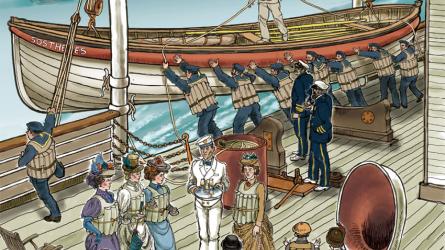
The Thrill of the Drill
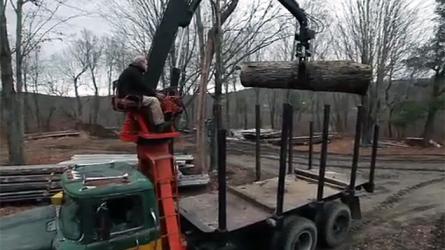
New England Naval Timbers
From the community.

L.H.F. HERRESHOFF DIDDIKAI BUILT IN 1980 GREAT CONDITION
36' 6" L.H.F. ketch that's a joy to sail and beautiful from all angles.
12' Beetle Cat
12' Beetle Cat with sail rig. Boat needs new ribs. Planking is good. Asking $250.00
Boat Launchings
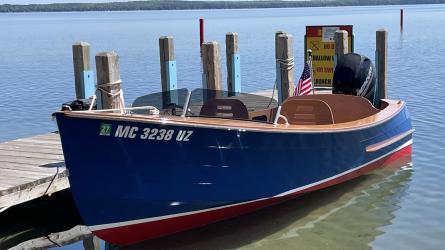
2024 Rhode Runner
“Rhode Runner” is a stitch and glue wooden craft reminiscent of the 1950’s style runabouts design
Register of Wooden Boats

Classic Boat Restoration – “Never Tell Them What It Really Cost”

I once had a boat restored by a guy who told me up front that he wouldn’t give me a quote on how much it would cost to restore my boat. Like a trusting fool, I agreed. Now of course I know better now, but at the time I was new to all this. In fact being so badly screwed is one of the motivators to starting this entire brand, and why we are all so passionate about being open and free with information. I will add that I do believe in Karma, and thanks to many of you and some wonderful partners in this passion, that the universe has corrected all the bad with great joy!

So what’s todays story all about? Well, I was once told by another restorer, that if you tell them what it will really cost to restore there boat, they won’t do it. So the trick of the trade is to estimate low. Just the bottom and be as vague as you can be. Now, to be fair to restorers out there, it’s a two way street. The customer can sometimes be their own worst enimy. See they will shop around and fall for the low ball most of the time, thus forcing normally honest restorers to adjust how they approach a bid.

No one is getting rich on your restoration. Have you ever met a wealthy boat restoration guy? No. Because it’s hard work, loaded with pit falls and on top of that you are using someones emotional money. As in money that isn’t paying a mortgage or collage education. Just a luxury. And chances are they are doing this with skeptical permission from a spouse. So, easing them into the process is a viable strategy. But.. It’s a mistake to make if you are about to get the boat restored. Get a fixed price. Period. Ask your restorer to be honest and transparent. Below are some issues to discuss.

- How much per foot on a bottom job?
- How much per Frame if they are rotten and need replacing?
- All new fasteners? YES BTW
- 5200 bottom? have you done many before?
- Guarantee your work?
- How much to flip the boat and prep it for a bottom replacement?
- Hourly rate? For the jobs that are not large.
- Are you/they part of the our community? Have you checked out references?
- Can you give me several people that you have done work for?
- And the last one, because 10 seems like a good number. LOOK AT CUSTOMERS BOATS. Look hard and at as many as you can.

The difference between Uncle Morty and a company that does this a lot, is a massive difference. Know what you are asking for. Want a non show user fixem’up? thats one thing. BTW, EVERYONE starts that way. And then once you seriously get into it, wonder why your boat is sloppy or still leaking. The “while your at it” stuff will cost you insane money. Aim high, go for the quality first. You may be shocked at how reasonable it may be when you think about it in the long run.

Many of us here have learned this the hard way. Do it right the first time so it’s not the last time you restore your boat. This can be fun, rewarding, and a wonderful affordable passion. But only if your partner in your restoration and maintenance is just that. Your partner!
Happy header Day!
Great advice! It’s the old pay now or pay later scenario. The difference is that by paying now you get to enjoy the boat, as opposed to paying less up front and enduring a never-ending series of problems which rob you of your enjoyment. Choosely Wisely Grasshopper!
Ask how soon they can start. Be prepared to wait. If they can start right away there’s a reason they have no work. Good shops are booked up.
Try not to work with a friend restorer, it could deteriorate..
The friendship,that is!
The restoration done on your Sportsman is an excellent example of-a done right by professionals. You get what you pay for. And I’m sure you paid plenty. Enjoy!
Thanks Dan, I would have thought the same thing starting out. but the final cost was the same if not less than my other restorations because it was all transparent and managed. Like I said, you may be shocked at how the pricing works when its done right.
I have endured forty years of restoring boats. Educating customers, keeping a low overhead to keep prices down, and doing show winning work. It has been fun, but laboring career. I’m booked out a year and a half but always find time to educate boat owners on doing it right the first time. I have lost money and have made a little. Mainly we enjoy seeing a customer take home an award or zoom away from the dock as a happy customer! Maintaining these beautiful boats is a passion, one that is a lost art form.
Thanks for that Mark, its always a good sign when a company is booked a year out. And also trusted by locals like you are. Your reputation is created by word of mouth. You can see Marks work at http://www.diamondboatworks.com Mark also may be at some sort of event in September in Michigan someplace. I just can’t recall what that may be?
PORT HURON!!!
That’s near Sarnia, right?
Right across the river.
Don’t forget the after restoration value equation.
Find out how much the boat will be worth when it is done so you get dissapointed that you spent more than it is worth when finished.
I had the opportunity to help a neighbor get and decide on estimates to restore her small vintage electric boat. We chose 2 professional shops in the area. The first came, looked at the boat, inspected the boat, took lots of pictures, told me how everything that needed to be done would be done, and honestly said it will cost you more to restore this boat than it will be worth, but what is the emotional attachment, history of the boat? There is one like this in the Adirondack museum.. He was there on a chilly November day for close to 2 1/2 hours surveying the boat, after a 1 1/2 drive from his shop. The second estimate came from a local shop, about a half hour away. He looked at the boat, said how he would splice this, sister this, etc. there about a half hour. We received both estimates. Shop One was itemized, with everything he could possibly think of that would be needed to restore the boat. Shop 2 was not, just a few items estimated that he easily saw, with the caveat, when I open her up if I find more it will be more. For reference, shop one was twice the price as shop two dollar wise. My neighbor was hesitant about the cost from both estimates, but wisely chose the more expensive one. Lots had to do with reputation, an itemized estimate,and the fact she would have the boat back by spring, which he did. The boat turned out great, and is ready for the next 83 years. Just a story of a restoration that turned out fine.
The Iron Rule of wooden boat ownership: Every one of our boats is worth less to whomever may buy it from us, than what we put into it. And that is ok.
Never trust a restorer with a rusty trailer hitch ball.
Hey, in the salt up here ours rusts in a day during the winter! 🙂
1. Only deal with places that have dogs. 2. Always bring the dog a treat. 3. Feel honored if the dog pees on your tire. 4. Dog hair in the varnish gives you extra points at a show.
Jaxon is a genius! Dogs are trusted and work for treats
I didn’t mention anything about working. Actually if I’m taking a nap just leave the treat. I’ll get to it when I wake up. Thanks in advance.
Steel screws used in 1937 by Chris Craft for fastening the corners of the wood frame windshields. The one on the left is from the bottom, the two on the right from the top. CC used lots of steel fasteners for major pieces including all the lower frame/gussets connections as shown in the other picture and 5″ steel screws for attaching the keelsons to the frames. However, nothing plated for sure. I would bet the fastener in your picture is brass, if pre-war.
Same way with an engine rebuild. My Model B took 2 years, but it was done right from the bottom up, everything was examined. Now, all I need to start up is water, fresh gas and a charged battery.
I don’t think you can us a broad brush to cover all restorers. In Southern Ontario we have some very wealthy restorers, and some that are always on the financial brink of disaster. But, there’s always Muskoka money to keep their shops full and I haven’t seen a poor restorer yet (they all do quality work). What’s good to know is that there are great shops out there that do quality work, at reasonable prices if you spend some time doing your homework.
If you’re not a 1%er you can join the great unwashed and learn DIY, if you’re willing… it ain’t rocket science. However, this will take longer and can cost almost as much (buying tools, consumables, learning curve) or more, in the long run. But, you will have also earned an education and have a greater understanding/appreciation of boats to go along with that proud smile of a job well done…. the down side is you will know about, and see every little minute flaw.
Some say the best tool in their toolbox is their cheque book. It’s hard not to disagree.
I am with Jaxon…..dogs are big in this equation. I drove my Fairchild Scout 30 into the straps of the travel lift yesterday….the lift operator had his dog running around…neat yellow lab….I stepped off to dry land and told the guy…that lab is your baby, this boat is mine…treat them the same…..he smiled, the dog wagged his tail….and my baby got rolled into the shop for new fuel tanks….will let you all know how this turns out. John in va.
Back in the day when boat shows were limited to Clayton Tahoe and Winnipesaukee, I went to New Hampshire looking for restoration help and information and ended up talking to a guy who needed somebody to manage a boat club…. My agreement to manage the club for 6 months grew to 25 years and I thereafter never had time for the boat restoration, I sought to do. I found a reputable guy to restore the boat…The boat and the boat club both turned out to be fun…Just be careful what you go looking for.
Y’all know “boat” is an acronym – Break Out Another Thousand… 🙂 But if the only thing you’re focused on is the dollars, you’ve missed the point of boat ownership!
It really means B eloved O wner of an A ntique T reasure in Woodyboaterville
When my Dad and I took on the restoration of our U22 we had two VERY skeptical spouses. My mother and my wife. Conversations were interesting.
Our work was done by Joel Terbrueggen and the guys at the Motor Boat Garage at their old place. It was completely transparent and I couldn’t have asked for a better experience. Even when we were told that a prior “refastening” of the bottom – by somebody else – involved placing drywall screws in between each of the original fasteners. And that ALL of the frames were rotten, broken or completely disintegrated. The guys called it the worst case scenario – I suspect no one else has been able to surpass that dubious honor. Fortunately the skeptical spouses were swayed by many many emotional pleas. Now we have a wonderful and seaworthy boat. We quickly got used to not having to worry about a dead battery because the bilge pump was no longer required to keep it afloat!
Having a lot of trust in the people doing the work was key to a successful project. Even though we were 400 miles away and never saw it in person until it was delivered a year later lots and lots of pictures weekly kept us up to day.
I could be wrong, but I’m willing to bet there is culpable negligence on both parties. I’ll bet the shop was faced with, “I don’t want to spend a lot of money,—I just want to get it god enough to sell”! And the shop, displaying poor ethics, did what the owner wished.
I appreciate Sean’s DIY option and I would add that the stuff like re-sawing and planing which calls for major equipment can be jobbed out. I did mine in the local high school woodshop. Almost all of the rest just called for a bandsaw and the same common tools the original builders had. Yes, there is a learning curve. I had to scrap the first attempt to make a new stem, but even that wood was used for butt-blocks and so on. The bigger decision and issue is probably time. Mine took two years of nights and some weekends. On the plus side, I KNOW every frame, plank and underlayment is better than new.Mine floats nine months a year. It has required little more than maintenance since I restored it in 1989.
Comments are closed.
Search woodyboater, receive posts by email, woodyboater on instagram.

More From Forbes
From our farm at sinking creek all the way to mongolia: how grassland restoration is reversing a disappearing habitat.
- Share to Facebook
- Share to Twitter
- Share to Linkedin
Too often, one ecosystem is overlooked in value and complexity in the workings of our planet. The images of a leveled forest or polluted waterway resonate much more strongly than the increasing disappearance of our native grasslands. In fact, few realize the significance of these seemingly simple but complex natural environments.
This remnant old-growth grassland in Arkansas shows the beauty and grandeur of the ancient ... [+] grasslands of the eastern United States that have experienced tragic losses of 90-99% of their original distribution from 200 years ago.
Grasslands have been central to the survival of numerous flora and fauna – in particular, the pollinator populations. These grasslands include North America’s Great Plains, Africa’s savannas, the Eurasian Steppe, and South America’s Pampas, and as we will discuss below the grasslands of the Southeastern United States. They have natural protective landscape forces that keep the planet in balance. Deep and dense roots in grassland ecosystems recharge groundwater and maintain water quality, while also serving as a protective barrier against erosion and soil degradation. In fact, grassland ecosystems store up to a third of the word’s terrestrial carbon sinks – yet they are being lost at a rate faster than the destruction of the Amazon rainforest.
Today, as chair of the global board of The Nature Conservancy (TNC), the world’s largest conservation nonprofit, and more locally through personal work with the Southeastern Grasslands Institute (SGI), I along with my wife Tracy have been deeply immersed in grassland conservation and restoration at multiple levels — locally both at our home in Tennessee and farm in Appalachia, regionally throughout the Southeastern United States, and globally just last month in Mongolia, where we witnessed grassland conservation at vast scale.
What is contributing to the rapid decline of our grasslands?
Broadly defined, grasslands encompass prairies, savannas, barrens, and balds, but also include glades, canebrakes, and open wetlands such as bogs, fens, and meadows – more formally any natural ecosystem in which the herbaceous layer is dominated by grasses and other grass-like (graminoid) plants, such as sedges and other herbaceous flowering plants.
Understand [ edit ]
Tyumen was founded in 1586 as the first Russian settlement in Siberia. During World War II, the city grew rapidly as many industries relocated further away from the war.
The region has plentiful oil resources and the city is now home to many companies in the Russian oil and gas industry. As a result, Tyumen has the highest GDP per capita of all cities in Russia, even higher than that of Moscow.
Get in [ edit ]
By plane [ edit ], by train [ edit ].

All Trans-Siberian trains stop at Tyumen . Travel time is 36-48 hours from Moscow . 57.145886 65.522885 2 Tyumen railway station is located at ulitsa Privokzal'naya, 22, south of the city centre.
By marshrutka [ edit ]
By taxi [ edit ].
Taxis are plentiful and you can even negotiate hourly rates.
See [ edit ]

Monuments [ edit ]
Tyumen has many unique statues and monuments.
- Monument to the Homeless Dog
- Monument to students from Tyumen Schools Who Did Not Come Back From The War
- Monument to Conductor
- Lenin Statue
- Monument to Machine Tool Builders
- Sculpture Harp
- Father Statue
- Happiness Tree Sculpture
- Sculpture of Street Cleaner
- Monument of Mother
- Monument to the Janitor
- Monument to Yuri Hervieu
- Monument to Liquidators
- Fountain-Monument to Tyumen Oblast
- Monument to Afghan Soldiers
- City Garden Monument
- Monument to Country Doctor
- Monument to the Postman
- Monument to Workers in Rear Area
- Monument to Grigoriy Rasputin
- Globe Monument
Religious buildings [ edit ]
- Church of the Saviour
- Holy Trinity Men's Monastery
- Znamenskiy Cathedral
- Saint Archangel Michael Church
- Holy Cross Temple
- Saint George Ascension Church
- Saint Dmitriy of Don Temple
- Saint Nicholas Temple
- The Temple in Honor of the Annunciation
- Tyumen Chapel
- Tyumen Synagogue
Museums [ edit ]
- The Kolokolnikovs' Estate Museum Complex
- City Council Local History Museum
- Fine Arts Museum
- Masharov's House Museum
Do [ edit ]
- Walk along the embankment of the Tura River. Walk across the Bridge of Lovers, a pedestrian bridge.
- Tyumen Drama Theatre - ul. Respubliki, 129 (+7 345 240-98-23)
- Tyumen Puppet Theater
Parks [ edit ]
- Tsvetnoy Park is a beautiful park that includes the Monument to the Homeless Dog.
- City Park of Culture and Leisure
- Forest Park of Gagarin
- Park of Deputies
- Gilevskaya Grove
- Siberian Cats Park
- Victory Park
Buy [ edit ]
- Solnechnyy Mall
- Premyer Mall
- Galeria Voyage Mall
Eat [ edit ]
There is a McDonald's restaurant in the park at ul. Lenina #54.
- Assorti Restaurant , ul. Babarynka, 1к6 , ☏ +7 345 223-42-34 . Pizza, sushi, soups, and various menu options.
Sleep [ edit ]
With the exception of some high-end hotels, all hotels and hostels offer free WiFi and many have computer terminals. Almost all accept credit cards. Hotels and hostels will usually provide a visa invitation and registration for an additional fee.
Splurge [ edit ]
- 57.153643 65.547471 1 DoubleTree by Hilton Tyumen , ul. Ordzhonikidze, 46 ( in the city centre ), ☏ +7 345 249-40-40 . Check-in: 15:00 , check-out: 12:00 . 40-inch LED TVs, indoor heated swimming pool, beauty salon, solarium, room service. ( updated Nov 2018 )
Learn [ edit ]
There are 3 universities and several colleges.
Connect [ edit ]
Consulates [ edit ], go next [ edit ].
- Has custom banner
- Has map markers
- Airport listing
- Eat listing with no coordinates
- Drink listing with no coordinates
- Sleep listing with no coordinates
- Listing with multiple email addresses
- Has routebox
- Has Geo parameter
- Tyumen Oblast
- All destination articles
- Outline cities
- Outline articles
- City articles
- Pages with maps
Navigation menu
- Bahasa Indonesia
- Slovenščina
- Science & Tech
- Russian Kitchen
Passage to Siberia: Exploring historic Tyumen

Tyumen. View up the Tura River. From left: Church of the Elevation of the Cross, School of Commerce, Trinity Monastery with Church of Sts. Peter and Paul and Trinity Cathedral. September 4, 1999
At the beginning of the 20th century, Russian chemist and photographer Sergey Prokudin-Gorsky developed a complex process for vivid color photography. His vision of photography as a form of education and enlightenment was demonstrated with special clarity through his images of architectural monuments in the historic sites throughout the Russian heartland.

Tyumen. View up the Tura River. From left: Annunciation Cathedral (demolished); Church of Elevation of the Cross; Church of the Ascension & St. George; Trinity Monastery. Summer 1912
In June 1912, Prokudin-Gorsky ventured into western Siberia as part of a commission to document the Kama-Tobolsk Waterway, a link between the European and Asian sides of the Ural Mountains. The town of Tyumen served as his launching point for the journey north to Tobolsk, on the Irtysh River.

Cathedral of Icon of Virgin of the Sign, south view. August 29, 1999
During his journey, Prokudin-Gorsky took several extraordinarily valuable photographs of both Tyumen and Tobolsk . My photographs of Tyumen and Tobolsk were taken in the late Summer of 1999.
Humble beginnings

Cathedral of Icon of Virgin of the Sign, southwest view. August 29, 1999
Considered the earliest permanent Russian settlement in Siberia, Tyumen was founded in 1586 on the site of a Tatar encampment at the confluence of the Tura and Tiumenka Rivers. The initiative for its creation came from Boris Godunov, the power behind the throne of Tsar Fedor (son of Ivan the Terrible) and, eventually, to become tsar himself in 1598.

Cathedral of Icon of Virgin of the Sign, south facade. August 29, 1999
Godunov was closely allied with the Stroganovs, who from their commercial center at the northern town of Solvychegodsk had sent a detachment of Cossacks commanded by a certain Yermak deep into Siberia to challenge the power of the ruler of Siberian Tatars, Khan Kuchum. Although the precise dates are open to question, it appears that, in the Fall of 1581, Yermak captured Chingi-Tura (later Tyumen), but abandoned his conquest, in order to proceed straight to Kashlyk, capital of Khan Kuchum, whom Yermak defeated in 1582 during a battle near the Irtysh River.

Church of the Miraculous Image of the Savior, southwest view. Originally built in 1794-1819, this is an excellent example of "Siberian Baroque" architecture. August 29, 1999
Following Yermak’s death in a surprise Tatar raid in 1584, his conquests remained temporarily unconsolidated after his death. Nonetheless, Boris Godunov was aware of the enormous significance of Siberia and launched a campaign to found settlements, as he did in other border areas of the medieval Muscovite state.

Church of the Ascension & St. George, south view. Originally built in 1770-89, defaced during the 1930s & restored after 2003 with rebuilding of bell tower. September 4, 1999
Like other early Russian Siberian towns, Tyumen originally served as a garrison fortress for Cossacks and other troops, who protected newly developing trade routes in all directions. The eastern connections with China gained particular importance during the 17th century.
Location, Location, Location

Church of the Elevation of the Cross, southeast view. Built in 1774-91. August 29, 1999
Tyumen’s location on the Tura River also provided a direct link westward with the gateway town of Verkhoturye founded by Boris Godunov on the Asian side of the Ural Mountains in 1598. And to the east and north of Tyumen, the Tura River merges with the Tobol, which in turn joins the great Irtysh near Tobolsk. By virtue of its location, Tyumen was destined from the beginning to play a significant role in the Russian development of Siberia.

City Council Building. Originally built in 1828-33 in a simplified neoclassical style. Chiming clock was added in 1857. August 29, 1999
The opening of Siberia for Russian colonization during the late 16th and 17th centuries was an epic confrontation between the vast distances of this severe land and the enterprise of Russian merchants, whose commercial interests coincided with the tsars’ appetite for eastern expansion. Although its rivers were only tributaries of the Irtysh (itself a tributary of the great Ob River), Tyumen was well situated to utilize Siberia’s vast water network.
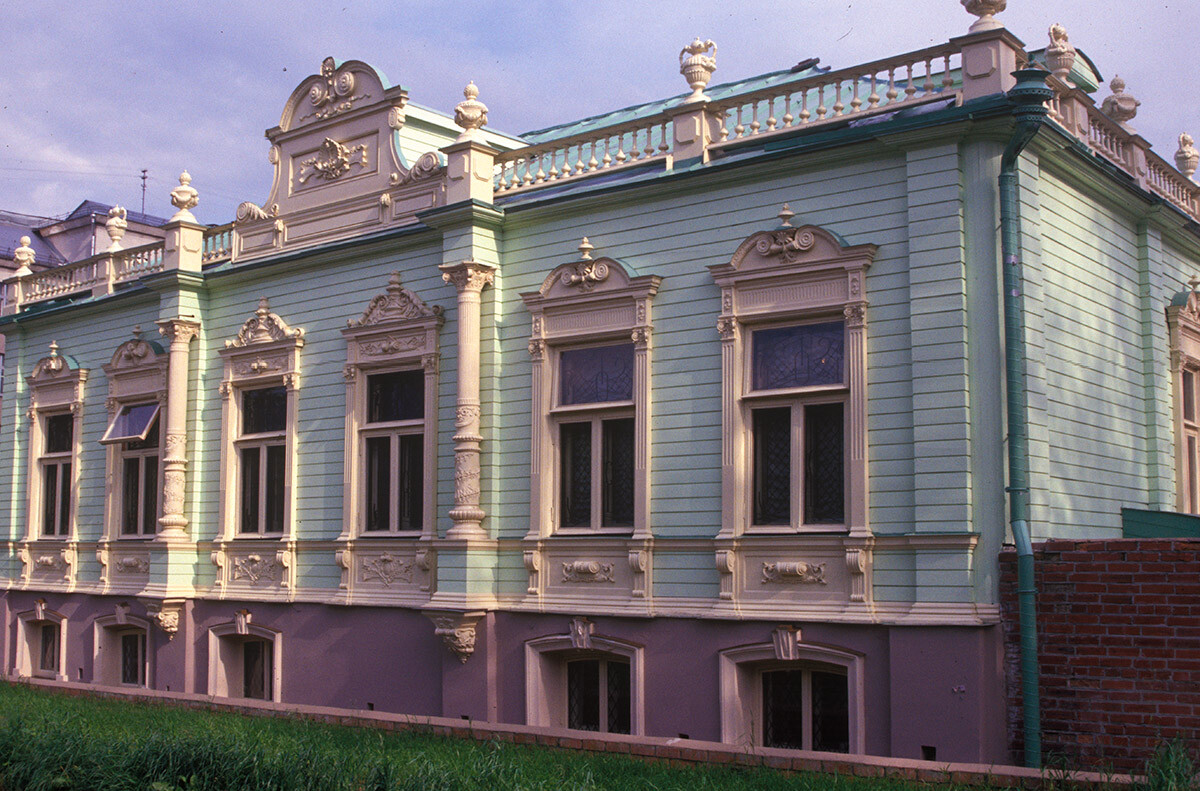
Kolokolnikov house, corner of Republic Street 18 & Turgenev Street. Originally built in 1804 by the merchant Ivan Ikonnikov, this superb example of classical wooden architecture was acquired in 1888 by the merchant Ivan Kolokolnikov, who modified the original design. August 29, 1999
Like most early Russian towns in Siberia, Tyumen originally served as a fortified settlement for Cossacks and other troops, who in the 17th century protected newly developing trade routes, particularly with China.

Nikolai Masharov mansion, Lenin Street 24. Built in the late 19th century by the founder of the Tyumen Ironworks. August 29, 1999
When the southern boundary of Moscow’s Asian territory became more settled during the 18th century, Tyumen’s importance increased for the development of transportation as well as small commercial and industrial enterprises. Its status as a transportation nexus also involved the exile system, which sent convicts and political exiles throughout Siberia.
Orthodox Church HQ
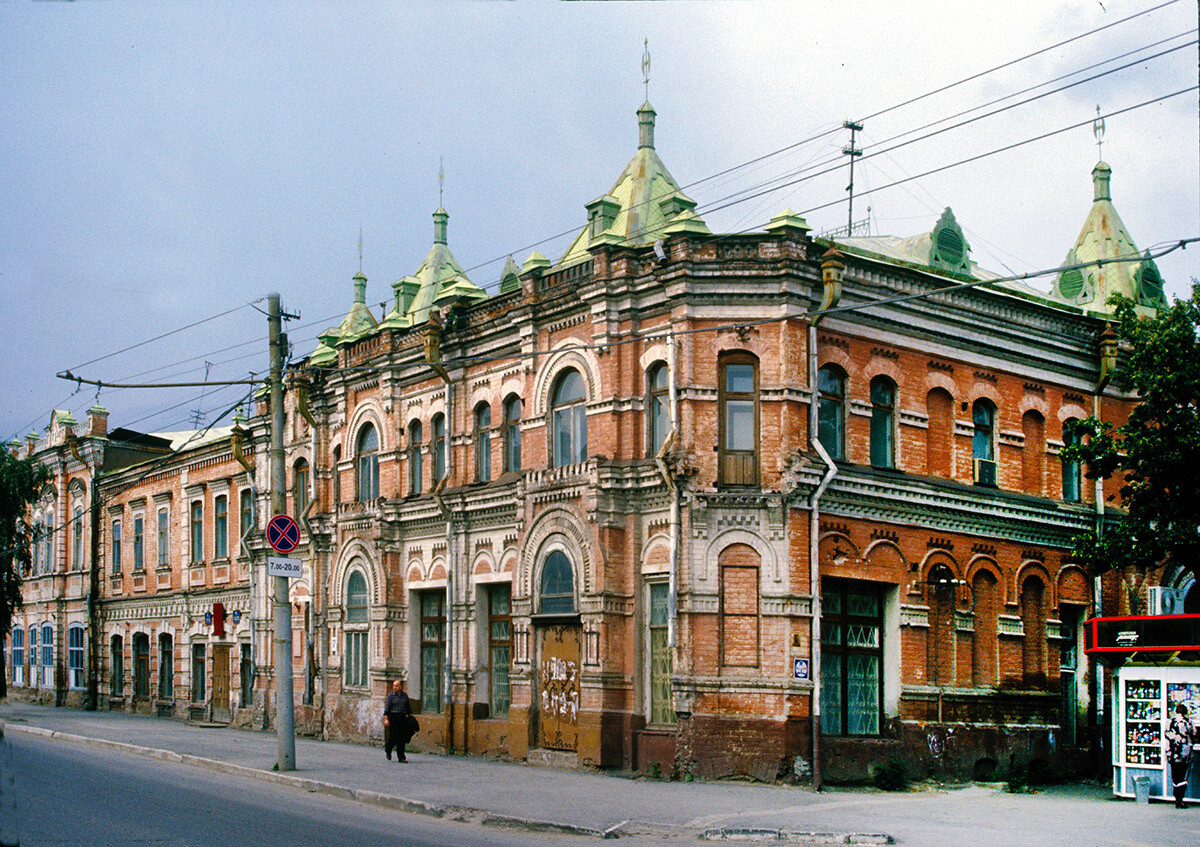
Commercial building (corner of Republic & Kirov Streets) built by the merchant Nikolai Yadryshnikov in 1897. Example of highly decorated "brick style" favored for commercial buildings in late 19th century. August 29, 1999
As a regional administrative point for western Siberia, Tyumen rapidly became a center of the Russian Orthodox Church. Its Trinity Monastery was founded in 1616 on the high right bank of the Tura River. Originally dedicated to the Transfiguration, the monastery was a modest collection of log buildings until its transformation in the early part of the 18th century by an energetic Ukrainian prelate, Bishop Fyodor Leshchinsky.

School of Commerce (now Engineering Institute). Completed in 1914 during a Siberian building boom stimulated by development of commerce along the TransSiberian Railway. August 29, 1999
As an ally of Peter the Great, Bishop Fyodor saw architecture as a reflection of a broad cultural transformation and the Church of the Trinity that he built at the monastery in 1709-1715 is Tyumen’s earliest surviving building. Gutted during the Soviet era, the Trinity Church has been renovated (with modifications) together with its neighbor, the Church of Saints Peter and Paul, built in 1741-1755. Fortunately, Prokudin-Gorsky photographed both shrines in 1912.

Tekutyev Crafts School, Dzerzhinsky Street 2. Completed in 1914, the building is a fine example of provincial "style moderne". August 29, 1999
These early examples of a provincial baroque style served as a model for other 18th-century churches in Tyumen, culminating with the lavish Cathedral of the Icon of the Virgin of the Sign (Znamensky), which has recently been splendidly refurbished. Built in several phases between 1768 and 1891, the cathedral displays the florid decoration typical of much of Siberian church architecture.
Submitting Siberia

Shaichik mansion, Lenin Street 47. Built in 1914 by Yankel Shaichik, major store owner & trader in dry goods. August 29, 1999
The daunting vastness of Siberia’s reaches gradually submitted in the 19th century to new forms of transportation. The first steamboat to ply a Siberian river was constructed here in 1838.

Burkov house, Dzerzhinsky Street 30. Built at turn of 20th century by Vasily Burkov, trader in Siberian grain on an international level (China, Japan). August 29, 1999
The greatest impulse for economic growth came with the completion of a railroad from Yekaterinburg, on the east slope of the Ural Mountains in 1885. This line ultimately became an important segment of the Trans-Siberian Railroad, transporting the wealth of Siberia’s forests, mines and new agricultural regions, as well as leather and other products of local factories.
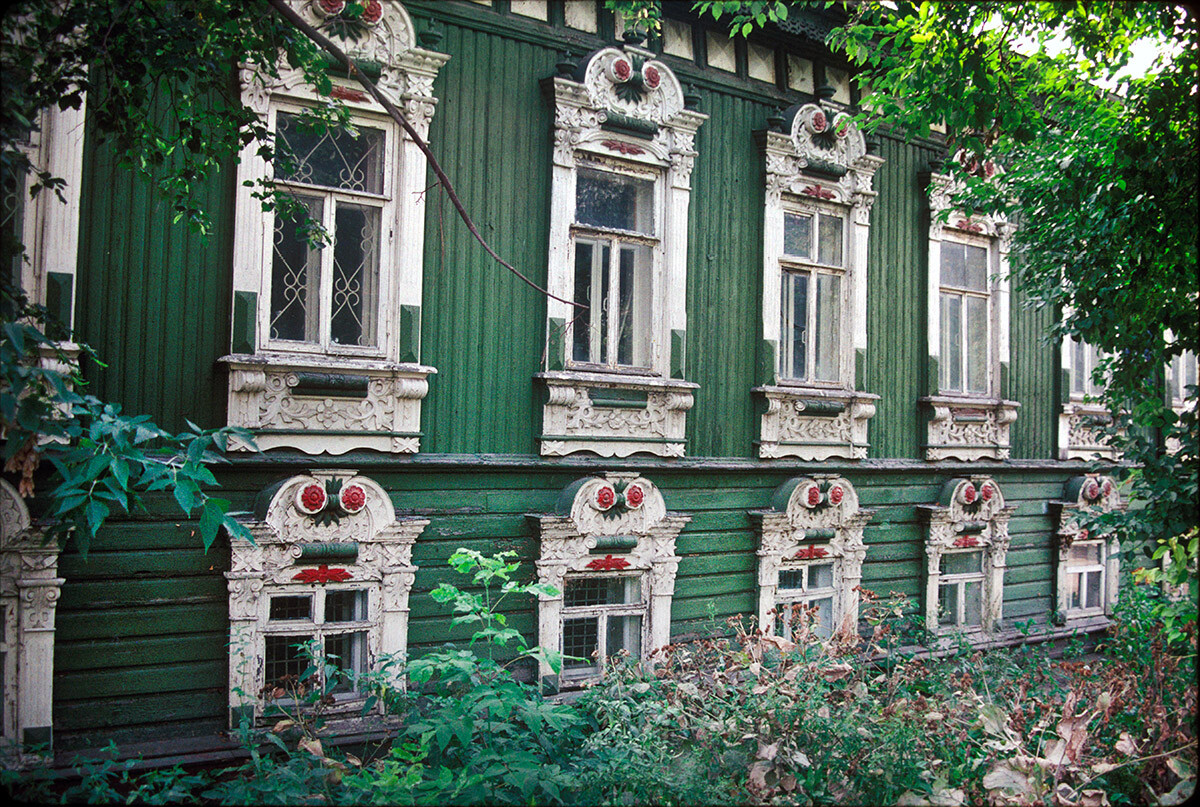
Kozlov house, Turgenev Street 9. Built at end of 19th century by Ivan & Maria Kozlov, local merchants. August 29, 1999
At the turn of the 20th century, over half a million settlers passed through the town toward Siberia’s open, fertile lands. Fortunately, remnants of this period have survived in the central part of the city.

Nikolaevskoe (Nicholas) Primary School, Lenin Street 5. Wooden building constructed in 1897 as part of a public schools network. August 29, 1999
This memory of the past is especially evident in the city’s remarkable wooden houses, with elaborate framed and carved window surrounds in a style specific to Tyumen. These massive window constructions often include carved panels below the sill as an additional decorative and protective device.
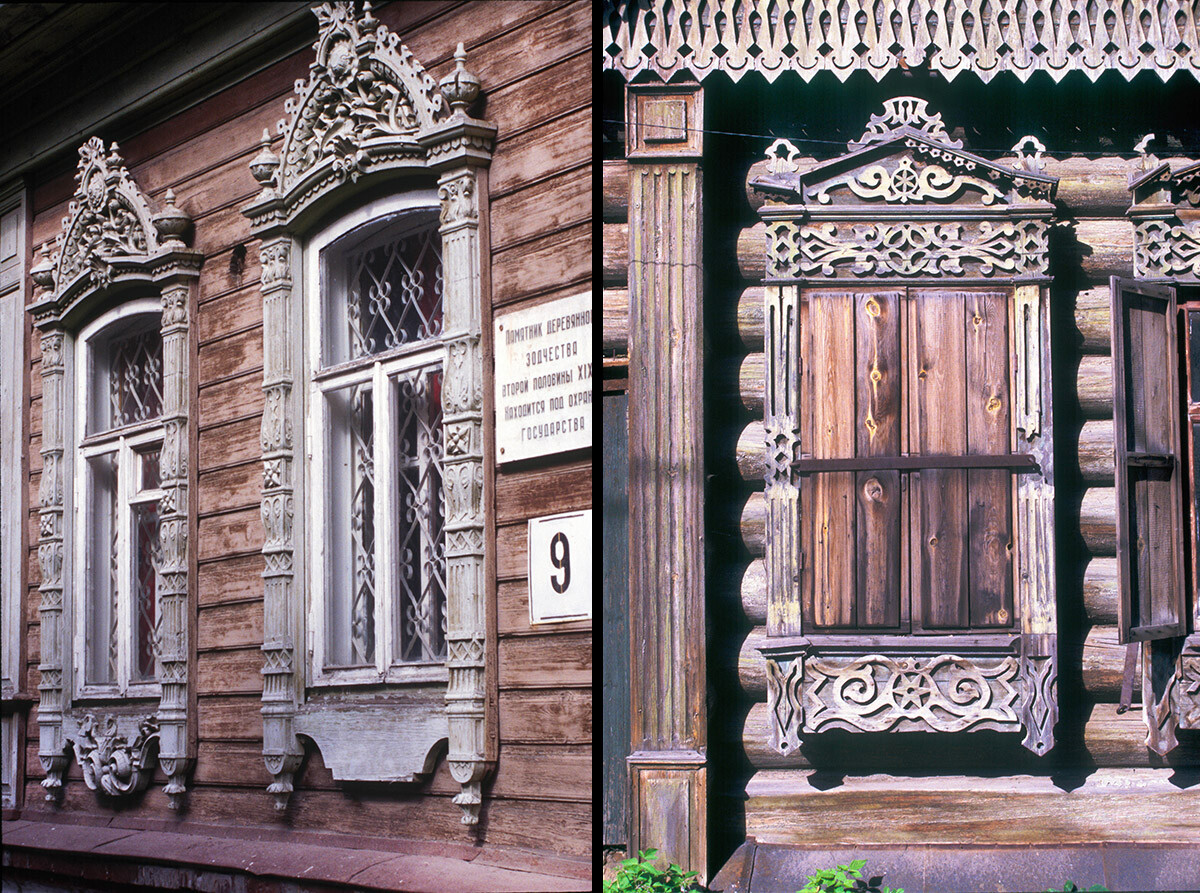
Wooden houses. L:eft: Volodarsky Street. Built at end of 19th century, the house has exuberant carved decorative window frames. Right: Komsomol Street. Built around 1900 as a wing of the A. G. Andreev estate, this small structure displays remarkable examples of decorative fretwork. August, 1999
Their solid construction allowed rows of large windows in wooden houses even in this harsh climate, thus bringing maximum available light to interiors during the long Siberian winters.
The present & future

Log apartment house, no. 57 (street unknown; house may have been demolished). Fine example of carved window frames on typical log structure. August 29, 1999
Tyumen today is the capital of an enormous province - stretching from Kazakhstan in Central Asia north to the Arctic Ocean - that is one of the world’s richest energy producing regions. Tyumen has benefited from this bounty of natural resources and is at present one of the few Siberian cities to show major population growth: from slightly over half a million in the 2002 census to some 850,000 in the latest estimate. As usual in Siberian cities, most residents live beyond the historic center in Soviet-era housing developments.
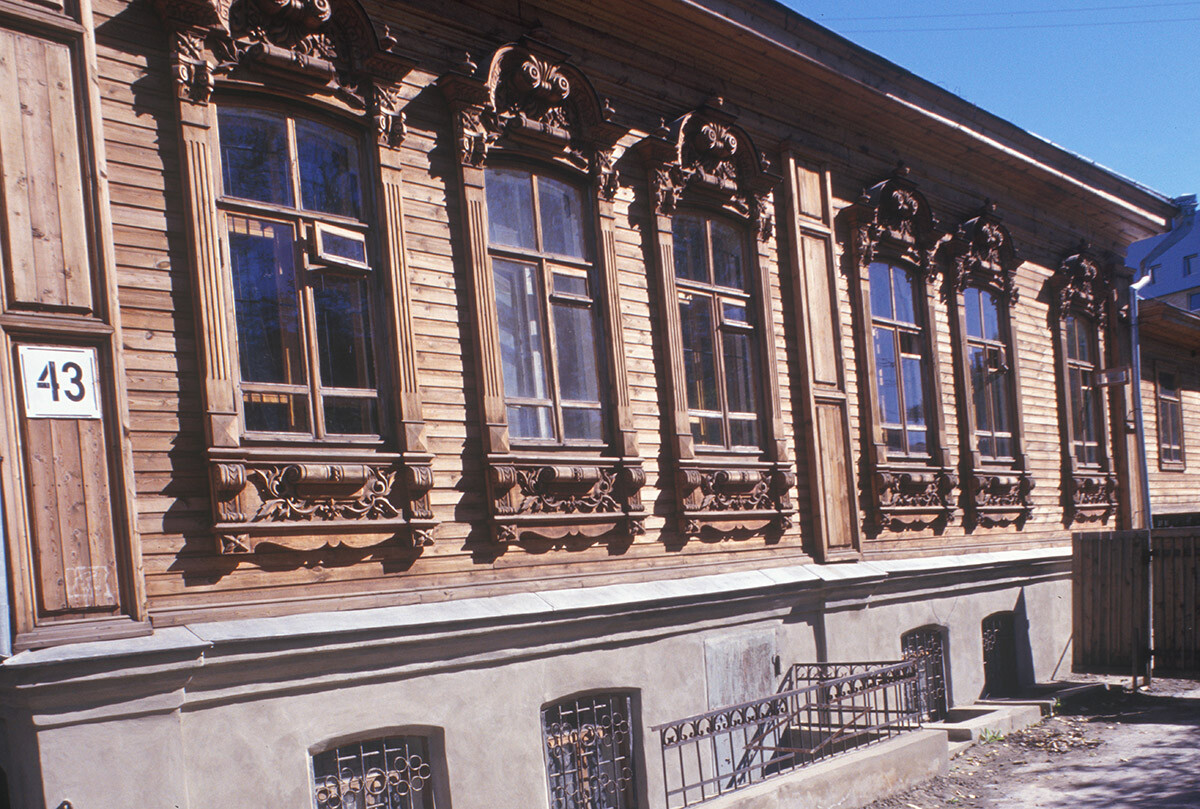
Minshutin house, Vodoprovodnaia Street 43. Built in 1891, the house was restored in 1998 by architect A. Klimchenko with decorative window frames carved by Vadim Sheetov. September 4, 1999
A walk through the historic center of town shows vivid contrasts of modest pre-revolutionary brick and wooden buildings, rarely more than two stories in height, with ponderous Soviet buildings and sleek new commercial centers. Some of the new structures are private apartment houses, others are banks and office buildings and still others form a part of the expanding Tyumen State University.
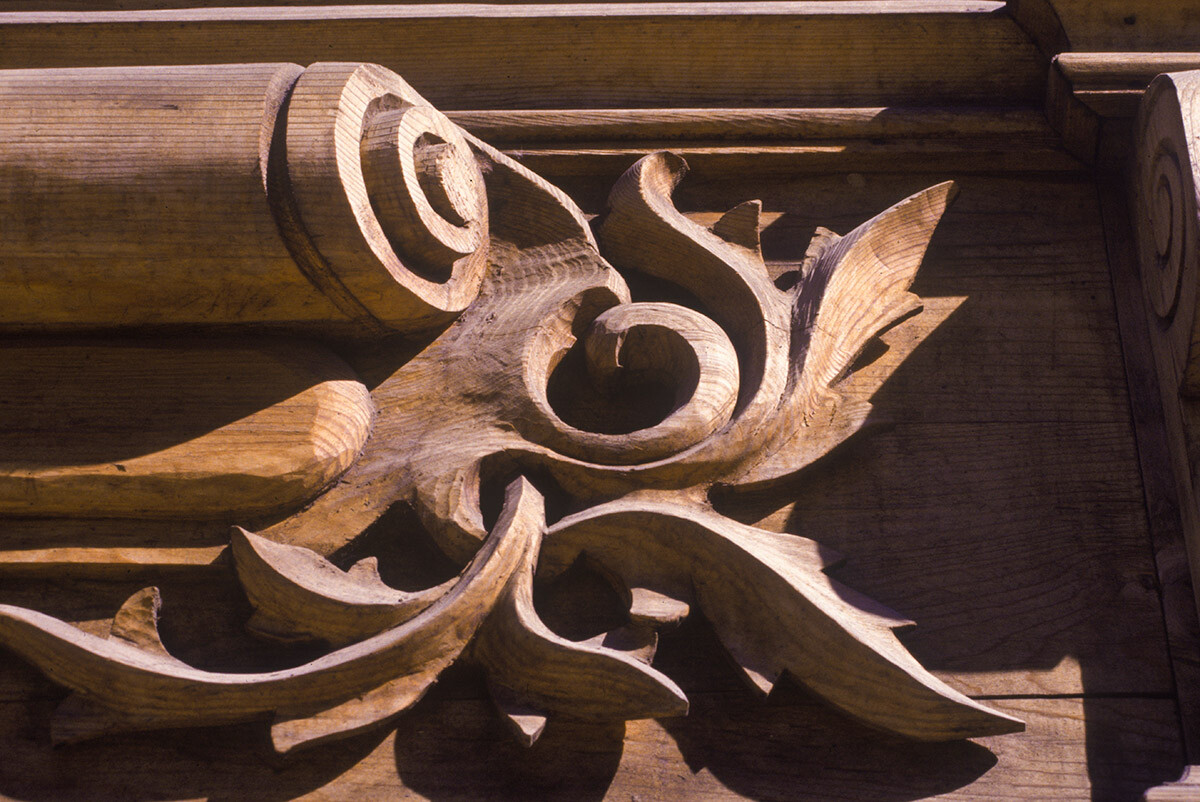
Minshutin house, detail of decorative carving by Vadim Sheetov. September 4, 1999
In the early 20th century, Russian photographer Sergey Prokudin-Gorsky developed a complex process for color photography. Between 1903 and 1916, he traveled through the Russian Empire and took over 2,000 photographs with the process, which involved three exposures on a glass plate. In August 1918, he left Russia and ultimately resettled in France where he was reunited with a large part of his collection of glass negatives, as well as 13 albums of contact prints. After his death in Paris in 1944, his heirs sold the collection to the Library of Congress. In the early 21st century, the Library digitized the Prokudin-Gorsky Collection and made it freely available to the global public. A few Russian websites now have versions of the collection. In 1986, architectural historian and photographer William Brumfield organized the first exhibit of Prokudin-Gorsky photographs at the Library of Congress. Over a period of work in Russia beginning in 1970, Brumfield has photographed most of the sites visited by Prokudin-Gorsky. This series of articles juxtaposes Prokudin-Gorsky’s views of architectural monuments with photographs taken by Brumfield decades later.
If using any of Russia Beyond's content, partly or in full, always provide an active hyperlink to the original material.
to our newsletter!
Get the week's best stories straight to your inbox
- Tobolsk: Exuberance of Siberian Baroque
- U.S. professor continues photographic legacy of Prokudin-Gorsky in new book
- Discovering the historic neighborhoods of Perm
This website uses cookies. Click here to find out more.
The 12 best places to visit in Tyumen (the oldest siberian city)
It is the oldest city in siberia and has many points of interest. find out about the best places to visit in tyumen, russia..

The first Siberian city was founded in 1586. Tyumen has been unofficially titled the oil and gas capital of Russia. The city’s population is 707 000 people, which continues to increase. According to RBC Holding, Tyumen is one of ten the most quick-growing towns in Russia. Don’t let the mention of oil-hungry businesspeople leave you thinking this is a dull, money-focused city, though. The city has a buzzing street life in summer and a couple of worthwhile sights that, taken together, will keep you entertained for a day or so.
Tyumen is also the stepping stone to the gorgeous old town of Tobolsk, a few hours’ bus or train ride away. Tyumen is a cultural, business, educational and administrative center of the Tyumen region. Most of the city’s population comprises young people under 35.
Here are always places to go in the evening and to see during weekends. Cozy cafes, luxurious restaurants, the best theatres and philharmonic concert hall, and museums reminding about the rich history of the city — all that is Tyumen. These are the best places to see in Tyumen, Russia.
1. Tyumen’s Holy Trinity Monastery

Tyumen’s Holy Trinity Monastery is located in the historical center of Tyumen. It is just a few minutes walk from the Tura Embankment. The monastery was founded on the picturesque bank of the Tura River in 1616. Almost a century later, in 1708, the old wooden monastery was rebuilt with stone. Shortly after, the monastery was named Holy Trinity. The building process was conducted under the leadership of metropolitan Philophey Leschinsky. Later, he took monastic vows and lived in seclusion for the rest of his life. After he died in 1727, he was buried at the monastery’s entrance.
During the Soviet period, the monastery was used as a dormitory for a military platoon and the headquarters of the city’s water control system. The monastery was returned to the Tyumen diocese in 1995, but the first service was not held there until 2003. In 2005 the relic of prelate Philophey was uncovered and is now kept in the Peter and Paul Cathedral monastery. In 2007 a square was dedicated to Philophey near the monastery. Today Holy Trinity Monastery is open for everyone to see and tour while it continues to hold regular liturgical services.
2. Znamensky Cathedral

The history of Znamensky Cathedral found its roots in the first half of the 17th century, when a small wooden chapel was first erected at the site of the current Cathedral. The old wooden chapel was replaced with the construction of a stone church which began on September 1st, 1768. The church’s previous name was given in honor of Mary, the Mother of God, and her icon within the church. The building was dedicated only 33 years later, in 1801. The church’s first stone building was painted white and consisted of the main chapel, a bell tower, a refectory, and a porch.
After the Revolution of 1917, the Cathedral was used as a transit prison. Still, between 1933 and 1941, the church was returned to the diocese. With the beginning of World War II, however, it was again taken over and used to house dislocated army forces. Finally, the Cathedral was returned to the eparchy. On June 19th, 1994, the clergy held a liturgical service for the first time. Today Znamensky Cathedral is a functioning church and one of the most beautiful symbols of Tyumen.
3. Tyumen Bolshoi Drama Theater

In 2008, The Tyumen Bolshoi Drama Theater got a new building built in record time for one year and eight months. With a 158-year history, the theater is the most prominent Drama Theater in Russia. The history of the Tyumen theater began even before the first building. It is known that in 1858 the St. Petersburg guest expressed his admiration for Amateur performances.
This fact was recorded, and the city’s theatrical history was reckoned from it. History tells us that in 1890, the first Guild merchant, an honorary citizen of the municipality Tekut’ev Andrei Ivanovich, founded a permanent theatre, which entered the town history called Tekut’evsky. Andrei Ivanovich, in love with the spectacle of dramatic scenes, supported theatre for 26 years.
In 1916, before his death, he bequeathed the theatre to the city. The City Council accepted the gift, and newspaper announcements began to inform about the performances not in the Tekut’ev’s theater but in the city theatre named Tekut’ev. After the October revolution, the theatre received the name of V. I. Lenin.
Under the leadership of the Petrograd director Valmar, it was staged such performances as “Idiot”, “the Power of Darkness”, “the Living corpse”, and “the Day”. In subsequent years the core of the repertoire included Russian and foreign classics, the best works of modern drama.
4. Saint George Ascension church

Through the parishioners’ efforts, this church was erected on the Tura River’s left bank. The church began as a stone two-storied building with a bell tower and two thrones: one is on the first floor in honor of Saint George and the other in honor of the Ascension of God is on the second.
After the October Revolution in 1929, the church was closed, and a workshop of tanners and chemists used its building. In 1934-35 the church became a dormitory for driving school students and combined operators. Later the building was under the governance of Tuymen’s fur coat fabric company.
Only in 1996 was the building returned to the diocese of Tobolsk and Tyumen. Two years later, services were resumed there. Step by step, in 2005, the bell tower was restored. In 2006, the church participated in the government program entitled “Cultural memorials restoration.” Now it is a functioning church that adorns the historical center of Tyumen.
5. Church of the Saviour

The Church of the Saviour, also known as the Church of the Image of “The Saviour Not Made by Hands” or shorter Spasskaya Church, is a church in Tyumen, Tyumen Oblast, Russia, located at Lenin Street, 43, at a crossroad between the Chelyuskintsev Street. Built-in a late 18th-century Siberian Baroque and early 20th-century neorussian style, the building is one of Siberia’s oldest and most expressive churches, under monument protection.
It is believed that the early wooden church was raised in 1586 and reconstructed after several fires into a stable stone building in the late 17th century. The Church of the Saviour saw another two rebuildings in the late 19th century. However, after the 1917 October Revolution, the church was subject to confiscations of its property in 1922, and in 1930 was closed and became a momentary prison.
After the failed attempt to destroy the church two years later, it has been used as an archive and a library. The building storage material for the Tyumen Local Historical Museum is expected to be returned to the local eparchy in 2019.
6. Tura Embankment

The only thing in the Russian four-level structure of this kind and one of the favorite holiday destinations among residents and visitors alike. Here, close to each other is full of the city’s attractions: Lover’s Bridge, historical area, the museum “City Council” Architecture and Construction University, and Holy Trinity Monastery. Embankment and bridge of lovers – the city card is depicted on the magnets, postcards, and other souvenirs tourists bring from Tyumen.
Construction of the promenade continues today, and it planned its expansion on both sides of the river Tura. Throughout the embankment, scattered monuments of famous people, life, and activity were somehow linked to Tyumen. Summer, early Fall, and spring – are the best time for walking and spending time on the waterfront.
It is always noisy: many people are playing songs with a guitar, working fountains, flash mobs, and holding various events, to the bridge of lovers traditionally come to the newlyweds. In the summer promenade Tours – the most popular holiday destination for residents.
7. The Lovers’ Bridge

The Lovers’ Bridge is a cable-stayed bridge over the Tura River in the Central District of Tyumen. The bridge was built in 1987 – five years after the collapse of an old wooden bridge in the exact location. The last name of the bridge was Peshehodniy (Pedestrian). Still, in 2003 local DJs Maria Kondratovich and Timur Shkval arranged an unusual contest called “The most unusual kiss”.
After this event, the city mayor Stepan Kirichuk offered to rename the bridge the Lovers’ Bridge. Then, on July 26th, newly married couples, the director of the Red Army Radio Station V. Bogodelov, and the city’s mayor performed an official ribbon-cutting ceremony to commemorate the bridge.
8. Kolokolnikovs Estate Museum
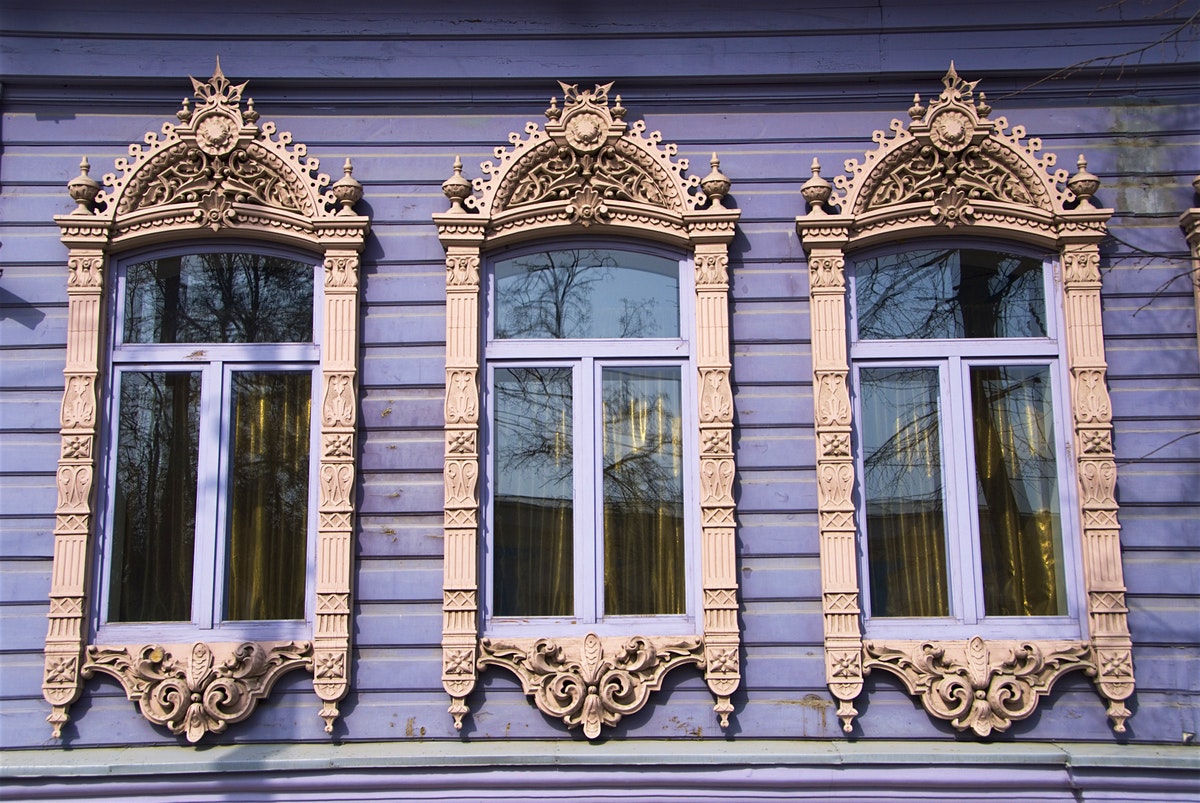
The Kolokolnikovs Estate Museum is the only remaining classical merchant’s estate in Tyumen. The building’s facade combines classical and baroque architecture elements and traditional Siberian carving. The doors open to a luxurious, brightly lit hall with lofted ceilings and walls decorated with vivid paintings of the Kolokolnikovs family.
One painting depicts an old trade shop, representing the collective image of the city’s shops. Stepping through the doors of the Kolokolnikovs Estate transports one back to the unique atmosphere of the late 19th and early 20th centuries.
The permanent exhibit of the Kolokolnikovs Estate Museum is called “The History of the House”. It is dedicated to the history of the merchant families, such as the Ikonnikovs and the Kolokolnikovs. The exhibit will also explain the historical events in this house, one of which was the monumental meeting between the future Emperor Alexander II and the great Russian poet V. Zhukovsky in 1837. In 1919 the estate was used as the headquarters of Marshal V. Blyukher.
9. Gorodskaya Duma Museum

The building of the Tyumen regional Museum of Local Lore Gorodskaya Duma was built in the second half of the XIX century. It is a magnificent example of Russian provincial architecture. The high ladder and a stepped attic give the museum its slenderness, combined with a Corinthian portico and massive columns — the traditional buildings of public institutions and architectural elements.
The Window into the nature constant exhibition introduces the variety of Flora and Fauna of the Tyumen region and its ancient inhabitants. An integral part of the museum is a small paleontological Museum. The skeleton’s collection of mammoth, fossil bison, woolly rhinoceros, and cave bears is presented at the museum. In addition, visitors can get acquainted with the Botanical, Zoological, and entomological collections.
10. House Masharova Museum
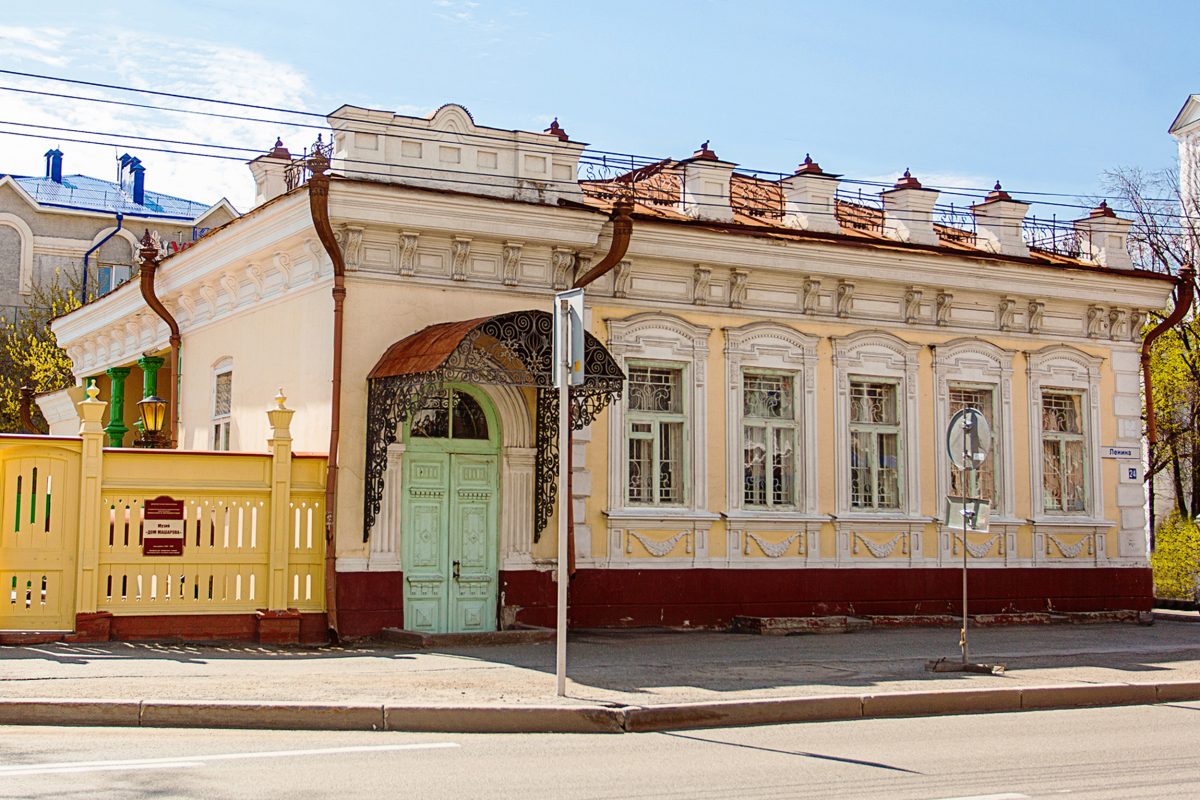
The House Masharova Museum is an old house built in the neoclassical style and previously belonged to N. Masharov, a famous manufacturer and one of the founders of the iron industry in Tyumen. The museum is a monument to late 19th and early 20th-century Siberian architecture and is renowned for its luxurious décor.
Traditional musical events and temporary exhibitions are regularly organized in the House Masharova Museum. They take place in the chamber-like atmosphere of the welcoming hall of the merchant’s house.
The permanent exhibition called the Family Book tells the tale of the family’s life at the end of the 19th century. During a tour of the house built, you will see many authentic items of a past era and discover the etiquette of a traditional family from Tyumen.
11. Alexandrovsky Garden
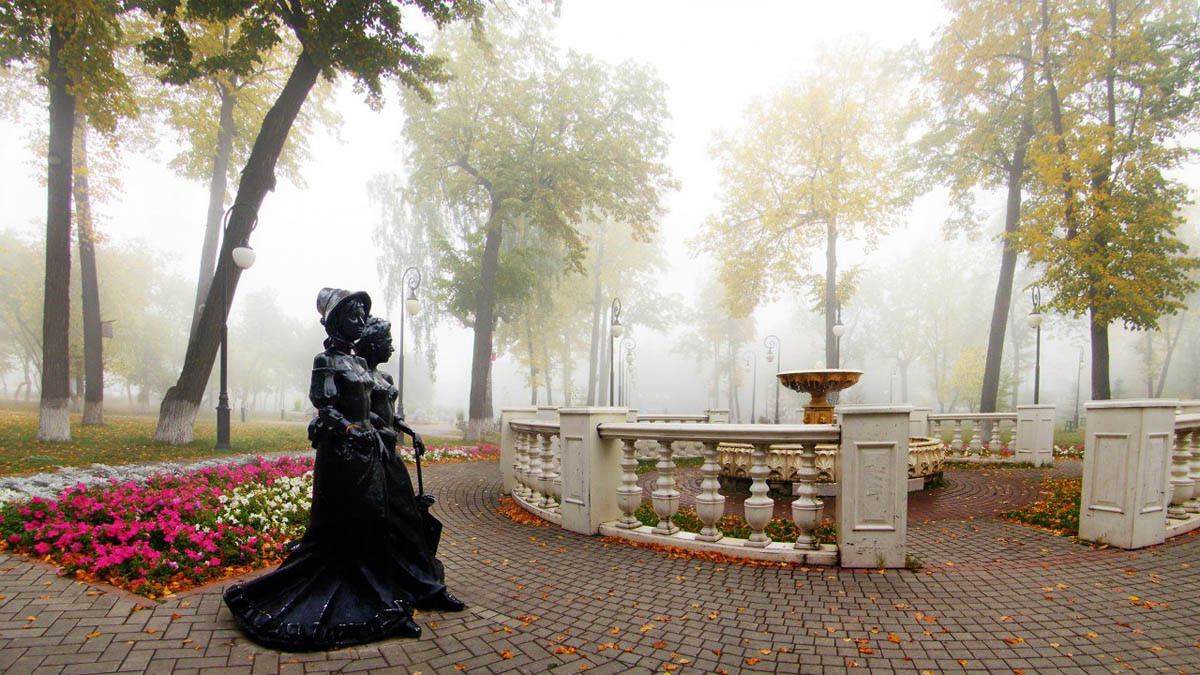
The original name of the Alexandrovsky Garden is the Country Garden. The garden appeared on a vacant plot of land in 1851 when thousands of linden, birch, spruce, and pine trees were planted in the area of about 100 acres (40 000 m²) with the money of the merchant Ivan Ikonnikov.
The garden was named after the crown prince Alexander, the future Tsar Alexander II, who visited Tyumen on May 31st, 1837, during his journey through Siberia. After the October Revolution of 1917, the garden was abandoned until 1948, when a small portion of it was restored through the employees’ efforts of a ship-building plant.
The landscape of the garden was adorned with a pond, a small bridge built traversing the ravine, a shooting range, and a restaurant with a terrace. In the 1960s, it was abandoned again, and by the 1970s, it fell into disrepair. Later a development effort began on the garden’s premises with the construction of houses, a kindergarten, and garages. A road to the Profsoyuzny Bridge was also built through the park.
However, the renewal of the garden did not begin until 2007. Although ten times smaller than the original garden, the grounds were restored, and the Alexandrovsky Garden became its official name. The fountain was rebuilt as well as sculptures of citizens styled after the 19th century. Some statues include the Hussar, Ladies on a Walk, A Girl at Rest, and the Boy.
12. Rasputin Museum

Grigory Rasputin was a friend of the last Russian emperor Nikolay II and his family. Rasputin is one of the most mysterious and exciting personalities of the end of the 19th and the beginning of the 20th centuries. In the 1900s, among Saint Petersburg’s high society, he had the reputation of the Tsar’s family friend, a religious elder, a seer, and a healer.
The exposition includes a cosmetic mirror, broken down in the middle that symbolizes the broken life of its owner, an icon of St. Simeon Verhotursky the Righteous, who is highly honored in Siberia, and the plate of the famous Kuznetsovky porcelain factory with the monogram of the empress, which Rasputin gave to his god-daughter Iraida Kolesnikova during her christening, an old Viennese chair from the Rasputin’s house. There is an authentic platband from the famous home of Rasputin, and the only thing remained of the building.
Leave a Reply Cancel reply
Your email address will not be published. Required fields are marked *
Save my name, email, and website in this browser for the next time I comment.
Notify me of follow-up comments by email.
Notify me of new posts by email.

10 Unforgettable Things To Do In Lisbon
Lisbon might not have the status of Rome or Paris in terms of sights, but the Portugal capital is really...

Portuguese pastry: 15 amazing sweets from Portugal

Russian cities: the 15 largest

The most common Russian names (meanings and origins)

100 amazing Fyodor Dostoevsky quotes full of wisdom
© 2024 Vortex Magazine
Mais infomação
Redes sociais.

IMAGES
VIDEO
COMMENTS
Add on around $25,000 for the restoration work carried out by skilled trades, plus $15,000 for your own time—a total cost of approximately $70,000. Compared to the price of a new 30-foot yacht of around $120,000, that's quite a saving. On the flip side, the resale value of the restored boat may only be around $45,000.
Feb 9, 2022. Returning an older boat to like-new condition is usually less costly than buying a new one, and it'll make you the envy of the marina. You know you're getting old when things you owned as a young man are now considered "classic.". The 289 Mustang I abused back in the early '70s today might be—after the application of ...
Over the weeks and months of our old sailboat restoration, I experienced periods of high motivation where working on the boat was the only thing I wanted to do. Things like eating, sleeping, and my day job just got in the way. Other times, making myself get out there was like getting a 6-year-old to eat peas: damn near impossible.
Cost Analysis and Budgeting. Restoring a yacht isn't just about sandpaper and paint. You've got to keep an eye on the money side of things, too! It's important that your project doesn't end up costing more than you can handle. ... Yacht restoration is a world full of amazing transformation stories. Each job shows the hard work and talent involved.
This mighty 1937 Purdy commuter yacht, Aphrodite, was completely restored at Brooklin Boat Yard with design support from Stephens Waring. Her rehabilitation shows how traditional design and technological innovation each have their place on the water. With redesigned propulsion and steering systems, new tanks and plumbing systems, and completely ...
Let's discuss why people choose to restore their boats: 1. Cost Compared to Buying New. Aside from sentimental value, many people opt for restoration because it's cost-effective compared to purchasing a new boat. While material expenses can accumulate, they don't compare to the hefty price tags of brand-new boats.
So, we don't recommend painting the boat after you finish the restoration if you want to save money on the job. It's a better idea to try and restore the factory finish as best as possible. If the old gelcoat needs some attention, you can buff it out and make the boat look 10% to 20% better with this simple task, saving you the paint costs.
How much will a yacht restoration cost? Even if you can commit £1,500 and 1-2 days per week for three months, you should still only be considering project boats under 26ft long. · The skill level, budget and timescale requirements increase exponentially with the size of the boat so careful planning and a couple of attempts with smaller craft ...
A hybrid of restoration and modification, Yachting Solution's resto-mod process preserves your boat's timeless look with modern upgrades to meet today's performance needs. From small lake boats to large motor yachts, we're passionate about the art of boat restoration. We'll work closely with you to create a personalized resto-mod concept and ...
Discounts on fuel, transient slips, repairs and more at over 1,200 businesses. Deals on cruises, charters, car rentals, hotel stays and more…. All for only $25/year! These two BoatUS Members know their way around a DIY project, and know what it takes for a full boat restoration. Here's the results of their of makeovers.
Here are 11 tips to keep in mind when restoring an older boat. 1. Take an inventory of your tools, and then roll up your sleeves and start. It's that simple. 2. Clean the boat from stem to stern so you can see exactly what you have to work with. Advertisement. 3. Remove all the water, leaves and debris from the boat.
8. Refinishing and Painting. For cosmetic improvements, you can save money by refinishing and painting your boat yourself. Proper sanding, priming, and using quality marine paint can make your boat look as good as new. Don't forget to choose colors that won't fade quickly under the sun. 9.
A boat in poor condition may be a good candidate for restoration, but it will also require more work and expense. Budget: Determine your budget for both the purchase of the boat and the restoration process. Keep in mind that restoration costs can quickly add up, so it's important to have a realistic understanding of what you can afford.
LandCraft® is one of the only facilities in the Midwest to offer complete boat remodeling and refitting (restoration) services! Our team specializes in fiberglass/gelcoat repair and can either rejuvenate existing gelcoat or re-gelcoat your boat, including the addition of new or custom paintwork or decals. Our woodworking department can restore ...
As part of the boat restoration, we completely gutted the interior, then replaced the main, central stringer and transom, and added a deck before taking the boat to the upholstery fabricator. ... Sunbrella Horizon marine vinyl is backed by a five-year warranty that covers replacement fabric and labor costs, along with a three-year warranty ...
Restoration and refit are two ways to modernize older cruising designs so that they have modern equipment advantages not available when those boats were originally built. A restoration typically mirrors the lines and layout of the original design, while incorporating more modern operating systems. A refit usually involves replacing the engines, operating systems, marine electronics, or even ...
Right up front, what most experts suggest is disarmingly simple—clean the interior wood you want to upgrade with cotton rags and a spray bottle (the 32-ounce size works well) filled with water and a couple of tablespoons of Murphy's Oil Soap. "Spray it on and then quickly wipe the surface off—you don't want water spots," says John ...
In Sequim, Washington, Leo Goolden is charging ahead with the restoration of TALLY HO, a 47′6″ Albert Strange yacht from 1910 that had been facing destruction in Brookings, Oregon. He works with friends and volunteers, and his videos have become an integral part of the process. In November 2018, WoodenBoat Senior Editor Tom Jackson visited ...
Well, I was once told by another restorer, that if you tell them what it will really cost to restore there boat, they won't do it. So the trick of the trade is to estimate low. Just the bottom and be as vague as you can be. Now, to be fair to restorers out there, it's a two way street. The customer can sometimes be their own worst enimy.
Normal range: $808 - $5,242. The average cost to repair a boat dock is $3,025, though prices can range between $808 and $5,242. Several factors influence boat dock repair costs, including the type of dock and the broken part (s). O wning a property with a boat dock in a pond, lake, or river has its perks, but you've also got to prioritize ...
Personally, Tracy and I are heavily involved in our own grassland restoration, both at our 63-acre primary home site called Old Town (because it was a heavily fortified town center constructed by ...
For centuries, Tyumen vied with the nearby city of Tobolsk—once the official capital of Siberia—for the prestige of the region's most important city. Tyumen won in the end, when the Trans ...
Tyumen was founded in 1586 as the first Russian settlement in Siberia. During World War II, the city grew rapidly as many industries relocated further away from the war. The region has plentiful oil resources and the city is now home to many companies in the Russian oil and gas industry. As a result, Tyumen has the highest GDP per capita of all ...
August 29, 1999. William Brumfield. The opening of Siberia for Russian colonization during the late 16th and 17th centuries was an epic confrontation between the vast distances of this severe land ...
The Lovers' Bridge. The Lovers' Bridge. The Lovers' Bridge is a cable-stayed bridge over the Tura River in the Central District of Tyumen. The bridge was built in 1987 - five years after the collapse of an old wooden bridge in the exact location. The last name of the bridge was Peshehodniy (Pedestrian).